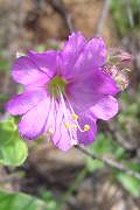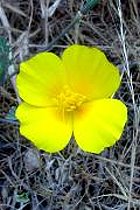- racemo'sa/racemo'sum: with flowers in racemes. Wikipedia says: "The Latin specific epithet racemosum means "with flowers that appear in racemes," which can cause confusion as the inflorescence is a panicle; it is the individual branches of the panicle that have flowers arranged in a raceme."
- raddia'na/raddia'nus: named for Giuseppe Raddi (1770-1829), an Italian botanist and curator at the Museum of Natural
 |
|
History of Florence, born in Florence into a poor family. He worked in a spicery where he became interested in medicinal plants. He was interested in the seedless plants and fungi that grew around Florence, and he learned Latin and other languages such as English, French and German, and began to read works on science and exploration. A mentor, Ottaviano Targioni Tozzetti, introduced him to Gaetano Savi (1769–1844), a future professor of botany at the University of Pisa, and the three men became lifelong friends. At the age of 15 he became an assistant to Attilio Zuccagni who took care |
of the botanical garden of Florence and later in 1795 he obtained employment as custodian in the Museum of Natural History of Florence. He published his first account of cryptogams in 1806, later reading his monographic account of the Jungermanniales to the Società Italiana di Scienze in 1817. Due to certain political positions he took against Napoleon he was unemployed from 1809 to 1814 but during this time he was helped by his close friend Giovanni Fabbroni, who employed him as his family’s administrator. His position was restored after Napoleon’s defeat and he was was subsequently supported by the Grand Duke of Tuscany, Ferdinand III, under whose patronage he traveled to Brazil (1817-1818) to collect natural history material. He studied the flora and fauna of the basins of the Orinoco and Amazon Rivers, forming a collection of plants and animals and naming several new species of reptiles endemic to Brazil, and published the first flora on the grasses of the Brazilian region in Agrostografia brasiliensis (1823). He collaborated with other botanists including A.P. de Candolle, Franz Wilhelm Sieber, Joseph Antoir, and Carl Bernhard Trinius. After Ferdinand III died in 1824, his son Leopold II of Tuscany continued the tradition of supporting scientific research and appointed Raddi to join the French Egyptologist Jean François Champollion along with the Italian Egyptologist Ippolito Rossellini. They departed Toulon in 1828 and proceeded to Alexandria, Cairo and then south along the Nile. He made extensive collections of plants, mammals, birds, reptiles, fish, molluscs and geological specimens. In June of 1829 Raddi began suffering from an intestinal infection and returned to Alexandria with the intent of returning to Italy, however he died of dysentery in September on the island of Rhodes where he was buried. His works include Crittogame Brasiliane (2 vols., Florence, 1822) and Plantarum Brasiliensium nova genera et species novae vel minus cognitae in which he described 156 new species of ferns and other plants (1825).
- ra'dians: radiating outward.
- radia'ta/radia'tum: spreading out like rays, usually the petals of
florets.
- rad'icans: with rooting stems, from the Latin radicor, “to take root.”
- radica'ta: having conspicuous roots.
- raduli'na/radulin'us: probably from the same root as radula,
"a scraper, rasp or file," and radere, "to scrape," from the scabrous leaves.
- Rafflesia'ceae: named for Sir Thomas Stamford Bingley Raffles (1781-1826), a British statesman, Lt-governor of
 |
|
the Dutch East Indies (1811–1816) and lieutenant-governor of Bencoolen (1818– 1824), best known for his founding of Singapore and British Malaya. He was born on the ship Ann off the coast of Port Morant, Jamaica. As a youth he attended a boarding school, and at the age of 14 began working as a clerk in London for the British East India Company, the trading company that shaped many of Britain's overseas conquests. He was sent to Prince of Wales Island, Malaya, in 1805 as an assistant secretary to the new governor of Penang on the northwest coast of peninsular Malaysia. |
Because he was skilled in the Malay language, he was sent to Malacca by the governor-general of India. In 1811 he conducted a successful military expedition against the Dutch and French in Java, Indonesia, and was appointed the lieutenant-governor of the Dutch East Indies. He also mounted an expedition against the local sultan in Sumatra to set up a permanent British presence there in the event that Java should return to Dutch rule. In 1814 he was devastated by the death of his wife Olivia Mariamne Devenish with whom he had no children. He was accused of poor financial management of the colony and there were allegations of financial impropriety on his part leading to his removal from office and his return to England in early 1816. While there he wrote and published The History of Java, relating the history of the island from ancient times as well as its geography, flora, and fauna. He was remarried in 1817 to Sophia Hull and in 1818 was appointed as the lieutenant-governor of Bencoolen, a locality in Sumatra. He became focused on the idea that despite the Dutch hegemony in the area, the British needed to establish a permanent presence there, amd in 1818 he sailed to the Riau Islands area south of what was then Singapura which resulted in years of negotiations and the eventual Anglo-Dutch Treaty of London of 1824. He established a post at the southern tip of the Malay Peninsula where there was no Dutch presence and officially declared the founding of Singapore in February, 1819, transferring control to the East India Company. The political situation between the English and the Dutch in the area caused much confusion and instability. Raffles’ intent was to break the Dutch monopoly on trade and create a gateway for trade with China and Japan, and his hope was to establish a British presence on the northern tip of Sumatra. In Singapore he set up schools and churches in the native languages, allowed missionaries and local businesses to flourish, and built carriage roads and constructed cantonments for the soldiers, then returned to Bencoolen. Unlike many other European adventurers, Raffles did not impose upon the colonized the alien language or culture of the colonizer. In addition to preserving the artifacts, fauna, and flora of his colonies, he also allowed religious freedom, which was especially important as the Malay states were largely Muslim. Christian schools were started by missionaries in all of his colonies. When the governor of Penang died, Raffles sought to extend his power and consolidate control over all the small British possessions in the East Indies. From 1820 to 1822 he was fully occupied by the administration of Bencoolen, and as in Java, he collected samples of local species of plants and animals. The production of food was a problem and he studied the agricultural methods of the Chinese. His expenditures on nature preservation were such that his removal from office was seriously considered. His eldest son Leopold died during an epidemic in 1821, and his youngest son Stamford died of dystentery in early 1822 with his daughter following only ten days later leaving only a single surviving child. Around this time his attention turned back to Singapore which he was pleased to see had grown enormously. He took direct control of the city, instituting a code of settlement for the populace, which was soon followed by laws regarding freedom of trade and a registration system for all land, regardless of ownership, mandating the repossession of the land by the government if land remained unregistered. He also drafted a series of administrative regulations for Singapore, which followed a fair and moralistic stance, outlawing gambling, imposing heavy taxation on what he considered social evils such as drunkenness and opium-smoking, and banned slavery. Believing things to be in good order there, he decided to return to England, stopping first in Batavia and Bencoolen. Tragedy struck once more when his youngest daughter, born in September 1823, died only a month later. Only 50 miles out of Bencoolen, the ship carrying Raffles and his family caught fire and was totally destroyed. All aboard were saved but his drawings and other papers were lost. The Anglo-Dutch Treaty of 1824 finally settled matters in the East Indies, with the British gaining dominance in the north, while the entirety of Sumatra became Dutch. The Malay Peninsula and the Indian subcontinent were both free of Dutch interference. With the Singapore matter settled, Raffles turned to his other great interests – botany and zoology. Raffles was a founder (in 1825) and first president (elected April 1826) of the Zoological Society of London and the London Zoo. Having been in ill health for some time, he died one day short of his 45th birthday of apoplexy, being survived by his wife Sophia and his daughter Ella. Thirty-three years after his death, Raffles's substantial collection of Indonesian antiquities and ethnography was donated to the British Museum by his nephew, Rev William Charles Raffles Flint.
- Rafines'quia: named for Constantine Samuel
Rafinesque-Schmaltz (1783-1840), a French botanist and friend of
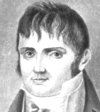 |
|
James J. Audubon. The following is quoted from Wikipedia online: "[Rafinesque was] a nine- teenth-century polymath who led
a chaotic life. Many would call him a genius, but also an eccentric,
sometimes close to insanity. He was very successful in various fields
of knowledge; a zoologist, botanist, malacologist, meteorologist, writer,
evolutionist, polyglot, translator. He wrote prolifically on such
diverse topics as anthropology, biology, geology, and linguistics;
but was honored in none during his lifetime. Today, it is generally
recognized that this genius was far |
ahead of his time. Rafinesque
was born in Galata, a suburb of Constantinople. He spent his youth
in Marseilles, France and was mostly self-educated. By the age of
twelve, he knew Latin and had built a herbarium. At the age of nineteen,
he went to America but in 1805 left again to Palermo, Sicily, where
he became a successful businessman, mostly in the trade of medicinal
plants. He was also secretary to the American consul. During his stay,
he collected flowers and took an interest in fish, naming a few. In
1815, after his common-law wife left him and his son (named for
Carl Linnaeus) had died, he returned to America. He lost all his
books (50 boxes) and all his specimens, with more than 60,000 shells,
when the ship foundered near the coast of Connecticut. In New York
he became a member of the newly established Lyceum of Natural
History. By 1818, he had collected and named more than 250 new
species of plants and animals. Slowly he was rebuilding his collection
of objects from nature. In 1819 he became professor of botany at Transylvania
University, Lexington (Kentucky), teaching French and Italian as well.
He started at once describing all the new species of plants and animals
he encountered. In 1825 his book Neogenyton, drew much criticism
from fellow botanists, causing his writing further to be ignored.
In the spring of 1826 he was dismissed from the university, for either
having an apparent affair with the university president's wife or
for attending even fewer classes than his students. He left for Philadelphia
without employment. He gave public lectures and started publishing
again, mostly at his own expense. His book Medical Flora, a
manual of the medical botany of the United States (1828-1830) became his most important work. In Herbarium rafinesquianum,
he described numerous new plants. He also became interested in the
collections of Lewis and Clark. Among them, he gave a scientific name
to the black-tailed prairie dog (Cynomys ludovicianus), the
white-footed mouse (Peromyscus leucopus) and the mule deer
(Odocoileus hemionus). In the books he published between 1836
and 1838 he proposed hundreds of new genera and thousands of new species.
However most of these names were not accepted by the scientific community.
He even discovered an unnamed bat in John J. Audubon's house no less.
He developed a theory of evolution much earlier than Darwin. In 1836
he also created a 19th century hoax, when claiming, in a document
'Walam Olum,' to be able to translate the writings of the
early Delaware Indians. He died of stomach cancer unnoticed and penniless
in an attic in Philadelphia. He was buried there at Ronaldson's cemetery.
His considerable collections were sold as junk or destroyed. In 1924
his remains (or what was thought to have been his remains) were brought
back to Transylvania University to rest in a place of honor, in a
tomb marked by the epitaph 'A life of travels'. But most likely, Rafinesque
lies in an unmarked grave in Philadelphia. In 1841 Thomas Nuttall
proposed, in his honor, the genus name Rafinesquia, (family
Asteraceae), with two species Rafinesquia californica (California plumeseed, California chicory) and Rafinesquia neomexicana (desert chicory, plumeseed). Rafinesque himself had proposed
this name several times, twice for a species in the Lamiaceae, and once each for species in the Bignoniaceae and the Fabaceae, but was each time turned down. His scientific work has been gaining more
and more recognition in recent years. He was an overly enthusiastic,
but accurate observer driven by a monomaniacal desire to name every
object he encountered in nature."
- raich'ei: named for Roger Raiche (1952- ), a California field botanist and horticulturist, and co-founder with David McCrory of Planet Horticulture Garden Design, a Bay Area landscape firm that emphasizes unusual plants in naturalistic and ecologically minded garden designs. His twenty-three-year career at the UC Botanical Garden (Berkeley) transformed the California collection. He collected extensively, discovered three species, and introduced many new native cultivars. He is also a fellow of the California Native Plant Society. In 1981 he first became fascinated with The Cedars, a little known serpentine canyon system in northwestern Sonoma County that had an other-worldly look and unusual and unique plants, and he has spent several decades exploring, documenting, and working with several conservation organizations attempting to secure preservation of this unique and fragile ecosystem. He wrote about it in a 2009 article in Fremontia.
- Raillardel'la: a diminutive of Raillardia, a shrubby genus
of Hawaii, hence a small Raillardia. FNA says it is an orthographic variant of generic name Railliardia which was published by George Bentham and Joseph Dalton Hooker in 1873.
- Raillar'dia: named for Laurent Raillard/Railliard (1792-1851), apparently a cutler born in Dax in southwestern France. He was a midshipman
then ensign on the scientific circumnavigation voyage of the vessels Uranie and Physicienne commanded by Louis de
Freycinet in 1817-1820. Raillard rose to at least the rank of Capitaine
de Corvette, or "Corvette Captain," the equivalent of a
Lieutenant Commander. Botanical collections were made by Charles Gaudichaud-Beaupré
and it's possible this is where Raillard began his interest in botany. Little appears to be known about this individual but he was a member in 1846 of the Conference of Saint Vincent de Paul, a Catholic charitable organization still in existence and now called the Society of Saint Vincent de Paul, that was founded in Paris in 1833 and honors the memory of Vincent de Paul (1581-1660), a priest who dedicated himself to serving the poor, studied at a college in Dax, and was sainted for two miracles. From 1843 to 1848 he was deputy mayor of Dax, and he was married to Marie Berlon. The genus Raillardia was published in 1831 by the German botanist and physician Kurt Polycarp Joachim Sprengel.
- Raillardiop'sis: like genus Raillardia, same derivation as
above.The genus Raillardiopsis was published by Per Axel Rydberg in 1927.
- Raimann'ia: named for Rudolf Raimann (1863-1896), an Austrian explorer and botanist who collected in Croatia and Austria, and was professor of botany and natural history in Vienna. He received a doctorate from the University of Vienna and worked as a volunteer in the department of botany at the Imperial Natural History Museum. For a period of time he taught classes in natural history at the Handelsakademie (School of Business and Commerce) in Vienna. He traveled through the Balkans, Central America and Mexico, documenting his findings. He was the author of Mittheilungen über Fichtenformen aus der Umgebung von Lunz (1888), Über unverholzte Elemente in der innersten Xylemzone der Dicotyledonen (1889), Ueber einige Krankheitserscheinungen der Nadelhölzer (1890), and made contributions in regards to the section on Onagraceae in Adolf Engler and Karl Anton Prantl's Die Natürlichen Pflanzenfamilien. He died at the early age of 33 but I have been unable to find out what caused his death. The genus Raimannia was published by Joseph Nelson Rose in 1913.
- rainbowen'sis: named for Rainbow, California, a census designated place in northern San Diego County with a population of around 1,800. The area, considered a gateway to the city of Temecula, was previously known as "Vallecitos." (little valley), but was renamed "Rainbow Valley" in the late 1880s, after Mr. James Peebles Marshall Rainbow (?-1907), who came from his native Pennsylvania in 1875 and bought a homestead there. He began growing fruit and was said to be the person who shipped the first carload of fruit that ever shipped from San Diego County, a shipment that consisted of muscat grapes grown upon his twenty-acre ranch near Fallbrook. He was elected to the county board of supervisors for two terms, from 1882 to 1884 and again from 1891 to 1895. He died at the agre of 71.
- ralphia'na: named for Ralph Hopping (1868-1941), an American-born Canadian entomologist who specialized in Coleoptera (beetles and weevils). Wikipedia says he was born in New York City and studied and collected insects from an early age. He moved with his father to California in 1891. In 1905 he entered the United States Forest Service. In 1912, he held the post of forest entomologist, and was based in San Francisco. In 1919 he accepted the post of entomologist-in-charge at the Vernon Laboratory in British Columbia, Canada. He remained at Vernon until retiring in 1939, with the title of senior agricultural scientist. He was a member of several learned societies, including the California Academy of Sciences (from 1913), the Pacific Coast Entomological Society, and the Entomological Society of British Columbia. He collected and described numerous species of beetles. He directed his energies not simply towards scientific inquiry, but especially towards control of bark beetles, a notorious pest in the Canadian forestry industry, and a pest that has caused considerable damage in California. In 1948 his widow, Eltha Edwards, donated his beetle collection to the entomology department of the California Academy of Sciences. His son, G. R. Hopping, was also an entomologist.
- ralph'ii: named for Thomas Shearman Ralph (1813-1891), an English surgeon, botanist and microscopist mainly devoted to the exotic flora of the Melbourne region. He was born at Arrungabad in India, where his father was government resident. The following is quoted from a biographical sketch by Val Smith in the March 2009 Newsletter of the New Zealand Botanical Society: “He gained his MRCS [Member of the Royal College of Surgeons] England (1836) and LSA [Associate of the Linnean Society] (1840), and for ten years was surgeon to the West London Lying-In Institution, and to the Dorcas Society, Long Acre, London. In 1842 he was elected an associate of the Linnean Society of London; his membership record notes that he had a considerable collection of East Indian plants, and that some of his New Zealand plants were at Kew Gardens. His early scientific writing includes two manuscripts on the structure of plants (1846) held by the Linnean Society, and Elementary Botany for the use of beginners, first published in London in 1849. Dr Ralph practiced medicine and became an active member of the scientific community. He joined and became secretary of the newly formed but short-lived New Zealand Society, forerunner of the New Zealand Institute [later to become the Royal Society of New Zealand], and read to members his paper on the pecularities of Nitella. He gave lectures on a wide range of scientific topics, his papers on the spider katipo (1856) and the tree ferns of New Zealand (1858) were published in Journals of the Linnean Society, and a plant he collected in the Patea area became the type specimen of Pittosporum ralphii. When requested, he assessed rock samples for traces of gold. He was also one of the first lithographers and etchers to work in New Zealand; his work in this field included illustrations for Maori versions of Robinson Crusoe (1852) and Pilgrim’s Progress (1854), a plan of Wellington and landscapes of early Wellington City. In early 1853 Dr Ralph went to Melbourne, and was away for five months. In May 1857 he gave notice that he was about to leave the colony, but it is unknown when he actually left. He returned to Melbourne, to live at South Yarra, Carlton, and for more than twenty years at Kew, now an affluent suburb of Melbourne. In 1859 he joined the Philosophical Institute of Victoria (which became the Royal Society of Victoria), and was a member for around 30 years. An ardent microscopist, he founded and was first president of the Microscopical Society of Victoria and was curator of the pathological collection at the Royal Melbourne Hospital, resigning to return to medicine as surgeon at the Royal Women’s Hospital in Melbourne. His Elementary botany was re-published in Melbourne in 1862, and several papers on medical topics and on aspects of botanical anatomy – mainly of exotic plants –were published in the Proceedings of the Royal Society of Victoria.” With his friend and fellow botanical enthusiast William Pamplin, he made a botanical tour of North Wales in 1856. He died at his stepson’s home in Carlton at the age of 79.
- Ramisch'ia: named for Franz Xavier Ramisch (1798-1859), a Bohemian botanist, physician and professor of medicine in Prague. The Harvard University Herbaria website of botanists and some other sources list his middle name as Xaver. The genus Ramischia was published by Philipp Maximilian Opiz in 1858.
- ram'mii: named for Charles Adolph Ramm (1863-1951). The following is
quoted from the San Francisco Chronicle: "Charles A. Ramm, medalist
of the State University in 1884, has gone to Baltimore to study for
the priesthood in the Roman Catholic Church. He was born of German
Lutheran parentage. He was educated as a civil engineer, for which
profession he evinced a decided talent, taking a degree from the College
of Civil Engineering. As a student at Berkeley he was a fast friend
of the Rev. Edward L. Greene, Rector of St. Mark's Episcopal Church,
of which he was a faithful attendant. Upon graduation he did not follow
his profession, but was appointed recorder of the university. On Easter,
1886, in company with Rev. Mr. Greene, whose difficulties with his
parish have been aired in the courts and public prints, Mr. Ramm was
baptized at St. Mary's Cathedral. Mr. Greene, who is now assistant
professor of botany in the State University, it is stated, is also
preparing for the Roman Catholic priesthood. Mr. Ramm will enter the
theological seminary of St. Sulpice." And from American Catholic
Who's Who: "Ramm, Rev. Charles A., secretary to Archbishop Riordan
of San Francisco, California; born in Camptonville, California, 1863;
attended the public schools and Berkeley Gymnasium, the University
of California and Johns Hopkins University; received the degree of
PhB [Bachelor of Philosophy] from the University of California,
1884; MA (1889) and STB [Bachelor of Sacred Theology] (1891)
from St. Mary's Seminary; LLD (honorary) from the University of
Nevada, 1908; appointed a member of the State Board of Charities and
Corrections in 1906. Is much in demand as a lecturer. His lecture,
"Why I Became a Catholic," was published by the Catholic
Truth Association. Entered the Catholic Church 1886." David Hollombe adds: "Ramm was a regent of the University of
California, 1912-1944. He was ordained in 1892, elevated to papal
chamberlain in 1918, and elevated to domestic prelate in 1919."
- ramond'ii: named for Louis Francois Elisabeth Ramond de Carbonniere (1753-1827), a French politician, geologist
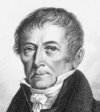 |
|
and botanist regarded as one of the first explorers of the high mountains of the Pyrenees. He was born in Strasbourg and studied law at the university there, becoming a lawyer in 1777. He became interested in German romantic literature and decided to be a writer, publishing Les Dernières aventures du jeune d’Olban (The Last Adventures of Young Olban). He soon was exposed to intellectual society in Switzerland where he met other writers and poets, theologians, and zoologists, and developed a passion for the high mountains. He settled in Paris with his father in |
1779 and continued to write and publish although his work did not receive the recognition he sought. Moving back to Strasbourg, he placed himself at the service of cardinal Louis René Édouard de Rohan, prince of Rohan-Guemenée and cardinal-archbishop of Strasbourg, traveling widely and meeting many significant personalities of the day. Staying one summer in the Pyrenees, he began exploring the geology of the nearby mountains, a subject that would interest him for the remainder of his life. Following this he again settled in Paris where he followed the courses of Antoine de Jussieu and René Desfontaines in the Jardin des Plantes and published Observations Made in the Pyrenees, To follow some Observations of the Alps. He was elected a deputy of Paris in 1791 but because of his Jacobite persuasions he felt his life to be in danger and fled Paris for the relative safety of the Pyrenees and the town of Barèges where he botanized and mountaineered. Politics followed him however and he was arrested in 1794, accused of being an enemy of the revolution, imprisoned for seven months, and narrowly escaped the guillotine. Natural history was his main focus from 1796 onwards and he taught as a professor of natural history at the Central School of Tarbes and became a specialist in the botany and geology of the central Pyrenees. After two unsuccessful attempts in 1797, he finally reached the top of Mt. Perdido in 1802. After the Central School of Tarbes closed, he returned to Paris as a member of the Constitutional Council, where until 1806 he worked with the parliament and took part in the work of the Société des observateurs de l'homme. He became a member of the French Academy of Sciences in January, 1802. Despite being made vice-president of the Corps législatif, and then in 1806 prefect of Puy-de Dôme, he spent more time botanizing and making weather measurements. In 1815 he published Stratification of the Monts Dorés and the Monts Dômes, was elected to the Conseil d'État in 1818, and published in 1825 On the Condition of the Vegetation on the Summit of the Pic du Midi. He died in 1827 and was buried in the cemetary of Montmartre. In 1894 he was honored with the genus name Ramonda by Louis Claude Marie Richard.
- ramo'sa/ramo'sus: branched, from Latin ramus, "branch."
- ramo'sior: from the Latin ramus, "a branch," and the -ior suffix indicating "more," thus "more branched."
- ramosis'sima/ramosis'simum/ramosis'simus:
very branched.
- ramulo'sa: Harris and Harris's Plant Identification Terminology says that 'ramulose' is the same as 'ramose,' that is, "with
many branches," and Jaeger gives the derivation as from ramulosus,
"full of branches." However, with other words such as 'strigulosa,'
'lanulosa,' 'spinulosa' and 'tomentulosa,' the suffix -ulosa has a
sense of "slightly or minutely," so perhaps this would more
correctly mean "slightly branched." On the other hand, people
apply names and use forms of names with different things in mind,
so this is not certain.
- ransom'ii: named for Colonel Leander Ransom (1800-1872). The following is quoted from the Mount Diablo Survey-
 |
|
ors Historical Society: "Ransom, who was born on September 5, 1800, in Colchester, Connecticut, moved with his parents when he was young to New York State where he was educated. In 1825 he went to Ohio where he was married and had three children. He evidently liked California and brought his family to live there in 1856 where they settled in San Francisco. Early in his career, Ransom was employed by the Ohio Canal Company. In 1826 he was appointed to locate a portion of the Ohio Canal. Later he was appointed as commissioner to the Ohio Canal Commission. In |
1836 he was appointed as president of the Board of Public Works of Ohio, a position he held for 13 years. Colonel Leander Ransom came to California in 1851 with Samuel D. King, who was the US Surveyor General for California. King and Ransom left New York by steamer for California in May of 1851. They left their ship and crossed the Isthmus of Panama overland where one of their equipment trunks was stolen. They also lost the keys to the safes and two boxes of papers fell overboard and suffered damage. They bordered another steamer and continued their trip to San Francisco. They landed in San Francisco on June 14, 1851 and set up offices there. On July 8, 1851 King issued special instructions to Ransom for the establishment of the initial point on Mount Diablo and the initial surveys of the meridian and base line. King charged Ransom to 'Go to Mount Diablo and provide that an east and west base and north and south meridian line be run and established passing through the most prominent peak of Mount Diablo.' From July 1851 to September 1851, Ransom conducted the first public land survey in California as deputy surveyor. The Mount Diablo principal meridian and base line extending from the Mount Diablo initial point, established on July 17, 1851 by Ransom, controls public land surveys within two-thirds of California and all of Nevada. In August of 1852, King ordered Ransom to examine the southern California region of San Bernardino Mountain to see if it would be feasible to establish an initial point on its summit. Ransom reported to King that it would be possible. In September of 1852, King issued instructions to Henry Washington, deputy surveyor, to establish the San Bernardino initial point. After completing these tasks, Ransom served as chief clerk in the California Surveyor General's Office in San Francisco from 1851 to the 1860s. In 1853 Ransom became a charter member of the California Academy of Sciences. In addition, he was an early and active member of the Academy, serving as president for eleven terms beginning in 1856. Ransom died on May 14, 1874, as the result of an accident. In 1916, the Native Sons of the Golden West dedicated a bronze plaque near the summit of Mount Diablo in the memory of Leander Ransom. On October 24, 1926, the American Society of Engineers of San Francisco dedicated a mountain spur to the memory of Ransom. The spur is shown on the quadrangle map as Ransom Point.” He found the oak on the highest mountains near Tejon Pass. (Photo credit: Mount Diablo Surveyors Historical Society)
- rantonnet'tii: named for Barthélémy Victor Rantonnet (1797-1871), a gardener, horticulturalist and French nurseryman. He was a pioneer in the acclimatisation of plants on the Côte d'Azur along the Mediterranean coastline of the southeast corner of France, and worked in the garden that Jean-Baptiste Fihle de Sainte-Anne had created in Hyères. He became interested in the acclimatization of plants, and transformed the garden into a commercial plant nursery, named "Jardin Filhe" in honor of its former proprietor. He published, among other things, Jardin d'acclimatation, Catalogue des végétaux exotiques.
- ranuncula'cea: resembling a Ranunculus
- ranunculo'ides: like genus Ranunculus.
- Ranun'culus: from the Latin rana,
"little frog," because many species tend to grow in moist
places. The genus Ranunculus was published by Carl Linnaeus in 1753.
- ra'pa: an old Italian name for turnips. Wikipedia says this: "Brassica rapa is a plant species growing in various widely cultivated forms including the turnip (a root vegetable); Komatsuna [Japanese mustard spinach], napa cabbage, bomdong [spring cabbage], bok choy, and rapini [broccoli rabe]. The origin of B. rapa, both geographically and any surviving wild relatives, has been difficult to identify because it has been developed by humans into many types of vegetables, is now found in most parts of the world, and has returned to the wild many times as a feral plant. A study of genetic sequences from over 400 domesticated and feral B. rapa individuals, along with environmental modelling, has provided more information about the complex history. These indicate that the ancestral B. rapa probably originated 4,000 to 6,000 years ago in the Hindu Kush area of Central Asia, and had three sets of chromosomes. This provided the genetic potential for a diversity of form, flavour and growth requirements. Domestication has produced modern vegetables and oil-seed crops, all with two sets of chromosomes. In the 18th century, the turnip and the oilseed-producing variants were seen as being different species by Carl Linnaeus who named them B. rapa and B. campestris. Twentieth-century taxonomists found that the plants were cross fertile and thus belonged to the same species. Since the turnip had been named first by Linnaeus, the name Brassica rapa was adopted."
- rapa'ceus: relating somehow to turnips, according to Stearn. Rape or rapeseed is a common name for Brassica napus subsp. napus.The Grammatical Dictionary of Botanical Latin website from the Missouri Botanical Garden says that rapaceus means "having the form of a long radish."
- raphanis'trum: like a wild Raphanus.
- Raph'anus: from the Greek raphanos for "quick-appearing" because of the rapid germination of
the seeds. The genus Raphanus was published by Carl Linnaeus in 1753.
- Rapis'trum: FNA and the Jepson eflora say this derives from Latin rapa, "turnip," and -astrum, "incomplete resemblance." The genus Rapistrum was published by Heinrich Johann Nepomuk von Crantz in 1769.
- rapp'ii: named for Frederick William Rapp (1879-1975), a lifelong amateur botanist. The following is quoted from an
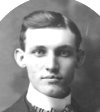 |
|
entry on the Vicksburg Historical Society website: “Fred Rapp, born in 1879 and a life-long resident of the Vicksburg area, was an ardent and enthusiastic naturalist who contributed significantly to the understanding of the flora and ornithology of the Kalamazoo-Vicksburg sector of southwestern Michigan. By trade he was a farmhand, carpenter, restaurateur and storekeeper, but all of his spare time was devoted to his hobbies of botany and ornithology. Influenced greatly by both his father and grandmother, Fred Rapp's interest in plants and birds began early in grade |
school. Though his formal education ended with ninth grade, he pursued his botanical interest to an extent which in later years made him an authority on the plants of the Vicksburg area. He amassed a collection of approximately 16,000 specimens, most of which were collected within a six-mile radius of his hometown.Some specimens were rare or unusual to the area, including the lotus Nelumbo lutea. He was the discoverer of several species of Rubus, the genus name of the rose family, which had never been found before in Michigan. One such example, Rubus rappi, was named partly in his honor. Rapp's interest was not limited to collecting plants. He accumulated a bird skin collection of 100 different species found in the Vicksburg area, and taught himself how to mount them. In 1931 he published "A Bird List of Vicksburg, Michigan" consisting of 204 species of birds found within a six-mile radius of Vicksburg. In 1966 he published a supplement to his bird list which added another 25 birds. In 1961 he was awarded a citation by the US Fisheries and Wildlife Service for serving 66 years as a bird observer and 48 years for both observing and banding migratory birds. In 1967 he donated his plant collection to Western Michigan University. His collection of approximately 30 mounted bird species and 400 sets of bird eggs were given to the Kalamazoo Nature Center. Fred Rapp's interest in nature never wavered and he continued collecting plants and bird watching until 1971 when he was confined to a nursing home. He died in 1975 at the age of 96." (Photo credit: Vicksburg Historical Society)
- rariflor'um: with scattered flowers. An Australian etymmological website says: "From Latin, rare, far apart or sparsely, and flos, a flower, referring to the sparse flowering habit." The taxon in California is Heterocodon rariflorum, which species at occasions along the stem produce the flowers which emerge from a base of toothed or spiny leaflike sepals a few millimeters long."
- Rati'bida: a name used by C.S. Rafinesque. Stearn says meaning obscure and FNA says derivation unknown. The Jepson herbarium page gives this: "Dacian name for a sp. of Aster." The Dacians were the ancient Indo-European inhabitants of the cultural region of Dacia, located in the area near the Carpathian Mountains and west of the Black Sea. They are often considered a subgroup of the Thracians. This area includes mainly the present-day countries of Romania and Moldova, as well as parts of Ukraine, Eastern Serbia, Northern Bulgaria, Slovakia, Hungary and Southern Poland. David Hollombe sent me
the following: "Rafinesque's brief description in a paper in
'Journal de physique, de chimie et d'histoire naturelle et des arts'
in 1819 mentions the rays as being bifid, although that explanation
does not account for the 't'." Rafinesque often assigned unexplained
names to plants. It is curious that dozens of online sites use the
spelling Ratidiba rather than Ratibida. The genus Ratibida was published by Rafinesque in 1817.
- rattan'ii: named for Volney Rattan (1840-1915), a botanist, plant collector
and schoolteacher at the State Normal
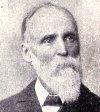 |
|
School in San Jose, California,
author of A Popular California Flora (1882), Flora Franciscana (1891-1897) and West Coast Botany: an analytical key to the flora
of the Pacific Coast (1898). A website of the State Normal School gives the following thumbnail sketch: "Native
of Wisconsin. Educated in public schools and State University of Wisconsin.
Taught in public schools of Wisconsin, two years; country schools
in California, five years; San José Institute, two years; Oakland
Military Academy, three years; Principal of Santa Cruz schools, one
and a half years; |
teacher of natural science in Girls' High School,
San Francisco, thirteen years; teacher in Normal School since January,
1889. Specialties, botany and geography. Married September, 1872.
Two children." He was born in Monroe, Wisconsin, and in 1861 took the Overland Trail to California, settling first at Placerville. In 1879 Rattan published the first edition of a book designed to help his students, and others, to learn to identify California plants. The second edition, in 1880, contained many of his own illustrations of plant morphology and taxonomic terms. Subsequent revised and enlarged editions appeared through 1905. Willis Linn Jepson, preeminent California botanist, wrote of Rattan (in the first of Jepson's essay series on The Botanical Explorers of California): “It can well be said that in those early days he did more for botanical teaching in the public schools and for wide diffusion of interest in the native flora amongst the people of California than any other man. His "Popular California Flora" was well suited to its purpose and it has given to thousands of Californians a pleasure in the fields and forests which they associate with their earliest experience of wild life. In some ways a matter of fact and practical book, yet it had an engaging interest and even charm, due mainly to the many excellent old-time wood engravings made after Volney Rattan's own drawings.” It has been suggested that Jepson, as a high school student, had one of Rattan's books as his first book on plants. Rattan died March 5, 1915 and was buried in Oakland.
- rau'i: named for Eugene Abraham Rau (1848-1932), a bryologist and pharmacist of Bethlehem, Pennsylvania, and
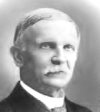 |
|
co-author with A.B. Hervey of Catalog of North American Musci. His father was the first and leading druggist in Bethlehem and served as a councilman and as treasurer of a number of societies. A website of the Hopkin Thomas Project, a historical research project concerning the activities of a Welsh engineer who emigrated to America in 1834, has this to say: “Eugene A. Rau was educated in the Moravian Parochial School, early became associated with his honored father, and after graduation from the Philadelphia College of Pharmacy became his partner, and after a connection |
of forty-eight years, retired, April 1, 1913. While the drug business has been the principal work of his life and all else was subordinated to it for so many years, Mr. Rau has acquired other interests, and he is a learned botanist, well known for his work in connection with the flora of Northampton County. He is a member of a number of scientific societies, including the American Association for the Advancement of Sciences, the New York Academy of Sciences, the Torrey Botanical Club, Philadelphia Academy of Natural Sciences, and the Sullivant Moss Society. He is secretary of the board of trustees of the Moravian Seminary and the College for Women, also treasurer of the Alumni Association Endowment Fund of that institution, a vice-president of the Free Library of Bethlehem, a member of the Bethlehem Chamber of Commerce, a member of the Moravian Historical Society and of the Northampton County Historical Society, treasurer of one of the Moravian church societies, and also treasurer of the Bethlehem branch of the Dickens fellowship. He is also a leading member of the Moravian church.” He became an authority on mosses and fungi, assembling large collections which mostly went to the American Museum of Natural History in New York. Elected a correspondent of this Academy in 1883, he bequeathed a collection of books to it (mostly from the Lewis David von Schweinitz library) and an herbarium of flowering plants. He corresponded with George Engelmann. He was born and died in Bethlehem. The genus Rauiella was named for him. (Photo credit: Find-a-Grave)
- ravaud'ii: named for Abbé Louis-Célestin Mure-Ravaud (1822-1898), a parish priest of Villard-de-Lans, plant collector in France and Vietnam, author of Mousses, Hépatiques Et Lichens De L'arrondissement De Grenoble Et Des Montagnes Qui L'avoisnent published in 1860 and a botanist recognized throughout Europe. He traveled extensively around the Dauphiné, a former province in southeastern France. He mainly explored the surroundings of Grenoble and the massifs of the region: Belledonne, Chartreuse, Oisans, etc. He published the result of his botanizing in thirteen pamphlets published between 1881 and 1894 in the Bibliothèque du Touriste en Dauphine, under the generic title of Guide du botaniste en Dauphine, each of which is the description of an excursion. By the time of the end of his thirteenth excursion he was 72 years old and he was finished with botanizing.
- Ravenel'la/raven'ii: named for Peter Hamilton Raven (1936- ), a leading botanist and environomentalist, an advocate
 |
|
for the preservation of biodiversity and the global ecosystem, president emeritus of the Missouri Botanical Garden and director for the past 30 years, president of the American Association for the Advancement of Science, Engelmann professor of botany at Washington University, co-editor of Flora of China, a joint Chinese-American project to describe all the plants of China, author of Origin and Relationships of the California Flora with Daniel Axelrod, Biology of Plants with Ray Evert and Susan Eichhorn, Native Shrubs of Southern California, and Flora of the Santa Monica |
Mountains with Henry Thompson and Barry Prigge. He has also written many scientific and popular articles, especially on the family Onagraceae, and is well-known for his Butterflies and Plants: A Study in Coevolution, co-authored with Paul Ehrlich. Raven is typical of contemporary botanists who spend more time in laboratories and boardrooms than in the field, but his ambitious goal is to try to save some of the hundreds of thousands of plant species that he believes will disappear because of habitat loss. Raven was born in Shanghai, China to American parents. The jailing of his uncle and Japanese aggression against China caused the family to move back to the US in the late 1930s. He graduated with a BSc in biology from UC Berkeley in 1957 and a PhD in botany from UCLA in 1960. He taught at Stanford and while there he and Paul Ehrlich coined the term coevolution to describe the process by which plants and their pollinators evolve in tandem, each developing traits and characteristics that allow them to utilize and benefit from the traits and characteristics of the other. He then became director of the Missouri Botanical Garden in 1971. The great significance of Peter Raven’s life work has been not to describe particular species or genera, but to study and analyze the evolution of plants and their relationships with pollinators, predators, and fungi, the hybridization of plants, endemism, and the biogeography of plants, in other words, the big picture of plants on earth. He has made immeasurable contributions to our understanding of the plant kingdom. Few other American botanists have been able to relate in such a knowledgeable fashion the flora of California and North America with that of other parts of the world. The genus Ravenella was published in 2020 by Nancy Ruth Morin.
- raven'nae: named for the city of Ravenna, Italy, which once served as the seat
of the Roman Empire. The taxon in California with this epithet is Saccarum ravennae commonly called ravenna grass which is native to Southern Europe, Western Asia and South Asia.
- rawsonia'na/rawsonia'nus: named for Lucy Adeline Briggs (Mrs. James Cole, Mrs. Julius Addison Rawson, Mrs. Thadeus Edgar Peckinpah, Mrs. James Knight Smallman) (1840-1920), an artist who lived in California and was known for her botanical studies, landscapes and portraits. Lucy was born in Middleboro, Massachusetts, 25 August, 1840. She married James Cole at New Bedford, Massachusetts, 6 March, 1860, Julius Addison Rawson (1825-1877) at San Francisco, 17 November, 1863, Thadeus Edgar Peckinpah (1849-1908), a native of Indiana, at San Francisco in 1886, and James Knight Smallman (1844-1934) at Napa, California, 7 April 1912. Her only child died from a congenital heart defect at age three days on 24 Oct. 1877 and her then husband, J.A. Rawson, died of pneumonia eight days later. Lucy Briggs was born in Middleboro, Plymouth County, Massachusetts and was a lineal descendent of Miles Standish. She was an artist of some note in the Bay area and around Napa, and taught painting at Lynch’s Academy in Benicia. As a student of nature, she made a deep study of botany. She made a collection of paintings of California wildflowers that numbered over 300. She also took a great interest in photography. She discovered several new varieties that bear her name.
- raynolds'ii: named for mapmaker William Frank Raynolds (1820-1894), an explorer, engineer and Army officer
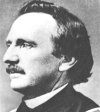 |
|
whose career was spent in the topographic section of the US Army Corps of Engineers and who explored the headwaters of the Missouri and Yellowstone Rivers with Jim Bridger in 1859-1860, mapping the country and collecting fossils. He was born in Canton, Ohio, and entered West Point in 1839 at the age of 19, graduating with the class of 1843 along with Ulysses S. Grant. He almost immediately was assigned to the US Army Corps of Topographical Engineers. Among his first tasks was improving navigation on the Ohio River and surveying the northeastern boundary of the |
US. He served under Winfield Scott in the Mexican-American War. When the war ended, and American forces were occupying Mexican territory, Raynolds and others set out to map and explore nearby mountains. Raynolds's party is credited with being the first confirmed to climb to the summit of Pico de Orizaba which at 18,620 feet is the tallest mountain in Mexico and third tallest in North America. Raynold’s successful ascent was disputed by the Mexicans until an 1851 French expedition discovered an American flag on the summit with the year 1848 carved in the flagpole. After resuming his survey of the northern border, he spent almost a decade checking out potential lighthouse locations along the shores of the Great Lakes and then along the Jersey coast and the Delmarva Peninsula. In 1859 he led an expedition along with Jim Bridger into the Yellowstone region of Montana and Wyoming, studying and mapping that area and assessing the navigability of rivers and tributaries, agricultural and mineral resources, and contacting native tribes. Because of his participation in the Civil War and a severe illness, research data and botanical specimens, as well as fossils and geological items that had been collected during the expedition, were sent to the Smithsonian Institution, but they and his report were not studied in detail until after the war. He was directly involved in a variety of capacities throughout the war, and afterwards supervised dredging and river navigability improvement projects on the Arkansas, Mississippi and Missouri Rivers, harbor dredging and construction projects. and extensive lighthouse building construction projects. He retired in 1844 after a 40-year military career, maintained good health and died in 1894, being interred in the town of his birth.
- Razoumof'skya: named for Count Alexei Kirillovich Razumovsky (1748-1822), a minister of education (or public
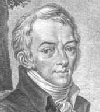 |
|
instruction) of the Russian Empire from 1810–1816. In an essay by Stephen Jay Gould in his book Dinosaur in a Haystack, he describes Alexei’s younger brother Andrei as a significant and cultured diplomat, ambassador to Vienna, and major patron of the arts who knew Mozart and Beethoven, and goes on to say: “The older son – Alexei Kirillovich – lacked nearly all of his brother’s admirable characteristics. Standard sources (not only the Soviet Encyclopedia, which might be accused of bias, but others likely to be both more objective and sympathetic) describe him as |
indolent, dyspeptic, litiginous, domineering, and generally miserable. He married the richest heiress in Russia, but sent her packing several years later, after draining most of her wealth. Of his two sons, one was wildly dissolute and the other floridly mad… Razumovsky hated court life and largely sought to avoid responsibilities. But he did love botany and natural history, and he established, at his estate in Gorenski near Moscow, a wonderful botanical garden (specializing in alpine plants) and the most extensive collection of books on natural history in Russia. Nevertheless, Razumovsky rarely used those resources to benefit either science or the public.” For a time he was a trustee of Moscow University and patronized the Society of Naturalists. During his first couple of years as minister of public instruction some advances were made, 72 parochial schools and 24 county schools were opened, teaching was improved in some high schools and other educational institutions, and several scientific societies were begun along with the first department of Slavic literature at Moscow University. His enthusiasm for the job waned rather quickly however and it is unclear what further contributions he made to Russian society. The genus Razoumofskya was published by George Franz Hoffmann in 1808. (Photo credit: ResearchGate)
- read'eri: named for Felix Maximilian Franz Reader (1850-1911), a German pharmaceutical chemist and collector of plants in New Zealand and Australia for Baron Ferdinand von Mueller. His original name may have been Raeder or von Reyder. Most info about him is obscure and open to question. He has often been confused with an Edward Reader who also collected plants in Australia for the Baron but was considerably older, born probably around 1820, and was supposedly English not German. In 1880 there was an event called the Bermagui muders where five men disappeared, apparently murdered, the crime never solved, and Felix Reader’s name has been associated with this, although it’s more than likely that Edward Reader should have been the one to be a suspect since he was nearby at the time and unaccountably left the area the day after the murders. The following information, which may or may not be completely accurate, is taken from a biography of Felix Reader compiled by an officer of the Melbourne Herbarium from his youngest son Aubrey Reader’s recollections of his father: He was born in Berlin and as a young Lieutenant in the artillery he fought and was wounded in the Franco-Prussian War. He was trained first as a medical man and possibly gained a doctorate. He was able to speak French, English and Italian in addition to his native German. He left Germany sometime in the mid-1870s for New Zealand and apparently never contacted his parents or other relatives again, saying little to his children about his former life. He trained there as a pharmacist, his foreign medical qualifications not being recognized, and practiced pharmacy in the Blenheim district. Having a natural interest in plants, he began collecting and forming a private herbarium as early as 1879. He apparently made no excursions into the Southern Alps or the South Island. He was married and had his first three children in New Zealand. In 1882 or 1883 he went to Melbourne, Australia and gained employment at a pharmacy or dispensary there, and continued collecting plants along the Yarra River. The last two of his children were born in Victoria where he was elected in 1884 a member of the Field Naturalists Club of Victoria. By this time he had become acquainted somehow with Baron von Mueller and they remained associates until the Baron’s death in 1896. He took up residence at Dimboola in western Victoria as a pharmaceutical chemist in 1888 and remained there for 16 years. He made extensive collections in the Wimmera and Little Desert area, and sent many moss specimens to the German authority Carl Muller. Following Muller’s death he corresponded with Victor erdinand Brotherus in Finland. Baron von Mueller visited him in Dimboola on at least one occasion. He explored Mt. Arapiles on at least eight occasions, being accompanied once by his son Aubrey. In 1903 he moved his business from Dimboola to Warracknabeal and continued botanizing along Yarrambiack Creek. In 1906 he moved again to Casterton in 1906 and then to Newstead in 1909. He sold his private herbarium to the National Herbarium of Victoria in 1906, and then 17 volumes of books and pamphlets. He only spent 18 months at Newstead, continuing to collect, then his health declining he returned to Dimboola late in 1910 or early 1911 where he died on March 24. He had apparently also maintained a large insect collection the whereabouts or even existence of which is not currently known. He had been a careful collector and labelled and mounted everything neatly, and his collection was a significant addition to the National Herbarium. He published many papers in the Victorian Naturalist and became an expert on the grasses of the southern Wimmera region.
- rebman'ii: named for San Diego County botanist and plant taxonomist Jon Paul Rebman (1965- ), who has conducted extensive floristic research in Baja California and in San Diego and Imperial Counties. A Spotify website provides this: "Originally from rural Illinois, Rebman landed a Fulbright Fellowship that took him to study in Ensenada. During his year south of the border, Rebman traveled the peninsula cataloging cholla cacti with his fellow students and the Universidad Autonoma de Baja California facility. He credits this formative experience for igniting his passion for the region's rara endemic flora. Rebman earned a doctorate from Arizona State University and wrote his dissertation on the Cylindropuntia cactus family of Baja California." He has over 15 years of experience in the floristics of San Diego and Imperial Counties and 21 years experience studying the plants of the Baja California peninsula. He is the co-author of Checklist of the Vascular Plants of San Diego County with Michael Simpson and Baja California Plant Field Guide with Norman Roberts, and is working on Ferns and Lycophytes of San Diego County with Annette Winner. He became curator of botany at the San Diego Natural History Museum in 1996, and organized the Second Baja California Botanical Symposium shortly after his arrival. The following year he organized the Lindblad Binational Multidisciplinary Expedition to the Sierra San Francisco and the Sierra Guadalupe. Dr. Rebman is currently overseeing the creation of a County of San Diego Plant Atlas.
- Reboul'ea/Reboul'ia: named for Germaine Eugene Hyacinthe Reboul (1773-1851). Many websites refer to him as an Italian botanist, but one described him as a French gentleman residing in Florence. I don't know which is correct, but the name seems more French than Italian. He was born in Aix en Provence, France, and died in Florence, so perhaps there is truth in both. The genus Reboulea was published by Karl Sigismund Kunth in 1830 and the genus Reboulia was published by Giuseppe Raddi in 1818.
- rec'ta: see rectum/rectus below.
- rectispi'na: with erect or ascending spines.
- rectis'sima: very upright.
- rec'tum/rec'tus: straight, upright, erect, from Latin rectus, "straight."
- recurva'ta/recurva'tum: curved backwards.
- recurvifo'lius: with recurved leaves.
- recur'vus: bent over and downwards.
- reddingia'num: named for Benjamin Barnard Redding (1824-1882), sometimes
spelled Reltding. The following is
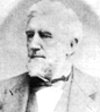 |
|
quoted from an entry on Redding
in the online Virtual
American Biographies: "Redding, Benjamin Barnard, pioneer,
born in Yarmouth, Nova Scotia, 17 January, 1824; died in San Francisco,
California, 21 August, 1882. He was educated at Yarmouth Academy,
and in 1840 went to Boston, where he became a clerk and afterward
entered the grocery and ship-chandlery business. In 1849 he organized
a company of men who sailed from Yarmouth for California, where they
arrived on 12 May, 1850. He went to the Yuba River diggings, and afterward
to the Pittsburg bar, working as a |
laborer. Subsequently he was employed
in drawing papers for the sale of claims, acted as arbitrator, was
elected a member of the assembly from Yuba and Sierra counties, and
during the session wrote for the San Joaquin Republican and
the Sacramento Democratic State Journal, of which he was an
editor and proprietor. In 1856 he was mayor of Sacramento, and from
1863 till 1867 he was secretary of state. From 1864 until his death
he was land agent of the Central Pacific railroad. Mr. Redding was
a regent of the University of California, and a member of the California
Academy of Sciences, and of the Geographical Society of the Pacific.
He was also a state fish commissioner, holding this office at the
time of his death. He was interested in all scientific work, especially
in the paleontology of the coast, and collected numerous prehistoric
and aboriginal relics, which he presented to the museum of the academy.
He contributed a large number of papers to various California journals."
(Photo credit: Geni)
- redivi'va/redivi'vus:
from Latin redivivus, "restored, brought back to life," sometimes applied to rediscovered or resurrected species.
- red'olens: exuding fragrance, scented, aromatic,
redolent, present participle of redeleo, "to emit a scent or odor."
- redow'skii: named for Ivan Ivanovich Redovski (sometimes spelled Redowsky or Redovskii) (1774-1807), a botanist, doctor, traveler, born in Lithuania of a German father and a Russian mother. He was schooled first at Memel in East Prussia, then studied botany and medicine at Leipzig and Konigsberg Universities. Upon completing his schooling, he taught in private houses and was competent in German, Latin, English, French, Italian and Spanish. He also played the violin, flute and piano. He settled in Moscow in 1799 where he was employed by Count Alexei Razumovski in his great botanical garden and library at Gorinka, near Moscow, for which he, Redovski, compiled a catalog of the plants including over 2,800 species in the first edition and 3,500 species in the second. He conducted extensive correspondence with the leading botanists and botanical gardens in Europe, received new books, seeds for the garden, and collected and systematized the herbarium. In 1805 he was appointed as naturalist to accompany an academic mission led by the Consul Count J.A. Golovkin and a diplomatic entourage to China to conduct talks with the Chinese on the determination of boundaries and trade and shipping on the Amur River. They went from Moscow to Irkutsk collecting plants, seeds, and roots for the Academy of Sciences. He surveyed the coast of Lake Baikal and reached Ulaanbaatar (Ulan Bator) in January, 1806, but the Chinese refused them permission to proceed further and Golovkin turned back after being rebuffed. Redovski proceeded to collect plants in the Aldan Mountains, the Shantarsky Islands, Sakhalin, Kamchatka, and the Kuril Islands. His intention was to explore northeastern Siberia, Kamchatka, Shantar, the Aleutian and Kuril Islands, Sakhalin, and the eastern slope of the Yablonoviy Range, but he died at a very early age in February, 1807. The cause of his death remains somewhat of a mystery. According to one source, he died of mercury poisoning, and according to another he drowned crossing a river. The best-known and most complete collection of Siberian plants gathered by Redovski is stored in the Botanical Institute of the Russian Academy of Sciences as part of the collection of the German explorer Adelbert von Chamisso who bought Redovski’s collection during his round-the-world trip on the Rurik with Otto von Kotzebue. After Chamisso’s death the collection was acquired by the St. Petersburg Academy of Sciences.
- reduc'ta/reduc'tum/reduc'tus: from the Latin meaning "drawn back, reduced, made small, restored, reformed."
- reed'ii: named for Edward Looman Reed (1878-1946), an American botanist and professor of biology at Texas Technological College in Lubbock, Texas, from 1926 to 1944. He got an AB degree from Oklahoma State Baptist College, then received an MA, and finally a doctorate from the University of Chicago in 1908. He was the author of Meadow vegetation in the montane region of northern Colorado and Anatomy, embryology, and ecology of arachis hupogea. (Ephedra reedii)
- reed'ii: named for Frederick Morris Reed (1867-1939), an American botanist who collected on Santa Catalina Island in 1909. He donated 63 sheets from Santa Catalina Island to the University of California (1908-1910). He was an orange grower in Riverside, California, who had his own herbarium building on his ranch, and was secretary of the Riverside Botanical Club. He was a friend of botanist Robert Larimore Pendleton. (Oenothera cheiranthifolia var. reedii)
- reflex'a: bent or turned sharply
backwards, reflected, from Latin reflecto.
- refrac'ta/refrac'tus: broken, from Latin refractus, "broken up or open."
- refugioen'sis: no doubt for a place name, for what I'm not sure
as there is at least a Refugio Road, a Refugio Bay, and a Refugio
Canyon in the Santa Ynez Valley where this taxon, Arctostaphylos refugioensis, is reportedly located.
- regel'ii: named for Eduard August von Regel (1815-1892), director of the botanic garden in St. Petersburg, Russia.
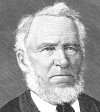 |
|
He was trained as a gardener in Gotha, Göttingen, Bonn and Berlin, and was the head gardener at the botanical gardens in Zurich from 1842 -1855, also a lecturer at the university. He became the director of the botanical gardens in St. Petersburg in 1855. He was the founder of the Russian Horticulture Association and published the Gartenflora. Numerous gardening publications and botanical works concerning a few plant groups (in particular Betulaceae, Allium) and the Central Asia flora are attributed to him. He was born in Gotha, Germany, and his career began at the age |
of 15 as an apprentice at the Royal Gardens there, then he worked for several years at the botanical gardens in Göttingen, Bonn and Berlin. Regel earned a degree from the University of Bonn. In 1842 he moved to Switzerland to become the head of the Old Botanical Garden, Zürich, and in 1855 moved to St. Petersburg, Russia, where he initially worked as a research director and later as senior botanist at the Imperial Botanical Garden. From 1875 until his death he served as the director of the Imperial Botanical Garden. He was an associate member of the St. Petersburg Academy of Sciences and published over 3,000 articles in scientific journals. He described and named over 3,000 plant species.
- re'gia: royal.
- regi'nae: of the queen.
- regiri'vum: from the area of the King's River in the Sierra Nevada
foothills near Fresno. A taxon with this name is King's River buckwheat, Eriogonum nudum var. regirivum.
- regismonta'na: possibly of or from the area of King's Mountain which
is near San Francisco where this taxon is reportedly located.
- reifschnei'derae: named for Olga Augusta Wuertz (Mrs. John C. Reifschneider) (1900-1978). She was born on a farm
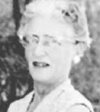 |
|
in Illinois and grew up and attended school in St. Louis, Missouri. She did not complete high school but married Jack Reifschneider and in 1920 moved to Ukiah, California. In 1929 they moved to Reno, Nevada, and opened an auto body shop. While there she pursued botany as a hobby. Quoted from the website of the Nevada Womens History Project: “Reifschneider took occasional college classes, but did not enroll full-time at UNR until 1944, the year her daughter Nita Reifschneider Spangler graduated with a journalism degree. The elder Reifschneider gained a |
bachelor’s degree in botany in 1949, and attended the Yosemite Field School for Ranger Naturalists that same year. While taking the botany 1 course at the University of Nevada in 1946, she learned that very little was known about the earliest botanists in Nevada. She began keeping a list of people whose names appeared in Nevada plant genera and species. Through the years, the names grew into a collection of biographies. She performed some of her research at the Bancroft Library at the University of California, Berkeley. Studies under prominent Nevada botanists such as William Dwight Billings, Philip A. Lehenbauer, and Ira La Rivers sparked her interest in the historical and biographical aspects of botany and eventually resulted in her book, Biographies of Nevada Botanists, published by the University of Nevada Press in 1965. The book has entries on 48 botanists, only five of whom were women — and she did not include herself. She pinpointed the specific year or years each person was directly involved with botanical work in Nevada and included a photograph if one was available. Although occupied as financial manager for her husband’s business until his retirement in 1968, Reifschneider maintained a second career as botanist and nature writer until her death in early 1978. Through contact with James R. Henrichs, Agnes (Scott Hume Train) Janssen, and W. Andrew Archer, who worked on the Nevada Indian Medicine Project in the 1930s and 1940s, she developed a lifelong interest in native medicinal plants. Reifschneider lectured and wrote articles on wildflowers, desert biology, and the environment, as well as Nevada history, petroglyphs, and Benjamin Franklin. In the field she was an avid plant collector and photographer. One small wildflower she collected near Pyramid Lake in 1956 was identified as a new species and given the name Mimulus reifschneiderae. Several of her articles were published in Nevada Parks and Highways magazine. Olga remained physically active most of her life. In 1974, she was swimming a mile every day. During a month-long vacation to Hawaii in 1976, she rode a mule down a 2,000 foot cliff on the island of Molokai. Her notes from the trip indicate the cliff trail was 3 ¼ miles long, with 26 switchbacks. Olga was a member of the Sierra Club, the Nevada State Historical Society, the Camera Club, the Nevada Horticultural Society, the National League of American Pen Women, the Nevada Corral/Westerners International, and the Order of Eastern Star. She was one of the original seventeen sponsors responsible for creating the Northern Nevada Native Plant Society in 1975 and retired from its board of directors in November 1977, a few months before her death." The taxon Mimulus reifschneideae is a synonym of Mimulus nanus var. mephiticus. (Photo credit: Nevada Womens History Project)
- Reinward'tia: named for Caspar Georg Carl Reinwardt (1773-1854), a Dutch botanist, professor and founder of the
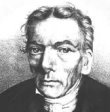 |
|
Bogor Botanic Garden, Java. He was born in Leiden and at the age of 14 was apprenticed to an Amsterdam pharmacy where his brother worked. He came in contact with several scientists, including the botanist Gerardus Vrolik. He was educated at the Athenaeum Illustre where he successfully engaged in the study of chemistry and botany. The following is quoted from Wikipedia: “Under the Batavian Republic and the Kingdom of Holland he served as a professor of natural history at the University of Harderwijk from 1800 to 1808. After a while he became |
associate professor of chemistry and pharmacy. In 1808 he appealed to King Louis Bonaparte and was offered work as director of the ‘to be built’ botanical and zoological gardens and museums. In 1808 he became a member of the Royal Institute of the Netherlands. In 1810 just before the annexation of the Kingdom of Holland by the French Empire, he became professor of natural history in Amsterdam. After the restoration of independence in 1813 and of its colonial empire in 1816, the Netherlands was eager to re-establish contact with its colonies. In 1816 he was offered a position as head of agriculture, arts and science of the colony, and journeyed to the Dutch East Indies where he conducted various botanical investigations throughout the archipelago. Reinwardt was the founder (1817) and first director of the botanical gardens at Bogor (then called Buitenzorg) in Java. There he gathered and cultivated various flora from the surrounding islands such as the Moluccas, Timor and Sulawesi. Reinwardt also undertook several expeditions to collect plants that were sent to the Hortus Botanicus Leiden. However, not many of these plants survived the journey from Java to the Netherlands. The ship on which they were transported, the Admiraal Evertsen under command of Captain-Lieutenant Ver Huell, was shipwrecked on Diego Garcia with the loss of its precious cargo. .Reinwardt remained as director of the Botanical Gardens until 1821 and spent most of his time gathering tropical plants. He returned to the Netherlands in 1822 and became a professor of natural history at the University of Leiden in 1823, where he devoted his life to chemistry, botany and mineralogy. Reinwardt also studied amphibians and reptiles, describing two new species of snakes, Laticauda semifasciata and Xenopeltis unicolor. In 1831 Reinwardt published a catalog of the plants growing in the Leiden Hortus. He counted exactly 5,600 species and varieties, an increase of nearly 600 since 1822. In particular, the numbers of Australian, Chinese and Japanese plants had increased. This increase in number of varieties was largely contributed by Philipp Franz von Siebold who sent many plants to the Hortus Botanicus in Leiden. Reinwardt finally retired as a professor in 1845 and died nine years later.” The genus Reinwardtia was published in 1822 by Barthélemy Charles Joseph Dumortier.
- remis'sus: faint, from Latin remissus, “languid, negligent.”
- remotifo'lium: with scattered (remote) leaves.
- remo'tus: scattered, remote, far-flung, at a distance, from Latin remotus, "distant, removed, moved back."
- renauld'ii: named for Ferdinand François Gabriel Renauld (1837-1910), a French botanist, bryologist, military officer and co-collector with Jules Cardot. He was born in Vesoul and died in Paris. He was also co-author with Cardot of Histoire naturelle des plantes mousses (Natural History of Mosses).
- renifor'me/renifor'mis: kidney-shaped, alluding
to the leaves, from Latin renes, "kidneys," and forme, from the Latin forma, "shape, figure,
appearance, nature."
- repan'da/repan'dum: both Stearn and Gledhill say with slightly wavy margins, and a website of the Marine Biodiversity Records lists the etymology of Latin repanda as "having a slightly uneven and waved margin," however Jaeger's Source-book has the Latin root repandus as "bent backwards, turned up." and Wiktionary says from re-, "again, back,” and pandus, “turned, bent, crooked.” The Harris and Harris volume entitled Plant Identification Terminology: An Illustrated Glossary defines the word 'repand' as "with a slightly wavy or weakly sinuate margin, undulate." This is illustrative of the fact that meanings in botanical Latin often differ from strict Latin.
- re'pens: having creeping and rooting stems, from Latin repo, "to creep or crawl."
- repos'tum: possibly meaning "remote, out of the way" and given because
its range is 'remote' from that of L. lucidum. There was originally a varietal epithet of repostum for Lomatium lucidum (Lomatium lucidum var. repostum) but that has now been changed to Lomatium repostum.
- rep'tans: see repens above.
- Rese'da: from the Latin resedare, "to assuage or calm,"
because of supposed sedative properties. The genus Reseda was published by Carl Linnaeus in 1753.
- resupina'tum: Stearn says "bent back, put on its back, applied
to organs turned upside down by a twist in their support," and
Harris and Harris say that resupinate means "upside down due
to twisting of the pedicel."
- reticula'ta: net-veined, from Latin reticulum, "a net."
- retino'des: I'm not sure about this one and available sources are not in agreement. The -odes suffix
indicates resemblance or similarity, but I have found two possible
meanings of the root retin. Three other genera whose names
begin with "Retin-" (Retiniphyllum, Retinispora,
and Retinodendron) are explained by Umberto Quattrocchi as
being from the Greek rhetine, "resin," whereas the
genus Retispatha (without an 'n') derives from rete or retis, "a net." Jaeger's Source-Book of Biological
Names and Terms also gives for retin- a derivation from rhetine. However the Dictionary of Word Roots and Combining
Forms gives two meanings for retin-: (1) from the Latin rete/reti, "a net or network;" and (2) from the
Greek for pine resin. The original description of Acacia retinodes is based on specimens without fruit or seeds, and seems to mention
a netlike arangement of some of the veins of the phyllodes, so this
is a possible explanation, however Acacia retinodes like other wattles also produces harvestable quantities of gum (resin), and another species, Shorea retinodes from Indonesia, also produces high quantities of a clear resin called damar mata kucing. Thus it would seem that this derivation is the likeliest one, and a WordPress webpage called Landscape Architect's Pages agrees with this derivation by saying "Retinodes is derived from the Greek rhetine, "resin of the pine," and the suffix odes meaning "like." Thanks to José Manual Sanchez of Spain whose communication to me suggesting this explanation prompted me to do a little further research.
- retroflex'a/retroflex'us: reflexed. The website Etymonline says "bent backward," in botany, from Latin retroflexus, past participle of retroflectere, "to bend back," from retro, "back" and flecto or flectere, "to bend."
- retrofrac'ta: Gledhill says "stubborn, turned aside, refracted." One definition of refractus in Latin is "broken up or open," and the Latin roots frang, frango or frangere appear to mean "to break or broken." The taxon Boechera retrofracta in the California flora is common called reflexed rock-cress.
- retror'sa/retror'sum: reflexed or turned backwards.
- retu'sa/retu'sum/retu'sus: blunt or rounded with a shallow notch at the tip.
- revealia'na: named for James Lauritz Reveal (1941-2015), a major American botanist and taxonomist, a professor
 |
|
emeritus at the University of Maryland, adjunct professor at Cornell University's department of plant biology and honorary curator at the New York Botanical Garden. He was born in Reno, Nevada. His father was a forester/botanist and no doubt heavily influenced the direction his son’s life would take. He attended Utah State University where he received a BS degree in 1964 and an MS in 1966, and then was awarded a PhD from Brigham Young University in 1969. He held a post-doctoral fellowship with the Smithsonian Institution from 1967 to 1969, at which time he joined |
the faculty of the botany department at the University of Maryland. From 1979 to 1999 he was the director of the Norton-Brown Herbarium at UMd. Wikipedia adds: “Reveal's research interests included botanical studies in the American west, especially endangered and threatened species. He studied the history of botanical exploration in the New World and botanical nomenclature and taxonomy as well, with much of his research and writing devoted to the Polygonaceae subfamily Eriogonoideae, commonly known as the wild buckwheats. His interest in combining history and botany led to projects on botanical history of colonial Maryland and on the botanical discoveries of the Lewis and Clark expedition, about which he wrote several books and articles. A prolific collector, author, and speaker, Reveal collected more than 9,000 plant specimens from North America, Central America, and China, and published over 500 papers; he presented more than 100 invited talks. As a member of the Smithsonian Institution's Endangered Species Committee (1974-1982), Reveal was instrumental in attaining the addition of endangered plant species to the original Endangered Species Act. Reveal discovered or identified over fifty plant varieties, most of these discoveries being flowering plants of the American southwest. In 1968, Reveal identified five new plant varieties at a Nevada nuclear testing site. In 1981, Reveal and Norlyn James Bodkin, then professor of botany at James Madison University, identified a new lily variety, the first new plant discovery along the eastern US seaboard since the 1940s. In 1978, Reveal married his University of Maryland colleague, the botanist C. Rose Broome (later with the Agricultural Research Service of the US Department of Agriculture). They collaborated on many research projects, most notably the botanical studies of colonial Maryland and explorations in Mexico that identified two new plant varieties. Reveal helped document the flora of Maryland and the mid-Atlantic and assisted in Broome's 1979 publication of the first checklist of Rare and Endangered Vascular Plant Species in Maryland. In 1992, Reveal's illustrated Gentle Conquest: The Botanical Discovery of North America was published. Gentle Conquest encompasses the history of botanical exploration in the New World from the first settlement to the end of the Western frontier.” During his career he made significant contributions to the systematic taxonomy of flowering plants, publishing his own system of classification. Following his retirement in 1999, he was honorary curator of the New York Botanical Garden (2003-2015) and adjunct professor at Cornell University (2007-2015), worked on the Intermountain Flora project, and collected plant specimens throughout several western US states, including California, Colorado, and Nevada. He died in Ithaca, New York.
- reverchon'ii: named for Pierre Julien Reverchon (1837-1905), a French botanist born in Diémoz in southeastern
 |
|
France. His mother was the primary source of his early education. Julien was keenly interested in plants and the natural world as a young man and he amassed a collection of nearly 2,000 species of plants with his brother. His father, Jacques Maximilien Reverchon, was a follower of Charles Fourier, one of the founders of the utopian socialist movement, and after a failed effort in Algeria, he decided to take his family to join Victor Prosper Considerant, another utopian socialist, at a colony the latter had been in the process of trying to create along Fourierist principles in La |
Réunion, near Dallas, Texas. They arrived at La Réunion in December, 1856, only to find that the colony had failed. Jacques bought a small farm in the area and Julien began to study the local flora. Julien was married in 1864 and had two sons, both of whom died of typhus in 1884. Due to the necessity of working on the farm, he abandoned botany for a time, but began collecting plants again in 1869. During a fossil-finding expedition with Jacob Boll in West Texas in September, 1879, he found the plant from which Asa Gray named the genus Reverchonia. He contributed to books by Gray and Charles Sprague Sargent, as well as to journals such as Garden and Forest, the American Botanist, and the Bulletin of the Torrey Botanical Club. He also contributed specimens to the United States Department of Agriculture and the Smithsonian Institution. He was a member of the Torrey Botanical Club of New York, and during the last ten years of his life was professor of botany at the Baylor University College of Medicine and Pharmacy at Dallas. His wife died in 1901. By the time of his death of Bright’s disease in 1905, his farm housed more than 2,600 species and more than 20,000 specimens of Texas plants, a collection considered one of the finest of its kind in the world which was secured by the Missouri Botanical Garden. The city of Dallas named Reverchon Park in his honor. I have no information as to whether he carried on at all his father's philosophical principles.
- revolu'ta/revolu'tum: rolled back from the margin or apex, revolute, from the Latin revolutus, "rolled" or "revolved." Gledhill says "rolled back, rolled out and under." Stearn says "rolled backward, as some leaves are at the edges."
- Reynou'tria: named for Karel van Sint-Omaars (1533-1569) aka Charles of Saint-Omer, a wealthy Flemish botanist and humanist, and Lord of Moerbeke, Dranouter, Merris, Oudenem, Moerkerke, etc. He undertook studies at Leuven but it is not known which studies and whether he completed them. He apparently would have pursued a military career but had to give up that idea for health reasons. He first married Françoise de Bloiss and after her death Anne d'Oingnies, but both marriages were childless. As a botanist, he put a lot of work into describing the native fauna and flora. He created one of the most beautiful gardens of that time around his castle in Moerkerke near Bruges. The Italian politician Luigi Guicciardini thought it worthwhile to mention the garden of Karel van Sint-Omaars in his description of the Netherlands, and Flemish Catholic cleric and historian Antonius Sanderus praised him in his Flandria Illustrata and wrote that he possessed s knowledge of plants and animals like no other. He employed the Bruges painter Jacob Van den Coornhuuse who made more than 1,600 watercolors for him, of which more than 1,400 gave reproductions of the then known plants and flowers. Charlemagne wanted to devote a large publication to this, for which he already had a name, the Centuriae plantarum rariorum, and Carolus Clusius stayed with him in Moerkerke to prepare the accompanying texts, but unfortunately this plan was thwarted by the early death of Sint-Omaars. This collection of botanical watercolors is now considered one of the most important botanical collections from the Renaissance period. He also maintained a small zoo at Moerkerke which is considered one of the first in Flanders. Karel was a member of various militia guilds, such as the guild of Saint George in Ghent, the archers' guild of the city of Ghent, the crossbowmen's guild, the crookers and the archers guild of the city of Bruges, the Saint Sebastian guild of Moerkerke and the guild of the crossbowmen of the city of Damme. He was only about 36 when he died. The genus Reynoutria was published by Maarten Houttuyn in 1777, and the name Reynoutria comes from his title of Baron Van Reynoutre.
- rhagadiolo'ides: having the form or resemblance to the genus Rhagadiolus.
- Rhagadio'lus: "crevice-like" from the Greek rhagas or rhagados, "a fissure or crevice," a reference
to the strongly folded inner phyllaries. The genus Rhagadiolus was published in 1759 by Antoine Laurent de Jussieu.
- rhamno'ides: resembling Rhamnus.
- Rham'nus: an ancient Greek name rhamnos and Latin rhamnus for the buckthorn and meaning "a prickly bush" and referring to a number of such shrubs or small trees.
The genus contains well over a hundred species native mostly to east Asia and North America, but found throughout the temperate and subtropical northern hemisphere, and also more locally in the subtropical southern hemisphere in parts of Africa and South America. The genus Rhamnus was published by Carl Linnaeus in 1753.
- Rhapont'icum: I have been unable to find a certain derivation of this name, but it appears to relate to some geographic or botanical term going back to the Hellenistic period in the Black Sea area. Pontus or Pontos is a region on the southern coast of the Black Sea and northern coast of Anatolia, located in the modern-day eastern Black Sea region of Turkey. And rha was either a plant name or an ancient name for the river Volga used by Ptolemy. The word rha ponticum, Latin for 'rha from Pontus,' is the name the Romans used for a valued medicinal root imported from the east. Dioscorides also mentions the root is most similar to that of Centaurea. The website of SERNEC (the Southeast Regional Network of Expertise and Collections) says however that "Rhaponticum comes from the Greek rha for rhizomes." This all just goes to show that the meanings and derivations of some epithets are just guesswork or unknown. The genus Rhaponticum in the Asteraceae was published in 1757 by Christian Ludwig Gottlieb, and the genus Rhaponticum in the Polygonaceae was published in 1794 by Conrad Moench.
- Rhinotro'pis: Flora of North America says from Greek rhinos, "snout," and tropis, "keel," alluding to the beaked keel petal. The genus Rhinotropis was published in 2011 by J. Richard Abbott.
- rhizoma'ta: with rhizomes.
- Rhodio'la: a diminutive of the Greek rhodon, "rose,"
a name used by old herbalists referring to the rose-scented roots
of the type species. The genus Rhodiola was published by Carl Linnaeus in 1753.
- Rhododen'dron: rose-tree, from the Greek rhodos or rhodon, "rose," and dendron, "tree." One source however says Latin rhododendron is for oleander. The International Oleander Society says "It is also surmised that the name oleander came from a corruption of the Latin name for rhododendron with which it has also been confused." There is definitely a connection between the names Rhododendron and oleander but I can't quite parse out what it is. The genus Rhododendron was published by Carl Linnaeus in 1753.
- rhodopet'ra: from the Greek roots rhodo, "rose," and petra, "rock or stone," alluding to the taxon Erythranthe rhodopetra which is location at Red Rock Canyon and called Red Rock Canyon monkeyflower.
- rhodosper'ma: red-seeded.
- Rhodoty'pos: from Greek rhodo, "a rose," and typos, "a type, pattern," alluding to its resemblance to the genus Rosa. The genus Rhodotypos was published by Philipp Franz Siebold and Joseph Gerhard Zuccarini in 1841 and is called jetbead.
- rhodotri'cha: red-haired.
- rhoe'as: a Latin name for the common red poppy, probably from rho,
"red," although Wiktionary says from the ancient Greek rhoiás, which could be from rhéō, “I flow, run,” or a Pre-Greek loan word. Gledhill says "the old generic name for the field or corn poppy Papaver rhoeas," which is the taxon in California.
- rhombifo'lia: with diamond- or rhombus-shaped leaves.
- rhombipet'ala: with diamond- or rhombus-shaped petals.
- rhomboid'ea: diamond-shaped.
- rhothophi'lum: from the Greek rhothos, "a rushing or
dashing noise," as of breakers and surf, or rothos, "a
torrent," and -philum, in compound words signifying "love
of, loving," hence meaning approximately "surf-loving"
which would be appropriate for this dunes plant.
- Rhus: derived from rhous, an ancient Greek
name for sumac. The genus Rhus was published by Carl Linnaeus in 1753.
- Rhynchely'trum: from the Greek rhynchos, "horn, beak,
snout," and elytron, "sheath, cover, scale, husk,"
referring to the beaked upper glume in some species. The genus Rhynchelytrum was published by Christian Gottfried Daniel Nees von Esenbeck in 1836.
- Rhynchospo'ra: from the Greek rhynchos, "horn, beak,
snout," and spora or sporos, "seed, spore,"
thus "beaked seed." The genus Rhynchospora was published by Martin Vahl in 1895.
- Ri'bes: from Latin ribes, "currant," from the Arabic or Persian ribas,
meaning "rhubarb or acid-tasting and undecorated, unattractive." The genus Ribes was published by Carl Linnaeus in 1753.
- Riccar'dia: for one or more of the members of the Riccardi family of Florence, Ottavio (Octavius) Riccardi (no dates available), Francesco Riccardi (1648-1718), his wife Cassandra Capponi Riccardi (1653-1723), his son Cosimo Riccardi (1671-1751) and Vincenzio Riccardi (1704-1752), all of whom are mentioned in Pier (Pietro) Antonio Micheli's Nova Plantarum Genera as having supported the work. Samuel Frederick Gray published the name Riccardia in the Aneuraceae in 1821. He didn't explain the names of his new genera but many of them matched the names of people referred to in the Nova Plantarum. German Wikipedia states that the name honors Octavius Riccardi of Florence, a sponsor of Nova plantarum genera (1729). Florence is home to the Palazzo Medici Riccardi which was designed by Michelozzo di Bartolomeo for the head of the famous Medici family that ruled Florence and the Tuscany area for long time, Cosimo de’ Medici, and which was built during the years 1444 to 1484. In 1659 the banker family Riccardi bought the palace from the Great Duke Ferdinando II. For 200 years it was in the family, and they made numerous changes inside the building, leaving the outside untouched. The family sold the building to the Italian government in 1814. I can't say for sure that this was the same family as mentioned above, but it may be. The genus Riccardia was published by Asa Gray in 1821.
- Ric'cia/Ricciocar'pos: named for Pietro Francesco Ricci (1690-1751), an Italian (Florentinian) senator, member of the Florence Botanical Society, patron of Pier Antonio Micheli. The name was proposed by Micheli who provided the etymology but apparently did not explain it. The genus Riccia was published by Carl Linnaeus in 1753 and the genus Ricciocarpos was published by August Karl Joseph Corda in 1829.
- ric'ei: named for Myron Arthur Rice (1892-1970). He was born in Matawan, New Jersey, and received a BS degree from the University of California in 1916 and an MS in agriculture from Cornell University in 1925. He was a professor of botany at Clemson University where he was one of the two people who undertook the rebuilding of the herbarium after Sikes Hall, the site of the natural history collections, was destroyed by fire in 1925. He also contributed numerous plant specimens to the herbarium. Mr. Rice remained at Clemson until 1938 when he left for Cornell University to pursue a PhD. He appears to have been interested mainly in fruits, vegetables and culinary herbs. He died in Maugatuck, Connecticut.
- Richard'ia: named for Louis Claude Marie Richard (1754-1821), a French botanist, bryologist, pteridologist and
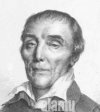 |
|
botanical illustrator. The following is quoted from JSTOR: “He was born into a family of royal gardeners at Versailles. His great-grandfather had been in charge of Louis XIV's menagerie, and his grandfather and father were the head gardeners respectively at Trianon and Auteuil at the time of his birth. While Richard was growing up at Trianon, Michel Adanson was in residence as royal botanist and Bernard de Jussieu was director of the garden. Richard desired nothing more than to follow in the family tradition, but his father worried that horticulture was not a secure profession |
and sent him to college, where his intelligence and talent for drawing was noted by the Archbishop of Paris, who offered his protection to the boy on the condition he take holy orders. Against his father's wishes Richard refused to enter the clergy and, at the age of 14, left for Paris to attend courses at the College de France and the Jardin du Roi, earning his living by drawing garden plans for architects. In 1781 he was sent to French Guiana by the French government to cultivate spice plants introduced by Sonnerat and Poivre and to explore the botany of the colony and its neighbouring countries. But, on arrival in Cayenne, he found himself barred from entering the botanical garden where he had been made director, because the governor was using it to grow vegetables. He had to wait for several years before this governor was replaced and he could take charge of the botanical garden and start cultivating the many species collected on his explorations all over French Guiana and parts of Brazil and the Antilles. In 1789, after eight years away, Richard returned to France with a large collection of natural history specimens and drawings, including a herbarium of 4,000 specimens and a spectacular collection of molluscs. He felt like a stranger in his own country however, and during the revolution became profoundly reclusive. His situation improved in 1795 when he was elected to the Académie des Sciences and named professor of botany at the École de Medicine, where he founded a botanical garden and began working with rare and exotic plants, notably orchids. But like his two mentors, Adanson and Jussieu, he produced few publications from his botanical research. He did, however, collaborate with André Michaux on the Flora Boreali-Americana (1803) and completed his master work, Demonstrations Botaniques (1808), one of the era's most important treatises on fruit, De Orchideis Europaeis (1817), Commentatio Botanica de Conifereis et Cycadeis (1826) and De Musaceis Commentatio Botanica (1831) were published posthumously by his son, Achille, a noted botanist, who succeeded him at the medical school.” He was also a member of the Royal Prussian Academy of Sciences. The genus Richardia in the Araceae was named in his honor, but it is now a synonym of the genus Zantedeschia. (Photo credit: Alamy)
- richards'iae: named for Dr. Jennifer Helen Richards (1949- ), a professor emerita of biological sciences at Florida
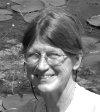 |
|
International University (FIU), who has studied the plants of Nemacladus richardsiae in the field with the senior author, Nancy Morin, while accompanying her on many Nemacladus collecting trips. This taxon was first published in Madroño 67: 44 (2020). She went to Tates Creek High School in Lexington, Kentucky, and in 1972 received an AB degree in biology at Radcliffe College of Harvard University, a graduate degree from Indiana University department of plant sciences, and a PhD in botany from the University of California, Berkeley, in 1980. From 1981 to 1982 she was |
an assistant professor in the department of biology at Wellesley College. Positions she has held include secretary of the Botanical Society of America and associate editor of the American Journal of Botany. She is the author or co-author of a vast number of articles, reports and symposia papers. Richards' lab studies wetland plant ecology, especially how plants respond to the hydrologic and nutrient challenges presented by the aquatic environment, and the landscape and community ecology of south Florida vegetation. A website of Florida International University provides this look at her work: “Nearly 40 years into her career, the FIU biological sciences professor speaks with an awe for flowers, ferns and grasses similar to a botanist launching her career. Richards was named this year’s Distinguished Fellow by the Botanical Society of America, one of the world’s largest societies devoted to the study of plants and wildlife that interact with it. ‘It’s great to have my work recognized by the society,’ Richards said. ‘Some of the people I have most looked up to in my career have been honored with this prestigious award, I feel humbled to be in their company.’ Richards studies plants in the Florida Everglades as part of the Florida Coastal Everglades Long Term Ecological Research Program. She turns to sawgrass, spikerushes and other plants for clues into how water, climate change and people affect the tropical wetlands. She is currently working with the GIS [Geographical Information Systems] Center to map vegetation throughout Everglades National Park using remote sensing techniques. This will shed light on how large areas of vegetation respond to restoration efforts over time, Richards said. Richards has also studied how invasive species, including ferns, reproduce and what methods are most effective for controlling them. She has conducted this research through the International Center for Tropical Botany at The Kampong, a collaboration between FIU and the National Tropical Botanical Garden. She also studied water lilies as indicators of Everglades ecosystem health in the Southeast Environmental Research Center in FIU’s Institute of Water and Environment. As a young undergraduate at Harvard University, Richards did not intend to pursue a career in botany or science at all. She started out as an English major. But the counterculture of the 1960s grew popular and she realized she had a calling for environmental stewardship, Richards said. She changed her major to biology and fell in love with the study of plants when she took her first botany course. Richards went on to earn a PhD in botany from University of California, Berkeley. Richards landed at FIU in 1982 joining the department of biological sciences as an expert in plant morphology, development and ecology. Richards has served the Botanical Society of America in a number of roles, including secretary and associate editor of the American Journal of Botany, the society’s flagship journal. Richards hopes her work will inspire and inform future generations of scientists working to solve some of the planet’s toughest challenges, from climate change to environmental restoration and conservation.” (Photo credit: Florida International University)
- richardson'ii: named for Arnold Edwin Victor Richardson (1883-1949), an Australian agricultural scientist born in
 |
|
Thebarton, South Australia. His father was proprietor of a steam works, inventor of an improved brick-making machine, an improved direct-action stamp battery, and an automatic railway coupling, proprietor of an ironworks, and manager of a foundry. He was educated at the Currie Street Public School, then Adelaide Agricultural School, and was awarded a scholarship to Roseworthy Agricultural School, where he earned a first-class diploma in 1902. In 1907 he received a BA degree from the University of Adelaide, in 1908 a BS degree in agriculture |
from the same institution, and in 1910 an MA. He taught at agricultural and other state schools and was married in 1909. From 1911 to 1924 he was superintendent of agriculture, Victoria, and member of the executive committee to the Advisory Council of Science and Industry. He began lecturing part time in 1917 for the faculty of agriculture, University of Melbourne, and from 1919 to 1924 he was dean of the reconstructed faculty of agriculture and first director of the School of Agriculture, University of Melbourne. From 1924 to 1937 he was Waite professor of agriculture and director of Waite Agricultural Research Institute, University of Adelaide. During that time he was also commonwealth delegate to the First Imperial Agricultural Research Conference in London, official adviser to the Australian Delegation at the Imperial Economic Conference in Ottawa, and foundation president of the Australian Institute of Agricultural Science. From 1938 to 1946 he was deputy chief executive officer of Commonwealth Scientific and Industrial Research Organization (CSIRO), an independent Australian federal government agency responsible for scientific research whose chief role was to improve the economic and social performance of industry for the benefit of the community. He was chief executive officer from 1946 to 1949. Over the course of his career, he established the research stations at Werribee and Rutherglen, and through these and many field experiments, developed scientific agriculture in Victoria, investigated agricultural education and research in North America, reorganized cereal breeding and culture in Victoria and started a pasture improvement program, and inaugurated the Better Farming Train to implement agricultural extension work. Richardson's main fields of personal research were cereal agronomy and wheat-breeding; his principal publications dealt with agricultural education in Canada and the United States, wheat and its cultivation, and the water requirements of farm crops. He died in East Melbourne in 1949 of coronary vascular disease. (Rytidosperma richardsonii) (Photo credit: CSIROpedia)
- richardson'ii: named for Sir John
Richardson (1787-1865), a Scottish naturalist, meteorologist, doctor, cartographer
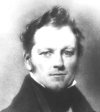 |
|
and Arctic explorer. According to David Hollombe, Geranium richardsonii was a replacement name for Geranium
albiflorum Hooker, a species published in Sir William Jackson
Hooker's major work, Flora boreali-americana, which came out
in two volumes and twelve parts from 1829-1840. Although the
type specimen for G. albiflorum was collected by Thomas Drummnd,
Richardson's collections were a major part of the book. I found
the following on Dr. Jim Endersby's excellent website on Joseph
Dalton Hooker and is from Leonard Huxley's Life and Letters
of JD Hooker: |
"Sir John Richardson (knighted 1846)
saw much active service as naval surgeon, 1807-15, then returned to
Edinburgh and took his MD, at the same time studying botany and
mineralogy. He was naturalist to Sir John Franklin on two Arctic
expeditions, 1819-1822 and 1825-1827. [Only a handful of the
original members of Sir John Franklin's first Arctic expedition returned.
John Richardson was one of them. His journal recounts
their journey across the Barren Grounds, providing many details not
found in Franklin's own 1823 narrative and raising questions about
Franklin's ability as a leader. Entitled Arctic Ordeal, The
Journal of John Richardson, Surgeon-Naturalist with Franklin, 1820-1822,
'His journal made such an outstanding contribution to ornithology,
ichthyology, botany, and geology that much of modern Arctic research
is founded upon his observations.' From McGill-Queen's University
Press] For ten years he was head of the Melville Hospital at
Chatham, and from 1838 was physician to the Royal Hospital at Haslar,
where young naval surgeons awaiting their gazetting to ships were
under him. Again, in 1848-9, he led the expedition in search
of Franklin. [Franklin's third Arctic expedition had begun
in 1845 and it eventually became clear that it had been lost with
no survivors. Richardson could not find any remains of the expedition.
He wrote of this in his book Arctic Searching Expedition.]
His second wife, m. 1833, d. 1845, was a niece of Franklin’s.
In addition to his works on polar zoology and travel, his special
subject was fishes." Richardson made accurate surveys of
more of the coastline of the Canadian Arctic than any other explorer.
On Franklin's second expedition, Richardson explored to the
Coppermine River and Great Slave Lake. The Colorado rubber plant, Hymenoxys richardsonii, discovered by William Jackson Hooker,
was named by him in Richardson's honor. His name is also on the Richardson's
ground squirrel, Citellus richardsoni, a squirrel of the NorthWest
which Richardson first discovered, and on the Richardson Mountains
of Canada. Richardson was also the author of the Fauna boreali-americana published from 1829 to 1835, Icones Piscium (1843), the second
edition of Yarrell's History of British Fishes (1860) and The
Polar Regions (1861). He was an amazing person with eclectic interests
in rocks, mammals, fish and plants. (All other richardsonii taxa in California except for the one listed above)
- richardson'is: see previous entry.
- rich'ii: named for Major William Rich (1800-1864), an American botanist and explorer. He was the youngest son of Captain Obadiah Rich (1758–1805) who commanded the brig Intrepid in the American Revolutionary War. The following is quoted from an entry on him in JSTOR: “Participant on the US Exploring Expedition of 1838-1842 (the Wilkes Expedition). William Rich was brought up and influenced in his interest in plants by his older brother Obadiah Rich, a shipping agent and later US consul in Spain. William Rich was working as a clerk when he was appointed to the Exploring Expedition as an assistant to Asa Gray, on the basis of his recent work in helping to compile a checklist of plants around Washington D.C. He became the trip's chief botanist in lieu of the better-qualified Gray after Gray pulled out in favour an academic appointment (the first professorship in botany in the US). William Brackenridge, appointed as horticulturist to the expedition, in fact did most of the collecting and botany on the voyage led by Charles Wilkes, William Rich not being particularly adept. The expedition's ships led a trail from Virginia around the coast of South America, past Rio de Janeiro, Tierra del Fuego, Chile and Peru to the South Pacific and Samoan Islands before visiting New South Wales in 1839 and then exploring the Antarctic coast in early 1840. Pushing up towards Fiji and Hawaii, it then traversed the West Coast of the United States in 1841, where an overland party including Rich explored from Oregon along the Siskyou Trail to upper California. The expedition then continued to the Philippines, Borneo and Polynesia, rounding the South African Cape on its way back to New York, which it reached in June 1842. Plant collections made by Rich, Brackenridge and another of the expedition naturalists, Charles Pickering, number about 50,000. The main collections were deposited at the Smithsonian Institution with duplicates going to the Gray Herbarium and other institutions. Following the expedition Rich did not produce a satisfactory report on the botanical findings, and in 1846 was appointed Major and paymaster to a troop of volunteers involved in the Mexican-American war. Rich thus engaged in military business, Asa Gray instead made his contribution to the enterprise by writing up a portion of the botanical findings (Brackenridge, Pickering and John Torrey produced the rest). Few copies of the Wilkes reports were actually published and are thus some of the rarest 19th century scientific publications. Rich continued in his military capacity until late 1849, bringing back a few dried plant specimens from California. J.H. Barnhart records that he took the opportunity to collect specimens while involved in the US and Mexican Boundary Survey (1848) and then in 1853 on the Pacific Railroad Surveys, but this is unconfirmed. He was appointed Secretary of the US Legation in Mexico 1952, but this post lasted under two years. Details of his later life are obscure. Rich's failure to make his mark in academic botany was not the result of a lack of interest; he had co-founded the Botanic Club of Washington in 1825 and was a keen horticulturist, organising the Columbian Horticultural Society's annual exhibition in Washington. However it seems Rich had not the aptitude or zeal to devote himself wholeheartedly to fieldwork or science. Asa Gray, who agreed for Rich to take his place on the Wilkes Expedition, named the genus Richella A. Gray after him, as well as the species Cyrtandra richii A. Gray, Senecio richii A. Gray and Lycium richii A. Gray." All of the preceding having been said however, an article entitled “Botanizing Western Oregon In 1841 – The Wilkes Inland Expedition” by Mariana D. Bornholdt paints a very different picture, to wit: “William Rich, a political appointee, was the expedition’s botanist, with William Brackenridge as the assistant botanist/horticulturist. There appears to have been little interaction between the two men. Brackenridge faithfully kept a detailed day-by-day record of his experiences and plant collections, together with personal observations. Rich …. evidently kept no records or notes, was sick during most of the trip, and is mentioned only in passing in others’ journals. In fact, strenuous efforts were later made to expunge Rich from official records of the voyage, so great was contempt for his incompetence (Eyde, R.H. 1986. William Rich of the Great Exploring Expedition and how his shortcomings helped botany become a calling. Huntia 6:2) William Rich, son of a US ambassador to Spain, was a prominent Washington socialite. He had originally been appointed as assistant botanist to nationally-renowned Asa Gray, the expedition’s botanist, but had been later cut from the scientific staff. Rich was re-engaged and promoted to botanist when, at the last minute, Gray resigned his post to take an academic position. William Rich worked for four years on a write-up of the botany of the expedition, then gave up. Both his work and the man himself were judged inadequate. In 1845, Asa Gray advised J. D. Hooker: "The botanist who accompanied the expedition is no doubt perfectly incompetent to the task, so greatly so that he has but a remote idea how incompetent he is." (Letters of Asa Gray, Vol. I & II. Reprint of 1893 edition) Rich shortly thereafter resigned his situation and fled west, war with Mexico having begun. He returned to the Quartermaster Corps and later did a stint with the State Department in Mexico before disappearing from public life. John Torrey eventually rewrote the volume on botany, with the assistance of Asa Gray, who became involved in the Expedition once again. Upon examining Rich’s manuscript in 1846, Torrey wrote to Gray: "...could hardly believe it...Surely he could do nothing without aid...All of Rich’s text is worthless." (Rogers A.D., III. 1942. John Torrey: A Story of North American Botany, 181)
- Ric'inus: from Latin ricinus, a tick, from the resemblance of the seeds. The genus Ricinus was published by Carl Linnaeus in 1753.
- Riddel'lia: named for John Leonard Riddell (1807-1865), a botanist, microscopist, science lecturer, geologist, numis-
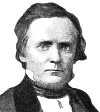 |
|
matist, medical doctor, chemist, politician and science fiction author born in Leyden, Mass. His father was, a schoolteacher, constable, and justice of the peace, moved the family to New York state near the town of Preston where John received his first education at a school run by one of his uncles. He briefly attended Oxford Academy, served for a time as a schoolmaster, and later enrolled at Rensselaer School in Troy, New York, receiving a BA degree in 1829 and an MA in 1832. He gave lectures on geology, botany, and chemistry in New York State and Ontario, Canada. In 1832 |
he was appointed as professor of chemistry and botany at Ohio Reformed Medical College. Two years later he began lecturing on botany at the Cincinnati Medical College, and advertised that he would collect plants for sale. He studied medicine in Marietta, Ohio, with Dr. Hildreth of Marietta College, and donated his specimens to Marietta College and the Hildreth Herbarium. This was one of the first botanical collections made in Ohio by a professional botanist. From 1836 until his death in 1865, he was professor of chemistry at the Medical College of Louisiana (now Tulane University) in New Orleans. While there, he invented the first practical microscope to enable binocular viewing of objects through a single objective lens. In 1850, he also undertook one of the earliest and most extensive American microscopic investigations of cholera. At some point he conducted botanical explorations in Texas, and then was appointed melter and refiner of the New Orleans Mint and Postmaster of New Orleans. He claimed to have been elected governor of Louisiana in November, 1863 and sworn in by a justice of the peace in January, 1864, but there was a military governor in place and his claim was rejected by a Congressional inquiry. He died in New Orleans. The genus Riddellia was published by Constantine Samuel Rafinesque in 1836.
- Riel'la: named for Michel Charles Durieu (Du Rieu) de Maissoneuve (1796-1878), a French soldier, botanist and plant
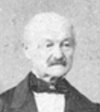 |
|
collector who took the opportunity to collect plants while on military missions and worked particularly on the flora of France and Algeria. JSTOR provides this: “[He] was born in Saint-Eutrope-de-Born in the department of Lot-et-Garonne and began his studies in a military school. In 1814 he entered the specialist military school of Saint-Cyr to train as a Lieutenant with the aim of working in national defence. In 1823, however, he was sent to Spain to participate in the Battle of Trocadero, besieging the fort and entering Cadiz with the French troops. At this time Durieu did not |
seem to have an interest in botany or the natural sciences. Later, in 1825, he began to observe fresh water algae and his passion for the study of plants developed. Two years later while garrisoned in Paris he met the botanist Jean-Baptiste Bory de Saint-Vincent whom he befriended and who, in 1830, was assigned as a botanist on the scientific section of the Morea Expedition. This mission was primarily a military affair to intervene in the revolutions in the Peloponnese, and in this capacity Durieu was involved as well. In 1835 he returned to Spain, this time to study its flora and explored Asturias collecting many plants, although he did not study them himself and instead sent his specimens to others for identification. His cryptogams went to Camille Montagne and the phanerogams, Jacques Gray. By 1840 Durieu was based in Algeria as an army Captain and also as a member of the commission for the scientific exploration of the country, this commission was headed by his friend, Bory Saint-Vincent. Between 1839 and 1841 Durieu alternated between scientific and military missions and after the war ended he continued to botanize in the region, not leaving Algeria until 1845. Between 1840 and 1842 he published a series of accounts of this expedition entitled Exploration scientifique de l'Algérie. On his return Durieu settled in Paris in order to organise and write up the results of his botanical exploration, again sending specimens to many experts for identification while continuing to collect plants in the greater Paris region. In 1853 he retired from all his duties as Captain and moved to Bordeaux, where he was named professor of botany at the municipal botanic garden. In this role he moved the garden from the suburbs into the center of the city and began to cultivate many North African species which he knew from his travels. In 1858 he was named director of the garden and, almost ten years later at the age of 70, he opened a public botany course.” Durieu was one of the most active members of the Linnaean Society of Bordeaux and during his years at the garden undertook excursions around his home country. Corresponding with other French botanists about his findings he slowly became a knowledgeable systematic botanist himself and published several works. He contributed four new species to the flora of France and ten to the flora of Algeria. He was the author of Exploration Scientifique de l'Algerie in 2 volumes and Plantae Selectae Hispano-Lusitanicae, Section I. The genus Riella was published by Jean Pierre François Camille Montagne in 1852. David Hollombe sent me this quote from the author's publication that explains how the epithet came about: "In the need that I feel to assure its discoverer the share of glory which belongs to him for having enriched botany in general, with so many beautiful plants, and especially the Acotyledons of such a remarkable genus, I have decided, on the reasoned opinion of eminent botanists, to definitively adopt the name Riella, taken from the word Rieu, in Italian Rio, stream in our language, to perpetuate as much as it is in me, the memory of the beautiful discovery of Mr. Du Rieu de Maissoneuve, convinced that by acting in this way I am only being fair to him." (Photo credit: Phaedra Digital Collections)
- ri'gens: rigid, stiff, from rigeo, "to be stiff or numb, stiffen, to stand upright, to remain unmoved or inert."
- riggins'iae: named for Dr. Rhonda Lee Riggins (Mrs. Richard Anthony Pimentel) (1944- ), a professor emerita at California Polytechnic State University, San Luis Obispo, and student of annual Lupinus, who first reported the Arroyo de la Cruz lousewort. Her collections are a significant part of the Robert F. Hoover Herbarium at Cal Poly. (Pedicularis rigginsiae)
- rig'ida/rig'idum/rig'idus:
rigid, referring to the stiff leaves.
- rigidis'sima: very rigid.
- rigid'ulum: somewhat rigid.
- Rigiopap'pus: from the Greek rigios, "stiffened,"
and pappos, "pappus." The genus Rigiopappus was published by Asa Gray in 1865.
- rimico'la: from the Latin rima, "a fissure," and
the -cola suffix indicating "a dweller of," this
taxon's preferred habitat is granite crevices.
- rin'gens: from the Latin ringens for "gaping, snarling," present participle of ringi, "to open the mouth, show the teeth," referring to the appearance of the corolla.
- ripar'ia: of or growing near river banks, from the Latin riparius which means "of the riverbank" and ripa, "riverbank."
- rip'leyi: named for Harry Dwight Dillon Ripley (1908-1973), a linguist, plant collector, artist and author, a cousin of
 |
|
the long-time Smithsonian director, S. Dillon Ripley, born in London in 1908, began his plant collecting in northern Africa and Spain in 1932 with his friend Rupert Barneby (see barnebyana), with whom he attended school at Harrow, and who became his lifelong companion and partner. The two men moved to Los Angeles, California in 1939 and traveled extensively in the western United States and Mexico, collecting plants for their garden and for herbaria. They moved to Wappingers Falls, New York in 1943, again establishing major gardens. Ripley wrote a greart deal about rock |
gardens and the plants he grew, was fluent in 15 languages and dialects and could read and write in 30, and was nearing completion at the time that he died of a work entitled Etymological Dictionary of Vernacular Plant Names, which is currently in the library of the New York Botanical Garden. Cymopteris ripleyi which he discovered in 1941 was one of the six species named for him. In 1962 they revisited Spain and Portugal and went back to Mexico to search for plants in 1964. He was also a respected artist and held a number of one-man shows at the Tibor de Nagy Art Gallery of which he was a major supporter. He and Barneby mixed in social circles that included such people as W.H. Auden, Christoper Isherwood and Aldous Huxley. His father died when he was just four. He was really more of a horticulturist than a botanist. He died at the age of 65, his health broken by alcohol. (Photo credit: New York Botanical Garden)
- rit'teri: named for Matthew (‘Matt’) Kasai Ritter (1974- ), an author, editor and botany professor in the biology
 |
|
department at California Polytechnic State University at San Luis Obispo. He specializes in cultivated trees, especially those in the genus Eucalyptus. He is editor-in-chief of Madroño, the journal of the California Botanical Society. He is the coordinator of the Official California Register of Big Trees. Ritter is a contributing author to the second edition of the Jepson Manual and the Flora of North America Project. In 2011 he won the R.W. Harris Excellence in Education Award, International Society of Arboriculture. His academic writings focus on Eucalpytus trees, |
horticulture, ecology, and plant taxonomy.He is the author of Plants of San Luis Obispo: Their Lives and Stories (2005), A Californian’s Guide to the Trees Among Us (2011), and California Plants: A Guide to Our Iconic Flora (2018). He won the California Polytechnic State University at San Luis Obispo Distinguished Teaching Award in 2012, and the California Urban Forests Council Excellence in Education Award in 2018. His website says “In my spare time, I do construction, masonry, and woodworking. I gained an appreciation for wood and trees while growing up in northern California next to a wooden boat builder. I was an apprentice for a master furniture maker in Santa Barbara.”
- riva'lis: growing by streams, from the Latin rivalis, “a rival,” (originally, “one who uses the same stream”), from rivus, “brook or channel,” with the Latin adjectival suffix -alis meaning "belonging to or pertaining
to something."
- rivular'is: growing by streams.
- rixford'ii: named for Gulian Pickering Rixford (1838-1930), a botanist, collector and horticulturist among whose interests were the study of fruits like figs and persimmons, and whose collection resides at the California Academy of Sciences. Rixford was one of those courageous souls who helped Alice Eastwood save valuable botanical specimens by carrying them out of the Academy building after the 1906 earthquake. He was born at East Highgate, Vermont, and his family moved to Canada in 1850. He graduated from McGill University, Montreal, in 1864, and was married the same year, taking a job as provincial land surveyor, and working for an engineering firm for two years, laying out a street railway in Quebec, a railroad from St. Johns, Province of Quebec, to Swanton, Vermont, and a couple of bridges. He then moved with his family to California via the Isthmus of Nicaragua. After working briefly in a machine shop, he took a position with the San Francisco Bulletin, serving for twelve years as commercial reporter and editor, and for nine years as business manager. He was interested in horticulture and edited a column on that subject. At some point he began offering seeds and cuttings of plants as premiums for subscriptions to the newspaper. He was responsible for bringing the Smyrna fig to California as well as the pistachio nut and many other new plants and flowers now commonly grown. For several years he was manager of the Inyo Marble Company, and for five years he served as secretary of the California Academy of Science. He also served as librarian. He retired from business in 1889. In 1908 he was chosen for the position of crop physiologist in the Office of Crop Physiology and Breeding Investigations at the United States Department of Agrticulture. In addition to avocados and pistachios, he worked with citrus fruits, passion fruits, dates, and various other subtropical fruits. He was fatally injured in a train accident at Los Altos on Oct. 27, 1930 at the age of ninety-two years. One of his sons, Dr. Emmet Hawkins Rixford (1865-1938), was a professor of surgery at Stanford Medical School. (Info from An Appreciation in the California Avocado
Association Yearbook 1930 and from Islapedia)
- robbins'ii: named for Guy Thomas Robbins (1916-1960), an American botanist born in San Francisco. At an early
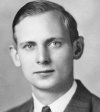 |
|
age he moved with his family to Windsor in Sonoma County, California. He was educated in local schools there and in Santa Rosa. During two years of attendance at Santa Rosa Junior College, he was heavily influenced toward studying the flora of the natural world by his professor of botany Milo Baker. He received a BS degree in botany from UC Berkeley in 1938 and in 1841 an MS from the University of Colorado, Boulder, where one of his professors was Joseph Ewan. In 1946 he was appointed associate professor of biology at the East Central State College at Ada, Oklahoma. Al- |
though he loved his teaching profession, increasing deafness plagued him and he was forced to retire from teaching at the end of the 1949 school year. For the next three years he worked as a botanical assistant to Dr. Herbert Mason who was director of the UC Berkeley herbarium. He then entered the PhD program at Berkeley and in 1952 became a full-time research botanist in the Jepson Herbarium. In addition to his work on Nemacladus, he published a revision of North American Androsace. For some years he was corresponding secretary of the California Botanical Society. He was a fine photographer and amassed a collection of close-up studies of native flowers. He was a member of the Society for the Study of Evolution and the International Association for Plant Taxonomy. He collected with Roxanna Ferris, Paul Clifford Hutchison and others, and also with Rimo Bacigalupi who wrote a memorial article about him in Madroño, Volume 15 (1960), including these words: “Tom Robbins’ outstanding characteristics were his gentleness, charity in judgement, an unusual ability to keep his own counsel, a passion for accuracy, and a tendency to reserve his judgement, either botanical or otherwise, until all pertinent data had been assessed and ‘digested.’ ” A letter from Ewan describes one of his most valuable assets as his “meticulous care, almost fanatical, in the handling of records, and extreme interest in assembling all the pertinent literature on a topic before committing himself by way of a botanical judgement.” He died just a few days after his 44th birthday. Collections of his are at the New York Botanical Garden Steere Herbarium and at the Jepson Herbarium at Berkeley. Lacking any further information, one can only speculate as to the cause of his untimely and unfortunate death. (Nemacladus secundiflorus var. robbinsii, Orobanche robbinsii) (Photo credit: Find-a-Grave)
- robbins'ii: named for physician and amateur botanist James Watson Robbins (1801-1879). He was born in Colebrook, Connecticut, and received his undergraduate and doctoral degrees from Yale, graduating in 1822, and teaching school in Connecticut and Virginia for several years, while at the same time collecting plants in New England, Virginia, Maryland and near Lake Superior. In 1824 he served as a private tutor in Pamunkey, Maryland at the home of Congressman William Brent of Louisiana, and then was at a school in Gordonsville, Virginia, where he included among his students the future General Robert E. Lee. In 1825 he returned to New Haven and studied medicine, graduating in 1828 from Yale Medical School where he came under the influence of Professor Eli Ives. He spent six months of the following year in a botanical exploration of the New England states. He settled in Uxbridge, Massachusetts where he practiced medicine for 30 years all the while being devoted to botany. In 1859 he accepted an appointment as physician and surgeon of several copper mining companies near Portage Lake, Lake Superior, Michigan. Wikipedia says: “During his professional life he had devoted himself largely to botany, gathering a valuable library, second, it is believed, to no private botanical library in the country; and in the four years of his residence near Lake Superior, he made extensive botanical researches, and these were followed by a tour in 1863-1864 down the Mississippi to Texas and Cuba, which resulted in very valuable collections. He then returned to Uxbridge, where he spent the remainder of his life, mostly retired from medical practice and devoting his leisure to his favorite pursuit. He died there, January 10, 1879, in his 78th year, of a disease of the kidneys, caused by the presence of trichinae. He was unmarried.” Near the end of his life he mainly focused on the study of 'aquatic phaenogamous plants,' especially the genus Potamogeton. He was the first to describe Potamogeton robbinsii and toward the end of his life he was engaged in a systematic study of a large collection of California flora. He was the author of Potamogetons of California. (Potamogeton robbinsii)
- robertia'num: uncertain but possibly derives from the medieval Latin name herba roberti or herb robert (Geranium
 |
|
robertianum) which was probably named for Robertus (Saint Robert de Turlande) (c.1000-1067), a French ecclesiastic and monk who was the founder of the Carthusians and died in 1067. He is best known for the establishment of the Benedictine convent of La Chaise-Dieu ('Home of God') and for his total commitment to the poor. Quoted from Wikipedia: “Robert's education was overseen at the Church of Saint-Julien in Brioude where he later became its canon after he was ordained to the priesthood in 1026 - it was there that he founded a hospice for the poor of the region. He later |
became a monk at Cluny and placed himself under the direction of Saint Odilo. He traveled to Rome and later Monte Cassino in the Papal States to educate himself in the rule of Saint Benedict of Nursia who established the Benedictines. On 28 December 1043 - with the knights Stephen Chaliers and Dalmas - he traveled to a vacant area of land around a ruined chapel that was to become his future Benedictine convent. In 1046 he and two of his companions received the permission of Pope Gregory VI to establish a hermitage and embark on a life of commitment to the poor. It was Gregory VI who suggested that the trio consider the contemplative life as a greater method of achieving their aim of providing for the poor; this prompted him to move to Auvergne. He has been credited to the construction and the restoration of around a total of 50 churches in his region. Around 1049 he had amassed numerous followers to the extent that he had to use donations from the faithful given to him to construct a new Benedictine convent; construction began in 1049 and concluded in 1050. The convent received the endorsement of the Bishop of Clermont before he set out for monarchial approval. He approached King Henry I and requested that he promulgate a decree that provided protection and approval to the new convent. Robert de Turlande died on 17 April 1067 and his funeral was set on 24 April due to the large numbers of people who desired visiting his remains. Hundreds of miracles were reported to have been performed due to his intercession which started a local 'cultus' to him. He was interred in his own convent though most of his relics were burnt due to the Huguenots. There were 300 monks at the convent at the time of his death. On 19 September 1531 he was proclaimed a saint in a celebration that Pope Clement VI presided over in Avignon while the papal see was stationed there. Robert served as a spiritual inspiration to the pontiff who himself desired to be interred at La Chaise-Dieu after his own death in 1532. The pope had started his religious career there as a monk.” Other sources have suggested that the name relates to [St.?] Rupert, Archbishop of Salszburg who died 717, Robert, Duke of Normandy (died 1134), or the French monk St. Robert of Molesme (died in 1110). The website Ireland's Wildlife says "The name Herb Robert is thought to come from the Latin ruber, meaning red; but an alternative explanation is that the plant was named after Robert, an early duke of Normandy who commissioned a celebrated mediaeval medical treatise. Yet another theory suggests that the name stems from the Robin (a diminutive form of Robert) of Robin Goodfellow, the impish sprite from English folklore also known as Puck who was immortalised by William Shakespeare in his play 'A Midsummer Night’s Dream.' " And the Woodland Trust says "Herb-robert is thought to have gained its name from an ancient association with Robin Goodfellow, a house goblin from English folklore also known as Puck. That said, some think it was named after an 11th-century monk who cured many people using the plant," while the website Native Plant Trust Go Botany says "Herb-Robert is a native geranium that may have been named after Saint Robert of Molesme (1028-1111), an herbalist, or after the notorious Robert Goodfellow, also known as Robin Hood." The Metropolitan Museum of Art says: "Herb Robert (Geranium robertianum), called ruprechtskraut in German, is sometimes said to derive its name from the seventh-century Saint Rupert or Robert of Salzburg, but the plant is also associated with the German hobgoblin Knecht Ruprecht and his English counterpart, Robin Goodfellow." I include these varying and suggestive etymologies because no one really knows where the name came from.
- robert'ii: named for Gaspard Nicolas Robert (1776-1857), a French pharmacist, botanist, and horticulturist at the Botanical Garden of Toulon. In 1794 he was assistant gardener there and was promoted to botanist gardener in 1801, following which he went to Corsica to manage the newly created garden in Ajaccio, and collected many plants on the island before returning to Toulon. He was made the assistant to the elderly botanist François Martin, and after his death in 1817 became the director. Robert was held in the esteem of the great botanists of the capital to such an extent that one of them named a new plant Robertia. He kept up correspondence with the Muséum and published in 1821 a Catalogue des plantes cultivées au jardin botanique de la marine du port de Toulon. Robert was the first in France to grow the loquat (Eriobotrya japonica). Toulon’s was a model garden for the rarity and beauty of the specimens exhibited. He retired in November 1847. (Polygonum robertii)
- rob'ertii: named for Robert Thorbjørn Porsild (1898-1977), a Danish-born Canadian botanist, naturalist and plant collector, son of Danish botanist Morten Pedersen Porsild who worked most of his life in Greenland, and brother of Canadian botanist Alf Erling Porsild with whom he transported and established a herd of reindeer from Alaska to the Mackenzie Delta in the Northwest Territories. He spent his childhood in Greenland and moved back to Denmark in 1914 to finish high school and begin studies at the University of Copenhagen. His time there was cut short by illness and he did not receive a degree. He was married in 1930 and had five children. He had a contract with the Canadian government to explore the western Arctic as a suitable area for raising reindeer. He worked as a gold miner and trapper at Sixtymile, Yukon, then as a construction worker, boat builder and carpenter. He built Johnson's Crossing Lodge on the Alaska Highway and managed it for twenty years. From 1966 to 1968 he had a contract with the National Museums of Canada to collect, catalog and preserve wildflowers in the central Yukon. He collected many plants around the Whitehorse, Yukon, area where he lived and he died there in 1977. Calamagrostis robertii (synonym of Calamagrostis stricta) was named in his honor by his brother whose collections included 80 species new to science and who had many taxa named for him.
- robertsia'na: named for Anna Brown Roberts (Mrs. John Allan Roberts) (1929- ), a Canadian plant collector, writer,
 |
|
potter and botanical illustrator who drew the illustrations for willows, grasses, sedges and rushes of The Plants of Northern British Columbia by Jim Pojar and Andy MacKinnon. She was very instrumental in the development of the Scout Island Nature Centre at Williams Lake, British Columbia, and is a founding member of the Cariboo Potters Guild. She earned a bachelor of science degree in plant pathology at McGill University in Montreal and worked in the plant pathology field for the government in Ottawa for eight years before she and her husband, John, a |
longtime lakecity veterinary surgeon and historian, moved to Williams Lake in 1958 where they raised their three children and she worked for the Forest Service for a number of years collecting native plants and creating a herbarium record of where the various species of plants can be found. Her countless natural history walks and presentations on topics from bats to lichens have inspired many to follow in her path. Her numerous published natural history guides and detailed inventories of plants and animals have established Roberts as a well recognized and respected contributor to ecological knowledge of the region. She was the first executive of the Williams Lake Field Naturalists Club. Her illustrations were included in the Plant Indicator Guide for Northern British Columbia: Boreal, Sub-Boreal and Subalpine Biogeoclimatic Zones put out by the British Columbia Ministry of Forests. (Photo credit: Williams Lake Tribune)
- robertson'ii: named for Ronald (‘Ron’) Gene Artherholt Robertson (1945-2009), an American bryologist and plant collector. An obituary in the Santa Rosa Press Democrat reads: “Ron, who taught biology in the Sonoma Valley School system for thirty one years, until his retirement in 2006, was born in Earlimart, California, to Wanda Massey, a single mother who immigrated to the California Central Valley from Tupelo, Oklahoma, after the Great Dust Bowl. The family moved often in his youth. He met his future wife, Judy Robertson, in the sixth grade at the John S. Park Elementary School in Las Vegas, Nevada, where as a boy of eleven he took his first solitary hike through the Charleston mountain range and returned with a nascent love for the plants, animals, and topography of the Great Basin ecosystem. In his senior year of high school, he supported himself by working the night shift as a dishwasher in several casinos. He graduated at the top of his class, and was awarded an engineering scholarship to the Colorado School of Mines, a world-class mineral and petroleum engineering university in Golden, Colorado. He later attended the University of California at Berkeley on the GI bill, after serving in the United States Marine Corps, and graduated with a degree in biology. He was an avid naturalist and lepidopterist who worked with the California Academy of Sciences, and tirelessly conducted research on noctuid moths. Five moth species, and one species of moss, have been named for him, and his collections can be found in herbariums at UC Davis, UC Berkeley, and Sonoma State University. He was a member of the California Lichen Association, the British Lichen Society, and the Lepidopterist Society. He was a close and careful reader of literary fiction and a lifelong student of theology. He believed in hard work in the face of obstacles, the enduring power of the written word, and the ecological mystery of the American Southwest, where he ultimately found the greatest peace.” His wife Judith was a former president of the California Lichen Society, and an expert on local lichens.
- Robin'ia: named for Jean Robin (1550-1629) of Paris, a French botanist, herbalist, gardener to Henri IV and Louis
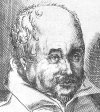 |
|
XIII, curator of the botanical garden of the Paris Faculty of Medicine
who first cultivated the locust tree in Europe in the 16th century
after receiving plants from Canada. His son, Jean
Robin, Jr., also called Vespasien (1579-1662), was appointed a lecturer in what would become the Jardin Royal des Plantes, traveled abroad to collect plants, and added significantly to the Paris gardens. Robin Sr. had constructed a private garden at the downstream end of the Île de la Cité in Paris which contained rare plants from the Orient, Africa, the West Indies and some from North and South |
America. He carried on an exchange of plants, sending specimens to John Gerard and John Tradescant the Elder in England and Gaspard Bauhin in Switzerland, and receiving Virginia plants from England. He published a number of works including Catalogue of plants local or exotic cultivated in Paris in 1601, The garden of the good christian King Henry IV in 1608 and The garden of King Louis XIII in 1623. The Encyclopedia Britannica says that the best known species of Robinia, pseudoacacia, was introduced into Europe at the Jardin du Roi at Paris in 1636. Henry IV's queen personally visited Robin's garden on the Île de la Cité and promoted flower painting and flower embroidery as well as gardening. The genus Robinia was originally named in 1753 by Carl Linnaeus.
- robinsonia'na/robinson'ii: named for Benjamin Lincoln Robinson (1864-1935), an American botanist. The following is
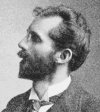 |
|
quoted from the Archives
of the Gray Herbarium at Harvard: "Benjamin Lincoln Robinson
was born on Nov.8, 1864, in Bloomington, IL, the youngest of eight
children. He received his early education at home and then attended
public schools and Illinois Normal School. He entered Williams College
in 1883, but was dissatisfied with the school and left after three
months. The following fall he entered Harvard, graduating in 1887.
Shortly after graduation he married Margaret Louise Casson, and they
traveled to Europe together in the summer of 1887. They settled in |
Strassburg, where Robinson began graduate studies in Oct. 1887. He
received his PhD in Strassburg in 1889 and in 1890 returned to Cambridge,
where he became Sereno Watson's assistant at the Gray Herbarium. Upon
the death of Watson in 1892, Robinson took over as curator, a post
he retained for most of his life. After becoming curator, much of
Robinson's energies were directed toward completing work begun by
his predecessors and toward improving the physical plant of the herbarium.
Robinson took up Watson's work on Gray's Synoptical Flora of North
America and had the first two fascicles published in 1895 and 1897,
respectively. He continued to work for a while on a third fascicle,
but it was never published. With the collaboration of Merritt Lyndon
Fernald, Robinson prepared a revised edition of Gray's Manual, which
was published in 1908. From about 1900 to 1909 Robinson tried to have
a new herbarium building constructed in the general location of the
current herbarium; eventually he settled for reconstructing the building
at the Botanic Garden. Robinson did much of the design work himself,
and the rebuilding took place from 1909-1915. Robinson's main personal
research interest was the Eupatorium tribe of the Compositae. Robinson
worked on a treatment of the Eupatoriums for Engler's Pflanzenreich,
possibly in response to a Dec. 5, 1904, letter from Engler (see Gray
Herbarium, Administrative Correspondence File under Engler) requesting
a "Tüchtigen Systematiker" at Harvard to work on Eupatorium.
The work was never published, as either Robinson or Engler decided
that more work had to be done on certain areas of Eupatorium before
a satisfactory treatment could be prepared, and monographing Eupatoriums dominated Robinson's research for the rest of his life. Earlier research
work included a Flora of the Galapagos Islands, published in 1902,
based on the collections of the Hopkins-Standford Expedition. Robinson
made a collection trip to Newfoundland in 1894 and collected plants
near his summer home in Jaffrey, N.H., but otherwise did not do much
collecting. Although he was appointed Asa Gray professor in 1899,
Robinson was not active in teaching. Robinson was involved in a number
of scientific organizations, was a fouding member of the New England
Botanic Club, and served as editor of Rhodora for many years.
He took an active role in the discussions of nomenclature that were
being carried out in the International Botanical Congresses, and he
participated in at least two Congresses that took place in Europe
(1905 in Vienna and 1910 in Brussels). He traveled to Europe a half-dozen
times, visiting herbaria, making notes and taking photos of specimens,
especially of Eupatorium. Robinson spent the last few years of his
life in poor health and died on July 27, 1935, at Jaffrey, N.H." (Lepidium virginicum var. robinsonii)
- robinson'ii: named for William Robinson (1838-1935), a horticulturist considered by many as the ‘Father of the
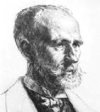 |
|
English flower garden.’ Next to nothing is known about his early years except the country of his birth, the names of his parents, his religious affiliation as a Protestant, and the fact that he may or may not have had a brother and sister. Wikipedia says that he “was an Irish practical gardener and journalist whose ideas about wild gardening spurred the movement that led to the popularizing of the English cottage garden, a parallel to the search for honest simplicity and vernacular style of the British Arts and Crafts movement. Robinson is credited as an early practitioner of the mixed |
herbaceous border of hardy perennial plants, a champion too of the ‘wild garden,’ who vanquished the high Victorian pattern garden of planted-out bedding schemes. Robinson's new approach to gardening gained popularity through his magazines and several books—particularly The Wild Garden, illustrated by Alfred Parsons, and The English Flower Garden. Robinson advocated more natural and less formal-looking plantings of hardy perennials, shrubs, and climbers, and reacted against the High Victorian patterned gardening, which used tropical materials grown in greenhouses. He railed against standard roses, statuary, sham Italian gardens, and other artifices common in gardening at the time. Modern gardening practices first introduced by Robinson include using alpine plants in rock gardens, dense plantings of perennials and groundcovers that expose no bare soil, use of hardy perennials and native plants, and large plantings of perennials in natural-looking drifts.” He probably received some education at a local parish school and began working as a ‘garden-boy’ for the Marquess of Waterford at Curraghmore, County Waterford, then went to the estate of an Irish baronet in Ballykilcavan, County Laois, Sir Hunt Johnson-Walsh, and was put in charge of a large number of greenhouses at the age of 21. A couple of years later in 1861, he went to Dublin where the help of a family friend secured him a position at the botanical gardens of Regent's Park, London. In 1866, at the age of 29, he became a fellow of the Linnean Society under the sponsorship of Charles Darwin, James Veitch, David Moore, and seven other distinguished botanists and horticulturists. He began writing for The Gardener's Chronicle and represented the leading horticultural firm of Veitch at the 1867 Paris Exhibition. He wrote and published Gleanings from French Gardens in 1868, The Parks, Gardens, and Promenades of Paris in 1869, and Alpine Flowers for Gardens and The Wild Garden in 1870. In 1871 he began his own gardening journal entitled The Garden, which continued in publication for over 50 years. In 1883 he published The English Flower Garden, another vastly influential work considered for decades as a bible and probably one of the widest read gardening books ever written, and in 1884 purchased a country manor with 200 acres of pasture and woodland, a property that eventually grew to 1000 acres and permitted him to fulfil many of his ideas of a natural style of gardening. He planted hundreds of trees including some from his American friend and fellow landscaper Frederick Law Olmstead, and created a water garden with one of the largest collections of water lilies in Europe. After his death, the manor was left to the Forestry Commission which sadly neglected its management for many years. Today it has been refurbished and is a hotel and restaurant. Robinson introduced many ideas that have now become commonplace, the most significant of which was that of wild gardening where large drifts of native hardy perennial plants were placed in meadow, woodand, and waterside locations. It is known that he visited France, the Alps and the United States, traveling by rail as far west as San Francisco, and he was elected to the Royal Horticultural Society in 1903. The Garden was not his only foray into the world of gardening magazines but was followed by La Semaine Française (1878–1883), Gardening (1879, later entitled Gardening Illustrated), The Garden Annual, Almanack and Address Book (1881), Farm and Home (1882), Woods and Forests (1883, merged with The Garden, 1886), Cottage Gardening (1892–98), and Flora and Sylva (1903–05). He was not a glory hound and refused the Victoria medal of honor from the Royal Horticultural Society, while an offered knighthood was politely declined. He was injured in a fall in 1909 resulting in paralysis and was confined to a wheelchair for the remaining sixteen years of his life. (Penstemon menziesii var. robinsonii) (Photo credit: Oxford Dictionary of National Biography)
- robison'ii: named for botanist and geographer William Condit Robison (1914-1992). He received an AB degree in botany from UCLA in 1936, an MA in geography from Berkeley in 1949, and a PhD in geography from Boston University in 1960. From 1951 to 1862 he was a geographer in the Quartermaster Corps, US Army. He then became a lecturer in geography at the University of New England, Australia, a position he held 1962-1964. From 1964 to 1971 he was employed in a supervisory position again as a geographer for the US Army Natick Labs, and then went to work as supervisory geography chief of Geosystems Branch, US Army Topography Labs. He was a researcher on conservation policy and the effects of human activity on vegetation. He collected with Epling and others while at UCLA. He was the author of Historical Geography of the Santa Cruz Mountain Redwoods (1949) and Cultural Plant Geography of the Middle Appalachians (1960).
- Robson'ia: named for Edward Robson (1763-1813), a lifelong Quaker botanist, linen draper of Darlington, and associate of the Linnean Society. He was the likely author of Plantae rariores agro Dunelmensi indigenae (1798) although it has been attributed to his uncle the botanist Stephen Robson, who was the author of British Flora in 1777, and who undoubtedly influenced his choice of a career. In later years he was to pass this interest on to his own nephew, James Backhouse, who also became a botanist. He was born at Darlington, County Durham, the eldest of eleven children of Thomas Robson, and was likely trained in the linen trade by his father. Edward was considered to be a highly competent and accomplished botanist and draughtsman, and was regarded by James Edward Smith, President of the Linnean Society, as a very assiduous and accurate worker in the field. His nephew described him as a man of clear perception and inflexible integrity. He was a correspondent of William Withering and of Sir James Edward Smith, contributed various descriptions to the latter's English Botany, the lists of plants in Brewster's Stockton and Hutchinson's Durham, the description and figure of an earth-star (Geaster) in the Gentleman's Magazine for February 1792, and the description of Ribes spicatum in the Transactions of the Linnean Society. He was elected one of the first associates of that society in 1789. He compiled a list of the rarer plants of Durham County (Plantae variores agro dunelmensi indigenae) which was circulated widely to contemporary botanists. He was a keen landscape painter, often arising at four in the morning in order to engage in this pastime. He married, on 4 July 1788, Elizabeth Dearman, by whom he had two sons and a daughter. Towards the end of his life he endured ill health and he died of heart disease at Tottenham, Middlesex, where he had traveled to seek medical advice, and was buried at Bunhill Fields.
The genus Robsonia was published by Heinrich Gottlieb Ludwig Reichenbach in 1837.
- ro'bur: from the Latin robur for "hard timber" or "oak," and, by metaphorical extension, "strength." The taxon in the California flora is Quercus robur, commonly called the English oak.
- robus'ta/robus'tum: stout or strong in growth.
- robus'tior: I can only assume that this name
has something to do with a quality of being robust, and if the meanings
of brevior as "shorter" and latior as "broader"
are correct, this would then mean "more robust."
- robus'tius: robust.
- Rochel'ia: named for Anton Rochel (1770-1847), an Austrian surgeon, naturalist, and botanist at the University of Budapest. He was born in Neunkirchen am Steinfelde in lower Austria. His mother died early and he was sent to relatives to attend a Jesuit school. He devoted himself to surgery and was apprenticed to a surgeon in 1785. In 1788 he became a ‘wound surgeon,’ and joined the Austrian army. He was in several battles in the Austro-Turkish war, after which he returned to Vienna to complete his medical studies. At the end of September, 1792 he received a ChM degree and was admitted to the post of master of surgery, soon thereafter becoming an obstetrician. He was again in the military in 1798 but was soon released from the imperial survice. He lived for a time in France, Belgium and Holland, but was back in Austria by the end of the year. He worked as a physician in Moravia for two years and then in Hungary until 1820. He devoted himself to a study of the Carpathians, particularly its flora, and this eventually caused him to relinquish his medical practice and take up botany. At 1820 he took the position of curator at the botanical garden in Pest, then an independent community, now part of Budapest. He was the author of Plantae Banatus rariores: iconibus et descriptionibus illustratae (1828) and Botanische Reise in das Banat im Jahre 1835 nebst Gelegenheits-Bemerkungen (1838). He also published Naturhistorische Miscellen über den nordwestlichen Karpath in Ober-Ungarn. Pest. He was also made a member of the botanical societies of Regensburg and Marktbreit in Germany. He retired in 1840 and went to Gratz where he died at the age of 77. The genus Rochelia was published in 1824 by Heinrich Gottlieb Ludwig Reichenbach.
- roderick'ii: named for California botanist and horticulturist Wayne Vernon Roderick (1920-2003), who specialized in bulbs, corms and tubers. He got his start at his childhood home of Petaluma by emulating his florist mother and chicken farmer father both of whom were avid gardeners. According to an article by the National Park Service on the Fleming Garden in Berkeley, one of the oldest, largest, and finest privately-owned native plant gardens in California, he “had his first garden by the age of 5, his first rock garden by 16, and his first strains of flowering perennials by 18. In high school, he collected a school record number of wild flowers for a class project and studied Jepson's Manual of the Flowering Plants of California on his own. Roderick‟s first semester of botany, taught by Milo Baker at Santa Rosa Junior College, was cut short by the bombing of Pearl Harbor. He served as an Army cook in Hawaii 1941-1943, and visited gardens while there. He was sent home to convalesce in a tent on the family farm when he contracted tuberculosis, and then worked about 18 months as a fireman at the Army's Two Rock Ranch Signal Intercept Station (now known as the Coast Guard Training Center in Petaluma). After World War II, he and his father ran Roderick Family Nursery 1945-1959, until the death of his father.” As senior nurseryman, he built and managed the California native plant collection of the botanical garden at the University of California, Berkeley, from 1960 to 1976. Then he became director of the Regional Parks Botanical Garden, a position which he held until he retired in 1982. The following is quoted from a memorium article by Ron Lutsko in the October, 2003, issue of Fremontia: "He was an insatiable plant adventurer, beginning each year with trips to Mexico and deserts of the southern US, then progressing up in latitude and altitude as the season drew on. By October or November he had collected enough seed and dried plant materials to put out his internationally distributed seed list and to provide local institutions with educational and ornamental material. He frequented England, Greece and Turkey. He has also visited China, the Middle East, most of the Mediterranean basin, South Africa, Costa Rica, Chile, Mexico, and of course most of the US, particularly the west. He knew the British and American botanical institutions intimately and was active in many horticultural societies and groups throughout the world." He was director of CNPS from 1967 to 1975. He was also a member of the (British) Alpine Garden Society, the western chapter of the American Rock Garden Society, the Association of Arboreta and Botanic Gardens, the Board of the Ruth Bancroft Garden, the Horticulture Committee for The Jepson Manual, Heather Farms, the Pacific Horticulture Foundation, and the San Francisco Businessmen's Garden Club. He was co-author of Wild Lilies, Irises, and Grasses: Gardening with California Monocots.
- Roegner'ia: named for Heinrich Andreas Rögner (1807-1874) of Württemberg, Germany, the former Imperial Russian court gardener at Tbilisi, Georgia,and Oreanda in the Crimea, who was an assistant of the plant author Karl Heinrich Emil Koch and was on friendly terms with him. The genus Roegneria was published by Karl Heinrich Emil (Ludwig) Koch in 1848.
- Roell'ia/roell'ii: named for Julius Röll (1846-1928), German bryologist who collected bryophytes in North America and discovered the only species that belongs in that genus, Roellia (the nomenclaturally correct name of which is now Roellobryon) roellii. He was born in Ostheim vor der Rhön in northern Bavaria as the son of a court official and became one of the most important bryologists of his time. By profession a teacher, he earned his doctorate in 1873 at the university in Jena. He undertook many collecting trips in Europe, to Translyvania, Scandinavia, Spain, North Africa and North America. He reported on his collecting trips in scientific journals and described several previously unknown species of moss. After his retirement in 1911 he moved to the Ore Mountains where he died at the age of 83. His moss collection eventually came into the possession of the University of Würzburg. The genus Roellia was published by Nils Conrad Kindberg in 1897.
- roem'eri: named for Hans Ludwig Roemer (1938- ). A website of the Alpine Garden Club of British Columbia has
 |
|
this to say: "Hans Roemer’s fascination with mountains and their plant life started early when he grew up close to the Alps in southern Germany where he first went hiking and rock climbing, then paying more and more attention to the plants some of which he brought home to grow in a small rock garden. His training, occupations and interests encompassed horticulture (Journeyman 1961), landscape architecture (MSc 1967, Germany), plant ecology (PhD, 1972, University of Victoria), ecological consulting (1973-1976 & 2001-2006), ecological reserves and parks (1979-2001) and |
finally rare plant botany after 'retirement.' Hans has been a member of the Vancouver Island Rock and Alpine Garden Society for the last 35 years and has led numerous field trips to the mountains of Vancouver Island and northern Washington. He has been a contributor to a recent book on alpine plants of the Pacific Northwest (Pojar & MacKinnon 2013)." The following is excerpted from an interview with him in a website of the Friends of Ecological Reserves: "I came from Germany and had a degree that was equivalent to a Masters Degree in landscape ecology and came to Victoria and did a dissertation on forest ecosystems on the Saanich Peninsula, basically southern Vancouver Island. I attended the early meetings of the so-called Reserves committee. This was a big crowd of scientists, foresters and biologists from all over the place. I did go back to Europe later for 2 1⁄2 years. After my father died, we had to get a lot of things in order, but I basically had the intention of coming back. I came back in 1978 and I was offered the ecological reserves job which was vacated by Dr. Jim Pojar. After some sorting out of immigrant status and citizenship I became the ER ecologist. As a plant ecologist I was looking for original native pieces of forest that were undisturbed, especially for those ecosystems that were already becoming uncommon at that time, like the coastal Douglas fir zone where logging was very big in the decades before and only a few places remained, even at that time, that were undisturbed and deserved ecological reserves status. I worked directly for the ER program for 17 years and after that I was still responsible for ecological reserves but others were too. It was (1993) when the administration of ERs was put under BC Parks leadership." (Photo credit: Alpine Garden Club of BC)
- roesea'num: named for August David Friedrich Carl Röse (1821-1873), a German bryologist and teacher born in the village of Kabarz. Educated first at home by his father and his local pastor, he moved to live with a merchant in Leipzig where he devoted himself to music. At the age of 20 he began teaching music, arithmetic and German at the famous educational institution of Schnepfenthal. At some point he became interested in natural history and turned to scientific studies, quickly acquiring a deep knowledge of flora and fauna. In 1852 he began writing a series of essays to make information about the natural sciences more readily accessible. He corresponded with other major German bryologists and sent them samples of things he had collected. He discovered a number of new species and contributed to a geographical distribution of Thuringian mosses. He died after a brief illness at Schnepfenthal.
- roez'lii: named for Benedikt (also called Benito)
Rözl (1824-1885), a Bohemian Czech born in Prague who collected
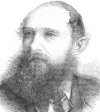 |
|
in Mexico and South America,
and traveled extensively in the US. The following is quoted
from an article by Ruth Ann Moger in Canadian
Orchid Congress Newsletter (9:2): "Roezl was the son of a
Czech gardener, and apprenticed, at the age of twelve, in the gardens
of the Count of Thun in Bohemia. He subsequently worked in several
important continental gardens, including those of Baron von Hugel
at Vienna and Count Liechtenstein in Moravia, and the famous nursery
of Van Houtte at Ghent. In 1854 he emigrated to Mexico, where he founded
a nursery and issued a |
catalogue of the Mexican conifers he had
for sale. In 1861 he introduced the cultivation of the Rame (Boehmeria
tenacissima) as a textile plant. When he was forty-four years old
he lost his left arm in an accident with a machine he had invented
to extract fibers from plants. He then started his life as a plant
collector working for Henry Sander of St. Albans in England. Roezl
traveled Central America and the west coast of North America; he sent
home 10,000 orchids from Panama and Colombia in 1869. The rare Telepogon orchids that he collected at 11,000 feet died as soon as they were
brought down to warmer levels, but he sent 3,000 Odontoglossums to
Europe. He combed the Sierra Madre for orchids, 3,500 of which reached
London in fine condition. He went across the Isthmus of Panama to
Guayra and Caracas and sent eight tons of orchids and ten tons of
other plants back to London. In Mexico, in the vicinity of the volcano
of Colina, the indians learned that Roezl would pay for orchids and
they brought him 100,000 plants. (If parts of Mexico are desert and
devoid of vegetation, is it because Roezl was there?) In 1871, Roezl
brought back to England dried specimens of Dracula chimaera which he had collected in Columbia. When the German Professor Reichenbach
introduced Dracula chimaera to Victorian horticulture, he described
the flowers as a marvel that had lurked for thousands of years unseen
in solitude. Live plants proved a challenge during transportation.
It is frightening to think how many draculas and other fragile orchids
succumbed. Even though there is evidence that the plants seem to have
been recognised as delicate and treated with more care, the vast majority
still perished during the long journey from their homeland. Of 27,000
plants dispatched by Roezl in a consignment from New Granada (in present
day Columbia), just two plants survived the long and disastrous journey
to England. In 1874 Roezl returned to Europe and spent the rest of
his life living off his modest fortune at Smichow near Prague." He visited California in 1869-70, 1872, 1874 and 1875. He collected in the Alleghany, Sierra Nevada and Rocky Mountains, the Columbia River basin, and in Utah and Nevada. He went to San Francisco and then made a southern trip to San Diego the purpose of which was to collect Delphinium cardinale, and he sent to Europe 2,000 roots of what he supposed to be that species, but when they grew and flowered turned out to be one of the blue larkspurs, probably parryi. He also collected Yucca schidigera and Hesperoyucca whipplei. He did not seem to like to stay in one area for too long and traveled around and back and forth continuously, collecting amazing numbers of plants and seeds, and sending thousands of plants to Europe. He discovered and published with his contemporary and colleague Maximilian Leichtlin the name Lilium humboldtii. He was a fantastically prodigious collector, one time collecting 2,000 bulbs of Lilium washingtonianum and 150 kg of Pinus lambertiana seeds. Orchids were his main love and he collected tens of thousands of specimens of many different species. Many specimens were lost either due to frost or heat, and he was supposedly robbed 17 times. (Wikipedia; Botanical Gazette, Dec. 1909; Scientific American, supplement, Dec. 1885).
- roland'ii: named for Albert Edward Roland (1910-1991), a Canadian botanist, author of Geological Background and Physiography of Nova Scotia and co-author with Ernest Chalmers Smith of The Flora of Nova Scotia. He was born in Aylesford, Nova Scotia, and died in Truro, Nova Scotia. A website of the Nova Scotian Institute of Science says: "The herbarium collection at the Nova Scotia Agricultural College is named in honor of Dr. Albert E. Roland, professor emeritus of biology at the NSAC, for his lifelong contribution to the understanding of the natural history of Nova Scotia. Throughout Dr. Roland’s long and productive career as provincial botanist and professor of biology at the NSAC, he authored and co-authored many scientific papers as well as several books including those mentioned above and Spring Wildflowers. In recognition of his numerous contributions to science and agriculture, Dr. Roland received an honorary doctorate from Acadia University in 1972 and the degree of doctor of laws from Dalhousie University in 1980."
- rolland'ii: named for Brother Rolland-Germain (civil name Louis Roland) (1881-1972), a French-Canadian chaplain, botanist and teacher. He was born at The Villaneuve (Saône-et-Loire), France, and was a professor first in Beaune (Côte-d'Or). He arrived in Montreal, Canada from France in 1905 and was at Longueuil College from 1905 to 1914, and then at St-Jean-Baptiste in Ottawa, where he remained until 1926. He was an intimate friend of Brother Marie-Victorin (civil name Joseph-Louis-Conrad Kirouac), a noted botanist in Quebec, member of Brothers of the Christian Schools, and collaborator of the first botanical explorations around the College of Longueuil until the surveys of 1944. Roland was a practical, take charge type and he very well oversaw the work of pressing, assembly and identification, being unafraid to reach dangerous areas where men of lesser determination feared to go. He was an excellent botanist. He died in Laval (Sainte-Dorothée).
- rol'lei: named for Wayne Ernest Rolle (1951- ), graduate of Southern Oregon
State University in 1986 and a forest botanist for the Rogue River-Siskiyou
National Forest in Oregon beginning in 1988. He currently lives in Ashland, Oregon. He got a bachelor of science degree from SOSC (now SOU). He worked in forestry, agriculture and botany, and his interest centered on the flora of southwest Oregon and northwest California.
- Romanzof'fia: named for Count Nikolay Petrovich Rumyantsev (formerly Nikolai Petrovich Romanzoff) (1754-1826),
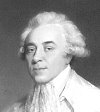 |
|
Chancellor of the Russian Empire, and sponsor of the second Russian Pacific expedition which rounded Cape Horn and visited Chile, Easter Island, the Marshall Islands, Hawaii, and the North American coast, making an unsuccessful search for a northwest passage. The expedition was particularly significant for producing descriptions of Alaska and California (including the first scientific account of the California state flower, the California poppy.) He was born in St. Petersburg the son of field marshal Pyotr Aleksandrovich Rumyantsev. The Encyclopedia Brit- |
annica says the following: “Under Emperor Paul I, Nikolay became a senator; under Alexander I, he was director of water communications (1801–09), minister of commerce (1802–11), and president of the state council (from 1810). In diplomatic affairs he served Russia as envoy to the elector of the Rhenish Palatinate (1781–95) and to the German Diet (appointed 1799). As foreign minister (appointed 1808), he worked for closer relations with France; he was so dismayed by Napoleon I’s invasion of Russia (1812) that he suffered an apoplectic stroke and lost his hearing. Subsequently, his influence in the government declined, and he retired in 1814. The Rumyantsev Museum was founded in 1831, five years after his death.” And Wikipedia adds: “During the years of his foreign service, Nikolay Petrovich amassed a huge collection of historical documents, rare coins, maps, manuscripts, and incunabula (early printed books, especially those printed before 1501) which formed a nucleus of the Rumyantsev Museum in Moscow (subsequently transformed into the State Russian Library). Showing a keen interest in Russian history, Rumyantsev produced the first printed publications of several old Russian chronicles and ancient literary monuments of the eastern Slavs. He presided over a circle of young antiquaries (such as Pavel Stroev and Ivan Snegirev) that later drifted into the Slavophile camp. The genus Romanzoffia was published by Ludolf Karl Adelbert von Chamisso in 1820.
- romanzoffia'na: see previous entry.
- Rom'neya: named for Dr. John Thomas Romney Robinson (1792-1882), a prominent Irish astronomer and physicist.
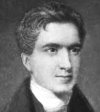 |
|
The namer of the plant Romneya coulteri, the Matilija poppy, William Henry Harvey, wished originally to name it for Dr. Thomas Coulter (see coulteri) who first collected it, but the name Coulteria was an already established genus, so he decided to honor him instead by selecting the name of his great friend and fellow Irishman Robinson for the genus, and that of Dr. Coulter for the species, and in so doing to link their names forever. Robinson and Coulter had met and become friends while at Trinity. Robinson was born in Dublin the son of an English portrait painter, and his |
family shortly after moved to Dromore in County Down, Northern Ireland, then to Lisburn, and finally to Belfast. He showed an early appreciation for music and for poetry, having a volume of poems published when he was only 13. He was schooled at Belfast Academy then studied divinity at Trinity College, Dublin, graduating in 1810 and obtaining a fellowship in 1814 at the age of 21. He took holy orders as an anglican priest while at Trinity and became rector of Enniskillen and then of Carrick-macross. He was for some years a deputy professor of natural philosophy (physics) at Trinity. In 1823 he secured an appointment as astronomer in charge at the Armagh Observatory and lived there for the remainder of his life. From 1851 to 1856 he was president of the Royal Irish Academy and helped to organize the British Association for the Advancement of Science. Astronomy occupied the bulk of his attention and he compiled a catalog of well over 5,000 stars, but his contributions in the fields of science and mechanics included anemometers, pendulum clocks, the determination of longitude, the conductivity of metal, rain guages, meteorology, electricity, magnetism, turbines, air-pumps, gasometers, fog signals, captive balloons and the theories and properties of light. He married twice and had two sons and a daughter. He was a prolific author and died in Armagh at the age of 89.
- Romu'lea: named for Romulus, the legendary founder and first king of Rome in legend. Wikipedia says: "Various
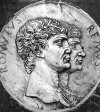 |
|
traditions attribute the establishment of many of Rome's oldest legal, political, religious, and social institutions to Romulus and his contemporaries. Although many of these traditions incorporate elements of folklore, and it is unclear to what extent a historical figure underlies the mythical Romulus, the events and institutions ascribed to him were central to the narrative of Rome's origins and cultural traditions. The myths concerning Romulus involve several distinct episodes and figures: the miraculous birth and youth of Romulus and his twin brother, Remus; Remus' murder |
and the founding of Rome; the Rape of the Sabine Women; the war with the Sabines; Titus Tatius; the establishment of Roman institutions; and the death or apotheosis of Romulus, and succession of Numa Pompilius. Romulus is said to have disappeared in a whirlwind during a sudden and violent storm, as he was reviewing his troops on the Campus Martius. There were rumours that he had been murdered by the nobles, and that his body had been secretly dismembered and buried by them on their estates. However, a certain Proculus Julius claimed to have seen him ascending to the heavens as a god.” Romulus was said to live sometime in the mid- to late-8th century BC. The genus Romulea was published by Giovanni Francesco Maratti in 1772 and I have no idea why it should have been so named, except that the type species of Romulea, bulbocodium, is common around Rome.
- roof'ii: named for James Bernard Roof (1910-1983), founding director
of the native plant garden in Tilden Park in the hills behind Berkeley.
The following is quoted from an obituary by Alice Howard in Fremontia volume 11 No. 1, April 1983: "With the death of James B. Roof
in early January, California lost the last of its pioneering native
plant horticulturists and the California Native Plant Society lost
a dedicated native plant conservationist. Born four years after the
San Francisco earthquake in a refugee's shack, Jim grew up in the
southwest part of San Francisco amidst what was in those days mostly
open country. He was early aware of native plants near his home; he
remembered being impressed at the age of five or six by a big madrone
not far away. He reveled in the fields of spring wildflowers through
which he waded to play around Lake Merced. His first experience with
transplanting seedlings came at the age of ten or eleven when he dug
up volunteers of Monterey cypress growing along a flume going to the
lake. Interest in learning names of trees and shrubs started at age
twelve while Jim was on a family trip to the Rockies and the Grand
Canyon. His father, a master carpenter who had come to San Francisco
to help rebuild it, got him a book to help, but no one in the family
really shared Jim's horticultural and botanical enthusiasm. His family
endeavored to discourage him by dwelling on the lack of jobs in that
field. When barely in his teens, Jim and friends were distracted from
their studies in school by views of Mt. Tamalpais through the windows.
They often 'played hookey' to go there unbeknownst to their
parents. When the Great Depression caused him to lose his outside-of-school
job with the San Francisco Examiner (about the time he finished
high school) and other jobs were not to be had, Jim joined the many
others who fled to Mt. Tamalpais as a place to live off the country
during hard times. The mountain dwellers banded into small groups
with common interests; Jim fell in with actors and others of literary-theatrical
interests. Whether his life-long interest in the performing arts stemmed
from this exposure or whether he chose that group because he already
had the interest is not certain. But he was an aficionado of the theater,
opera, and ballet and a supporter of the annual mountain play on Tamalpais
in his later years. Eventually, during this period, he repaired to
Point Reyes, for the sea proved a more bountiful supplier of provender
than the land as greater numbers of people competed for sustenance.
The special place Tamalpais and the Point Reyes Peninsula had in Jim's
heart deriving from the years in Marin County was apparent to all
who knew him. In the early 1930s peregrinations in search of a little
occasional cash to purchase necessities beyond the bounties of forest
and sea led Jim to the Binkley Ranch in Lake County, where the warm-hearted
Binkley family took him in, commencing a lifetime friendship. Later
he got a job as a forester with the Marin Water District helping plant
trees on watershed lands, an activity he later rued as he grew aware
of the destruction such artificial afforestation brought to native
grasslands and their wildflowers. Plantations of Monterey cypress,
Monterey pines, and eucalyptus were the object of his scorn in later
years, as was the propensity of state and federal government to cover
coastal dunes with aggressive South African iceplant. His developing
horticultural skills brought him to the attention of Charles Kraebel,
who hired him to work at the nursery of the US Forest Service's
California Forest and Range Experiment Station in Berkeley. He was
the propagator in studies on seed germination that expanded into the
erosion control work that gave employment to many plant hunters and
other workers during the depression and the days of the WPA and CCC.
The plant hunters, sometimes including Jim, brought seeds and other
propagative material to the nursery, where Jim germinated the seeds
and grew the plants, eventually becoming superintendent. Aided by
sharp observational powers and keen analytical skills, he honed his
horticultural talents and botanical interests in the company of Rimo
Bacigalupi, Charles J. Kraebel, Howard McMinn, Nicholas Mirov, Maunsell van Rennselaer,
Lester Rowntree, and others. Eager for knowledge, he also started
attending botany classes at the University of California at this time.
It was McMinn, professor of botany at Mills College in Oakland and
author of the Illustrated Manual of California Shrubs, who
pressed for a native-plant botanic garden in the northern part of
the state to complement the ones at Rancho Santa Ana and Santa Barbara
in the south. He prevailed upon Roof, the Forest Service, and the
East Bay Regional Park District to join forces to turn the outstanding
collection of plants in the Forest Service's nursery into the nucleus
of the Regional Parks Botanic Garden. Important support for the idea
came from early park district directors August Vollmer, former Berkeley
police chief and pioneer criminologist at the University of California,
and Aurelia Reinhardt, president of Mills College. Harry Shepherd,
professor in UC's School of Landscape Design, also gave important
support. Building the garden began on January 1, 1940, together with
much landscape planting in the parks outside the area of the garden,
and often involved large crews of CCC and WPA workers. The Strybing
Arboretum in San Francisco also benefited by receiving Forest Service
plants. With some time out for landscaping gun emplacements around
the headlands of San Francisco Bay to camouflage the sites as World
War II approached, things proceeded rapidly until mid-1942, when Roof
was drafted to see service with the Army Corps of Engineers in the
European theater. Lack of labor to care for the young garden during
the war years meant almost beginning anew in early 1946. Roof returned
to a jungle of weeds, poison oak, willows, and waist-high grasses.
With little regular help, let alone large crews from the CCC or WPA,
he started right in to reclaim the garden. It was at this time that
he initiated landscaping in geographic provinces. By 1952 things were
well enough under control that it was possible to begin regular field
collecting trips. Roof early began to emphasize rarities, complete
representation of particular plant groups, and choice forms with horticultural
possibilities. However, he never lost sight of the fact that he had
a California native plant botanic garden; it was not his purpose to
create or facilitate through hybridization forms not occurring in
nature. He denied any special affinity for manzanitas, the group most
closely associated with his name, saying only that he needed to understand
them in order to identify them accurately. Eventually he had in cultivation
sixty-six of the sixty-nine taxonomically recognized kinds in California
and several from beyond its borders. Watching for areas scheduled
for development was an important part of Jim's "rescue"
trips for rare plants and forms in order to bring them into cultivation
prior to their extirpation in the wild. Perhaps the first of these
was Arctostaphylos franciscana (A. uva-ursi var. franciscana),
which he took from the Laurel Hill cemetery in the late 1930s as it
was being converted to residences. The Franciscan manzanita now exists
only in cultivation. Similarly he brought into cultivation Oenothera
deltoides subsp. howellii and Erysimum capitatum var. augustatum from the Antioch Dunes in the late 1960s as their last remnants were
being trucked away, Clarkia franciscana and Arctostaphylos
pungens var. ravenii from the San Francisco Presidio, Lilium
pitkinense from the Pitkin Marsh, and Mahonia sonnet from
the banks of the Truckee, among others. A number of plants from the
Regional Parks Botanic Garden selected from the wild by Jim were the
source of material introduced to the commercial trade by others and
erroneously credited to them. Jim himself especially liked Ceanothus
porrectus, Arctostaphylos uva-ursi var. leobreweri (now
extinct in the wild), A. uva-ursi var. repens, and Eriogonum
ursinum. He was the first to find the key to growing at low elevations
such high mountain plants as Phyllodoce breweri, Cassiope
mertensiana, Kalmia polifolia var. microphylla, dwarf willows, Aquilegia pubescens, and some of the pines, such as bristle-cone,
whitebark, and limber. The Sierran meadow he created in the botanic
garden, complete with quaking aspen, which was not supposed to do
well at low elevations, was featured in sketches in the chapter on
native plants in early editions of the Sunset Western Garden Book.
He wrote on native plants in articles in Leaflets of Western Botany, The Four Seasons and The Changing Seasons, the Journal of
the California Horticultural Society, and periodicals of CNPS.
Jim's Guide to the Plant Species of the Regional Parks Botanic
Garden was much more than a checklist of the species to be found
there. Occasional inclusion of the human stories associated with many
of the plantings made it also pleasurable to read. It is regrettable
that Jim was never able to revise it to add the many acquisitions,
some of great significance, between 1959 and his retirement as director
of the garden in 1976. Never one to shrink from controversy and always
independent in thought and action, Jim, as the result of careful observation,
was preaching the benefits of prescribed burning years before it began
to compete with the Forest Service's long-standing Smokey-Bear philosophy
of fire suppression. One learned much from hearing him hold forth
on the philosophical differences between parks and recreation and
the consequences of recent tendencies to confuse the two. The California
Native Plant Society benefited from Jim's knowledge from its inception
in 1965 as an outgrowth of an effort to defend the Regional Parks
Botanic Garden from a non-supportive new administration. He served
on the statewide board several terms as vice- president, was a director
for many years, and continued to be horticultural advisor up to his
death. He served two terms as president of the San Francisco Bay Chapter
and, sponsored by the Marin Chapter, was named a fellow of the Society
in 1976. He also played a key role in passage of the state's endangered
plant law. It was a remark of his that made me seek out Senator John
Nejedly to sponsor the legislation. Without Senator Nejedly's legislative
skills and influence, the struggle for the bill would surely have
been a much longer and harder one. A person of complete integrity
and the courage of his convictions, Jim was also an outstanding raconteur
with something approaching total recall of the events of a varied
and interesting life. It is most unfortunate that he and I were not
able to complete the oral history taping we had begun when he learned
of his final adversary. We turned instead to an effort once again
to save native plants - preparation of recovery plans for the Presidio
manzanita and the Truckee mahonia for the US Fish and Wildlife Service's
Endangered Species Program. Jim was a genius in his field, though
he would have said he was only doing what careful observation of the
plants in their native habitat told him to do. We are not likely to
see another like him."
- roosior'um: named for Dr. Alfred Raphael Roos (1889-1980), his son Dr.
John Christian Roos (1918-2008) and Lucille J. Parks Roos (Mrs. John
Christian Roos) (1922-2018). From an article in the L.A. Times 10/13/1980 entitled "Doctor Wore Out Two Cars Seeking Causes
of Allergies": "In another time and another place, Alfred
Roos might have accepted chickens and eggs for his medical services
in the great country-doctor tradition. He didn't, however, because
chickens in the early 1920s in Southern California were rapidly being
displaced by homes and factories. What Dr. Roos did do was donate
tens of thousands of hours and what could have been millions of dollars
in income to fighting allergies in children. Hailed by his colleagues
at a 1955 tribute as a 'giant of goodness.' the devout Seventh-day
Adventist continued nearly to the time of his death Oct. 6 at age
91 to give of his services. Interviewed in 1970 when he was 'only'
81, Roos talked of the years he had spent at California and White
Memorial Hospitals, where a memorial service will be held for him
today. Roos came relatively late to medicine. He entered Loma Linda
University School of Medicine in 1913, when he was 24. Earlier he had
'taught botany and it was that avocation which moved him to become
one of the first men in medicine to pursue a link between pollens
and allergies.' After reading a textbook on bacteriology and immunology,
he began to theorize that pollen extracts could be used to protect
people with allergies. That hypothesis was to take him across the
United States to collect pollens from which he distilled his own extracts.
He tested those extracts by pricking the top layer of skin on a patient's
arm to see what reactions developed. If a slight swelling showed,
Roos then knew that the patient was allergic to grass or bark or pollen.
The next step was treatment with dilutions of the extract to build
an immunity. Fifteen years, two cars and 150,000 miles later Roos
had finished his basic research in which he made more than 100,000
skin tests. Out of his work grew the allergy clinic at White Memorial
which he founded and where he even lived in the later years of his
life, continuing his volunteer efforts for community children. Allergies,
he told an interviewer, remained an elusive target throughtout his
life. He liked to tell of the 'brain tumor' victim referred to him
by doctors who had made a diagnosis but couldn't locate her tumor.
Roos found it was the grass and desert pollens near her home that
made her blind and mute for days at a time, not the hypothetical tumor
that had been diagnosed. Roos saw young asthmatic victims grow to
become track stars through his treatments and more than four decades
ago was one of the first scientists to determine that non-smokers
in close proximity to smokers could also suffer respiratory ailments.
At 6-foot, 4-inches Roos was an imposing figure who until a few years
ago was still working 50 and 60 hours, six days a week. 'I have not
yet become accustomed to the 40-hour week,' he said then. Besides,
he said, 'I never think of the time. The work is so rewarding.'
He was also a member of the Samuel B. Parish Botanical Society of
Southern California and author of a book on a botanical survey of
Southern California showing the distribution of plants of allergic
importance and their extensions throughout the Pacific Southwest,
1938." John Christian Roos was born in Los Angeles and got his BA at Pacific Union College in 1941 and his MD in 1944 at the College of Medical Evangelists (later to become Loma Linda University). His specialties were human pathologic anatomy, taxonomic botany and plant exploration, and he had a particular interest in and spent a lot of time botanizing in the White and Inyo Mountains. His wife Lucille graduated from Pacific Union College in 1943. His write-up on Find-a-Grave says: “Dr. Roos enjoyed nature, plants, camping, back packing and hiking. His special interest was the study of botany, discovering several new species of plants in SE California while on his outdoor explorations. He was still climbing 11,000-foot mountains at the age of 85 and continued his interest of nature at his home after his retirement. Dr. Roos attended La Sierra University and Pacific Union College for his undergraduate studies. He earned his MD degree from Loma Linda University School of Medicine in 1944, and then immediately joined the Army as a battalion surgeon in the 540th Field Artillery Battalion. He served in France in World War II. In 1947 he fell in love and married Lucille J. Parks, a nurse at Loma Linda University Medical Center. Dr. Roos specialized in pathology medicine. He practiced in Loma Linda and Hemet, California, and then in Roseburg, Oregon. In Roseburg he practiced at the Douglas Community Hospital, Mercy Medical Center and the Roseburg V.A. Hospital retiring in 1988. He spent many years serving the community as a medical examiner here in Douglas County as well as in California.” The 'orum' ending of the specific epithet is used when there are several people being honored.
- Rorip'pa: Stearn, Gledhill and FNA all say "Latinized from a Saxon vernacular name rorippen which was mentioned by Euricius Cordus but whose meaning has been lost." Euricius Cordus born Heinrich Ritze (1486-1535) was a German humanist poet, physician, botanist and naturalist. He is considered one of the founders of botany in Germany. An alternative derivation is suggested by several websites including SEINet which is that "Rorippa possibly comes from the Latin roro, meaning "to be moist," and ripa, meaning riverbank." The genus Rorippa was published by Joannes Antonius Scopoli in 1760.
- Ro'sa: an ancient Latin name whose meaning has
been lost, from rosa, literally "rose." The genus Rosa was published by Carl Linnaeus in 1753 and is called rose.
- rosa'cea/rosa'ceus: rose-like.
- rosamonden'se: named for Rosamond Dry Lake north of Lancaster. The single taxon in California with this epithet is Eriastrum rosamondense.
- rosamros'iae: named for Rosa María Ros-Espín (1959- ), a botany professor, bryologist and biogeographer affiliated
 |
|
with the Department of Biology at the University of Murcia in Murcia, Spain. She is the director and creator of the "Science in action" program whose objective is to reactivate science in different academic fields. The following is quoted from her website: “I started my scientific career in 1982 in the field of botany with the study of the flora and vegetation bryophyte of the Spanish SE [South East?]. Later I dedicated myself to the taxonomy of the mosses of arid zones, initially with techniques based on morphology and from the year 2001 with molecular techniques. On the basis |
of the experience acquired with the latter I have studied various aspects of the biology of bryophytes. I count in my CV with 121 publications in journals included in the JCR [Journal Citation Reports], in addition to 41 in journals without an impact index, 5 books and 17 book chapters. My main lines of research include the effects of climate change on bryophytes through the study of altitudinal transects in Mediterranean mountain areas using as a study model species of cosmopolitan distribution such as Bryum argenteum, Ceratodon purpureus and Funrome hygrometrica and the molecular adaptation of these species to the environmental conditions in which they develop; bryophytic flora and vegetation in Mediterranean areas; the systematic and molecular phylogeny in bryophytes; the phylogeography of mosses, especially the origin and diversification of species; and ex situ conservation of bryophytes by performing in vitro cultures and cryopreservation. I have been IP (?) of 20 competitive research projects (7 in the last 10 years) and 2 non-competitive projects; I have participated as a member of the research team in 24 other projects. I have directed 7 doctoral theses. I have presented 122 communications to congresses and participated in a relevant way (invitation conference, session chair or member of the scientific committee) in another 14. I have five live research sections. I am an associate editor for the scientific journal Cryptogamie, Bryologie since January 2014. I am IP of a research group at the University of Murcia since 2010. I was a member of the Advisory Committee on Nature Sciences of the National Commission for the Evaluation of Research Activity (CNEAI) during the years 2005 and 2006 and coordinator of the thematic area of Plant Biology, Animal and Ecology of the ANEP of the Commission for the evaluation of scholarships for University Teacher Training (FPU) during the calls from 2006 to 2010 and coordinator of the Scientific Culture and Research Promotion Unit of the University of Murcia during 2015 and 2016.” (Photo credit: website of Rosa María Ros)
- ros'ea/ros'eum: rosy-colored.
- rose'ae: named for Lewis Beatrice "Lou" Sims (Mrs. Joseph Nelson Rose) (1864-1932). She was born in Delphi, Indiana, her father being one of Delphi's pioneer lawyers. Her mother died when she was a youth but her place was taken by a devoted aunt. She attended the public schools of Delphi and graduated with the class of 1883. She was married in 1888 and lived in Washington, DC until her death four years after that of her husband. Her life was also marred by the death of her son, Walter Deane, while a high school student. She had three daughters and two other sons. I have been unable to find out much about her connection with botany but she is listed as a botanist and plant collector by the Harvard University Herbaria and Wikipedia, as is her husband, who published the genus name Raimannia in 1913 and has a very significant botanical background (see following entry).
- rosea'na/rosea'num/ros'ei: named for Joseph Nelson Rose (1862-1928), an American botanist and prolific writer born
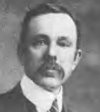 |
|
on a farm in Union County, Indiana. His father died at Vicksburg during the Civil War when Joseph was a boy. He was quiet and serious and showed an early love of flowers. He attended local public schools and graduated from high school in Liberty, Indiana and received a BA degree in biology, an AM in paleobotany and in 1889 a PhD in biology all from Wabash College. During his final two years in college he served as an assistant to the eminent botanist Dr. John Coulter. He also engaged in botanical studies at the Gray Herbarium, the Royal Botanical Gardens at Kew, England, and |
in Geneva, Switzerland, Berlin, Germany, and other European cities. In 1888 he married Lou B. Sims and they eventually had four children. Shortly after his marriage he was employed as assistant botanist in the Department of Agriculture in Washington, D.C. When the National Herbarium was reorganized in 1896 and its management transferred to the Smithsonian Institution, he became assistant curator (1896-1905), and associate curator (1905-1912 and 1922-1928). From 1908 to 1918 he was vice-president of Washington Academy. In 1907 he was vice-president of the Washington Botanical Society, and from 1909 to 1918 vice-president and then president of the Washington Biological Society. In 1925 he received an LlD from Wabash College. He was instrumental in building up the great herbarium collection in the National Museum and wrote a long series of articles for the Smithsonian Contributions. The conservation of desert plants was one of his most significant aims. He explored and botanized extensively in Mexico in nearly every state, making eight trips between 1897 and 1911, and collecting thousands of specimens. In 1911 he was one of the naturalists on the United States ship Albatross which sailed along the Baja coast, and he made many landings and visited all the islands off the coast. In addition to dried specimens, thousands of live plants were collected and sent back to Washington to be propagated. His first work on cacti was published in 1907. At some point he made the acquaintance of and began working with Nathaniel Lord Britton and they collaborated on a number of papers on cacti and planned a major work on the cacti of the US, Mexico and the West Indies. When the project was expanded to include the cacti of the world, Rose was granted a leave of absence and in 1912 he received an appointment as research associate with the Carnegie Institution in order to prepare a monograph of the Cactaceae with N.L. Britton. He traveled to Europe and visited all the important herbaria, botanic gardens and private collections there. He went with Britton to the West Indies in 1913 and over the period 1914 to 1918 Rose traveled to Peru, Bolivia, Chile, Brazil, Argentina, Venezuela and Ecuador. He also spent a good deal of time botanizing the American west and again in Mexico. The work on the Cactaceae was rugged and demanding but produced an incredible number of living plants and was only completed after ten years, after which Rose returned to the Smithsonian. The result was the magnificent, beautifully illustrated four-volume opus entitled The Cactaceae, a work which has hardly ever been surpassed. Not being satisfied that his life’s endeavors were over, he produced with Britton a systematic treatment of the entire North American Crassulaceae, and became the acknowledged authority on that group, then produced a revision of the North American leguminous plants of the Mimosaceae and Caesalpiniaceae, the results of which were published posthumously. He also found time to continue his study of succulent plants. Though his most monumental work was on the Cactaceae, Crassulaceae, Umbelliferae and Amaryllidaceae, he was widely interested in other plants and produced over 200 titles during the course of his career. He was busy as usual in his workroom at the Smithsonian on the day before he died, and although he had not been feeling well for some time, and a planned trip to California to study the native Dudleyas had been cancelled, his death came as a great shock.
- ros'ei: named for Lewis Samuel Rose (Rosenbaum) (1893-1973). David Hollombe provided the
following from Cantelow & Cantelow in Leaflets of Western Botany,
1957: "Rose, Lewis Samuel. Botanist; born in San Francisco, Calif.,
25 Nov. 1893, where he still resides. Graduate of Univ. Calif., Berkeley,
1917; collected and studied algae in Japan, 1917-18 (specimens in
Univ. Calif. under the name of L. S. Rosenbaum); life member and fellow
of Calif. Acad. Sci.; friend and benefactor to the university herbarium
to which he has given without remuneration over 25 years of his time
and energies, enlarging it and making it more serviceable; since 1930
he has been collecting western American plants ond exchanging them
on all continents, the specimens received by exchange presented as
a gift to the Academy; it is estimated he has given the herbarium
over 70,000 specimens, far more than any other donor." An obituary by lizabeth McClintock in Madroño Vol. 22, No. 8 (Oct. 1974) provides this: "As a student at the University of California, Berkeley, he was interested both in botany and entomology. but he finally chose botany. At that time he considered specializing in algae throu encouragement from William A. Setchell. After graduation in 1917, he spent a year in Japan making collections that he later presented to the University. The algae and his other early collections were made under the name L.S. Rosenbaum, his original family name. Following a short army career during World War I and several years as an account executive, he became a volunteer worker in the Aademy's Department of Botany in 1930. During subsequent years he spent much of his time and effort collecting plants in large sets. These he used in an exchange program. During the 1930s he sought and built up a number of exchanges with various individuals and institutons in different parts of the world, including Europe, eastern Asia, South Africa, Australia, and Argentina. Mr. Rose carried on this kind of collecting and exchanging throughout the remainder of his life. Not only did he send thousands of specimens of California plants to herbaria around the world, but in return he received a commensurate amount of material, which he donated to the Academy. It has been estimated that through his collection and exchange activities this herbarium received about 100,000 speciens. For many years Mr. Rose maintained in the Academy Herbarium an index file [sorted by state and county] for all of these plants having their type localities in California and other western states. He kept the file up to date by searching through current literature, particularly monographs and revisions, where new species were described." He died
in 1973.
- rosen'se: named for Mt. Rose in Washoe County, Nevada. The species in California is Eriogonum rosense.
- Rosmari'nus: from the Latin ros,
"dew," and marinus, "of the sea." The genus Rosmarinus was published by Carl Linnaeus in 1753.
- ross'iae: named for Edith Alma Ross (1867-1940). She was born in Westfield, Massachusetts the eldest of five children. The family moved to Davenport, Iowa sometime around 1875 or 1876 where her father became a prominent architect. Edith graduated from high school in Davenport in 1886 where her interest in the natural sciences had been evident. She was one of eight Davenport high school graduates who have herbarium specimens at the Putnam Museum (now Putnam Museum and Science Center). Edith was an active member of the Agazziz Association by 1884, and the Iowa Assembly of the Agazziz Association was established in Davenport the following year with Edith Ross listed as first vice-president in 1886. She contributed her first specimen to the Putnam Museum in 1886 and over the course of the following years she put together an impressive personal herbarium. Most of her field work was done between 1886 and 1891, but she also established an exchange program with other members of the Association. In 1931 she donated her plant collection to the Davenport Public Museum and the Putnam Museum today has over 2,200 specimens that list her either as collector or co-collector. A significant but poorly documented activity of hers was being a member of a field trip to Yellowstone National Park which was established in 1872. The trip took place sometime in 1890, visiting a variety of localities in the park, and about 100 species were collected, among which was the short, innocuous grass growing near hot springs along the Firehole River. Samples of this made their way to George Vasey at the US National Herbarium who pronounced it new to science and named it Agrostis rossiae in her honor. Commonly called Ross's bentgrass, it is still known from less than a dozen geothermally active locations in Yellowstone National Park. She was a founding member of the Davenport area's Nature Study Club and a member of the Tri-City Garden Club. She worked as a clerk and stenographer for two department stores, she was a secretary for a transfer company, an office worker for a storage company, and she worked on the membership committee for the Davenport Chamber of Commerce. She was also an artist and china painter, glazing and firing porcelain dinnerware, and becoming a teacher of the art and a vendor of merchandise.
- rossianor'um: meaning 'of the Russians,' referring to collector Ilya Gavrilovich Voznesensky (1816-1871), (photo
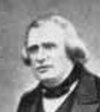 |
|
at left above), Friedrich Ernst Ludwig von Fischer (1782-1854) (photo at left below), and Carl Anton Andreevic von Meyer (1795-1855). Voznesensky, a zoologist, botanist, geologist, artist and ethnologist, was born in St. Petersburg and began his working career at the age of five as an apprentice of a type-setter in the Academy of Science printing shop. Following his interest in zoology, he became an assistant preparator at the Zoological Museum in St. Petersburg. His careful work was noticed during the museum’s 1829-1830 expedition to Caucasus, and he was appointed to lead an expedition to the Russian Far East and Russian America (Alaska and California) with the instruction to collect plant, animal and ethnographic materials. The expedition embarked from St. Petersburg in 1839 on the ship Nikolai I and collected over 400 species of new plants and animals. From the headquarters of the Russian-American Company at Sitka, he made two visits to California, one time spending 15 months, and several trips to different parts of Alaska, returning to St. Petersburg in 1849. The expedition established the world's largest collection of ethnological artifacts |
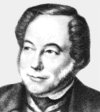 |
of Russian America. Voznesensky was not only a skilled naturalist but a talented draftsman and his penned images were detailed and artistic. His achievements were quickly recognized and he was appointed a curator of the Zoological Museum, an important position but one which prevented him from curating and publishing anything about his collection. He married in 1858 but his wife died three years later and he raised his daughter alone until his death in 1871. He was one of the founders of the Russian Entomological Association. His collections, curated finally at the Museum of Anthropology and Ethnography and Zoological Museum in St. Petersburg, continue to contribute to our knowledge of the cultural and natural history of Alaska and California. Friedrich Ernst Ludwig Fischer (1782-1854), was born in Halberstadt, Germany and was awarded a medical doctorate from the University of Halle, later working as director of Count Razumoffsky's botanical garden in Gorenki near Moscow. In 1823 he was appointed by Alexander I as director of the Imperial Botanical Garden in St. Petersburg where he established a herbarium and library, and planned numerous scientific expeditions into the interior of Russia. He retained his position there until 1850. During his final years, he served as a medical councillor for the Ministry of the Interior. He was first a corresponding member and then a foreign member of the Royal Swedish Academy of Sciences. Carl Anton Andreevic von Meyer (1795-1855), Russian botanist and explorer born in Vitebsk, Belarus, studied at the University of Dorpat (now Tartu in Estonia) under Professor Karl Friedrich von Ledebour in 1813 and 1814. He traveled with Fischer to the Crimea in 1818 and later visited the Baltic region between 1821 and 1824. JSTOR says: “In 1826 Meyer, Ledebour and Alexander von Bunge undertook a great expedition together to the Russian Altai Mountains, the Kirghiz steppe (Kazakhstan) and finally reaching Barnaul. Funded by the university, the plants collected on this trip amounted to 1,600 phanerogamic specimens and formed the basis of the Flora Altaica published by the trio in four volumes between 1829 and 1833. In 1829 he was once again collecting in the Caucasus for the Russian Empire, exploring the Mt. Elbruz region with M. Kupfler he gathered some 200 specimens and published the accompanying report the following year. Meyer was soon invited to work as a botanist for the Academy of Sciences in St. Petersburg (1835) where he began to work closely with Fischer, publishing various botanical papers and later taking over from him as director of the Imperial Botanic Garden (1850). In 1844 he had also succeeded Carl Bernhard von Trinius as director of the Academy of Sciences' Botanical Museum and was the only botanist to have held both positions. Meyer headed the garden and museum simultaneously until his death. During his life Meyer made many other important taxonomic and floristic contributions, including works on the Cruciferae and Polygonaceae and floras for Vyatka and Tambov regions.” The 'orum' ending of the specific epithet is used when there are several people being honored.
- ross'ii: named for John Ross (1777-1856), a British naval officer and polar explorer born in Balsarroch, West Gallo-
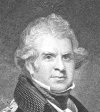 |
|
way, Scotland. His father was the Reverend Andrew Ross, minister of Inch in Wigtownshire. He joined the Royal Navy in 1786 at the age of nine and was assigned to HMS Pearl which sailed to the Mediterranean and remained there until 1789. After a brief assignment aboard HMS Impreg- nable, he transferred to the merchant marine for a period of eight years. He then was recalled to the Navy as a Midshipman aboard HMS Weazel and saw action during the Anglo-Russian invasion of Holland. Service on several different ships followed including HMS Victory, the flagship of the |
commander of the Baltic fleet. He was wounded several times by sabre and bayonet and suffered broken legs and a broken arm. He was seconded to the Swedish navy in 1808 and was promoted to Commander in 1812. One of the burning questions of the time was that of the Northwest Passage and whether it was possible to sail from the Atlantic to the Pacific across the top of North America. In 1818 Ross was appointed to command an Arctic expedition arranged by the British Admiralty. In addition to investigating the navigational route, he was also charged with the task of recording information about the currents, tides, the state of ice and magnetism, and to collect specimens he found along the way. He sailed around Baffin Bay and entered Lancaster Sound but his route to the west was apparently blocked so he returned to England. The failure of this mission did little to improve his reputation but he was promoted to Captain. After William Edward Parry, his Lieutenant on the first expedition, had sailed 600 miles further west in 1819 along the soon-to-be named Parry Channel, Ross embarked on a second expedition not sanctioned by the Admiralty in the side-wheel paddle steamer Victory along with his nephew James Clark Ross. Although he managed to reach further than anyone had previously, his transit to the west was blocked by ice late in the season of 1829 and he established winter quarters where they were assisted by a group of local Inuit. It was late in 1830 when they attempted to resume their voyage, but due to difficult ice conditions only managed to get three more miles before having to settle into quarters again for the second winter. In 1831 James Clark Ross crossed the Boothia Peninsula and became the first European to arrive at the North Magnetic Pole. Ice conditions were no better in 1831 and the ship was trapped again, with the decision being made by January 1832 to abandon Victory and proceed overland to Fury Beach where Parry’s 1824/1825 expedition had lost HMS Fury and where there were believed to be small boats and stores. Travel in the small boats was no more successful and another winter passed before late in 1833 they finally managed to be rescued and transported back to England. Only three lives had been lost and Ross’s reputation was vastly enlarged by the manner in which the expedition had been conducted. He received a knighthood and was regarded as a hero by the nation, and received gold medals from the British and French geographical societies It is almost certain that the help given by the Inuit and Ross’s willingness to learn from them was responsible in no small degree for the outcome of the expedition. In 1845/46 Sir John Franklin’s Arctic expedition in search of the Northwest Passage was icebound and had not been heard from again, so in 1850, at the age of 72, Ross undertook a third voyage to the Arctic in search of it, sailing the schooner Felix with the financial support of Lady Franklin. Regrettably no sign was found of Franklin or any of his crew. He was promoted to Rear Admiral but never sailed again, did some consulting with the government about the Baltic regions, published several pamphlets, and finally died while on a visit to London in 1856. The suggestion has been made that "rossii" was also named for James Clark Ross, but I have seen no evidence to support this. (Arenaria rossii, Carex rossii)
- ross'ii: named for Timothy Samuel Ross (1962- ), an American botanist and professor working on genomic and systematic mapping of some genera of the Brassicaceae and Rhamnaceae at the University of California, Berkeley. (Lepechinia rossii)
- rostella'ta: from the Latin rostellum, "a little beak,
a small snout," in turn from rostrum, "the beak of
a bird."
- rost'ii: named for Ernest Christian Rost (1867-1940), an artist, pioneer photographer, adventurer, and botanist born in Mount Vernon, N.Y., son of German parents, Christian Wilhelm, an engraver of renown, and Minna Rost, an embroiderer of military insignia. Rost studied at the National Academy of Design and continued his artistic education in Europe. In the late 1890s he turned to photography, working in Cuba, Puerto Rico, Guam, the Philippines, and Panama. In 1907 he married Etta N. Newbury. By 1918, he settled in California. Having failed at growing grapes in San Joaquin Valley, he moved to Alhambra and devoted his life to studies of cacti. Rost traveled widely throughout the Mojave Desert, Nevada, Mexico, and Arizona, collecting and classifying desert plants. In 1929 he became an editor of "Desert," the official publication of the American Succulent Society. In 1931 he was elected to the German Horticultural Society. In 1933 Rost sought to publish a book about cacti, but the project was never realized. (Quoted from a website entitled Social Networks and Archival Context)
- rostra'ta/rostra'tum: beaked, see next entry.
- rostriflor'us: from the Latin rostrum, "a bill, snout or beak." The name rostriflorus comes from the Latin rostrum, "a bill, snout or beak," and rostratus, "beaked," plus florus, "flowered," thus meaning "with beaked flowers," and is a good name for this species. The word 'rostrum,' originally "animal snout or bird's beak" in Latin, has a back-and-forth history. I always wondered what the connection was between a snout or beak and the place from which people orate. It turns out that the word rostrum came to be used for the battering beak or ram at a warship’s bow on triremes and other vessels used by the Romans and their adversaries. Following a battle, the Romans used beaks from captured ships to decorate a platform from which orators could speak about their victory, and that platform came to be called the rostra. By the mid-17th century, rostrum had largely come to mean a platform for speeches, performances, or receiving awards.
- rosula'ta: with leaves in a rosette, from rosula, "rosette."
- Rota'la: from the Latin rota, "wheel," and rotalis,
"wheeled, wheel-like," referring to the whorled leaves. The genus Rotala was published by Carl Linnaeus in 1771.
- roth'ii: named for Albrecht Wilhelm Roth (1757-1834), a physician and botanist born in Dötlingen, Germany. He
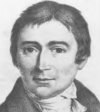 |
|
studied medicine at the Universities of Halle and Erlangen, where he received his doctorate in 1778. After graduation, he practiced medicine in Dötlingen, and shortly afterwards relocated to Vegesack near Bremen. He authored influential scientific publications, particularly in the field of botany, and came to the attention of Johann Wolfgang von Goethe, who recommended Roth to a position at the botanical institute at the University of Jena. Two of his better written works were Tentamen florae germanica (a treatise on German flora), and Novae plantarum species praesertim |
Indiae orientalis (a book of Indian flora). He was honored with the genus name Rothia. He died in Vegesack. His herbarium was deposited at the Naturhistorisch Museum zu Oldenburg and later transferred to Berlin, but was destroyed during the Second World War.
- rothrock'ii: named for Dr. Joseph Trimble Rothrock (1839-1922), a forester, professor of botany at the University of
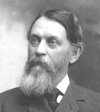 |
|
Pennsylvania and surgeon on the Wheeler Exploring Expedition of 1873-1875. He was born in McVeytown, Pennsylvania, and was a sickly child, being taken out of school and put to work on a local farm. He liked to spend time outdoors in nature and this improved his health. He earned a BS degree in botany at Harvard in 1862 where he fell under the sway of the famed Asa Gray. In 1863 he enlisted in the Union Army and fought in the major battles at Antietam and Fredericksburg, where he was seriously wounded. He left the army in 1864 and participated as botanist for the |
1865-1866 Collins Overland Telegraph Expedition in British Columbia. He received a doctor of medicine degree from the University of Pennsylvania in 1867 and began a practice in Centre County, Pennsylvania. From 1867 to 1869 he was a professor of botany, human anatomy and physiology at the Agricultural College of Pennsylvania (now Penn State). He married in 1869 and he and his wife Martha had five children, three of whom lived to adulthood. He moved to Wilkes-Barre in 1870 and helped to found the Wilkes Barre Hospital. He served as botanist and surgeon on the Wheeler Survey, a geographical and geological exploration and survey to various wild regions west of the 100th meridian under Lieut. George M. Wheeler. In 1875 he spent a week on Santa Cruz Island with several other botanists collecting plant specimens, and the following year he established the North Mountain School of Physical Culture in Luzerne County. During that same year he was appointed by the American Philosophical Society a lecturer on forestry. From 1877 to 1893 he was a professor of botany at the University of Pennsylvania. In 1880 he studied at the University of Strassburg in Germany, specializing in botany. He visited European managed forests while there. In 1886 he served as the first president of the Pennsylvania Forestry Association, and in 1895 he became Pennsylvania’s first Commissioner of Forestry, a position he held until 1904. In 1901 he was responsible for the beginnings of what would become the Mont Alto Sanatorium. He became known as "the father of Pennsylvania forestry," and was a Michaux Forestry Lecturer, editor of Forest Leaves, member of the Pennsylvania Forest Commission, and administrator of tuberculosis sanitariums. Two of his major accomplishments as commissioner were his land acquisition program and the creation of a forestry academy to train foresters for state service. He was the author of Flora of Alaska (1867) and Botany of the Wheeler Expedition (1878). (Photo credit: Find-a-Grave)
- Rottboell'ia: named for the Danish botanist Christen Friis Rottbøll (1727-1797), a Danish physician, traveller, director
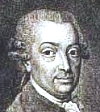 |
|
of the Copenhagen Botanic Garden and pupil of Linnaeus. He was born at Hørbygård, Denmark. He was a student of Carl Linnaeus and studied first theology and then medicine at the University of Copenhagen, taking his doctoral degree in 1755. From 1757 to 1761 he traveled to Holland and France to continue his study of medicine and also to study chemistry and botany. The latter subject he undertook at Uppsala University in Sweden. From 1761 he was at the botanic garden in Copenhagen and became its director in 1770. In 1776 he was appointed professor and the chair of |
medicine and received a title of ‘royal advisor.’ Smallpox was one of his main preoccupations and he reformed the vaccination program that was in effect in Copenhagen. He published the first comprehensive list of the flora of Greenland. The genus Rottboellia was named in 1781 by Carl Linnaeus the Younger.
- rotunda'ta: rounded, rotund, from the Latin rotundatus, "to make round," "circular in shape."
- rotundifo'lia/rotundifo'lium/rotundifo'lius:
with rounded leaves, from Latin rotundus, "round," and folium, "leaf."
- rotun'dus: rounded.
- Roubie'va: named for Guillaume Joseph Roubieu (1757-1834), a French physician, anatomist, naturalist, botanist and professor of botany at Montpellier. He studied at Montpellier obtaining his PhD in 1829. He authored a number of publications including Dessins de raisins et d'olives, Competitio ad aggregationem, De utilitate chemiae in medicina ? Quanti conferant chemiæ notiones, ad illustranda phœnomena respirationis in homine tum sano, tum ægrotante (1829), and Opuscules d’anatomie d’histoire naturelle (1816). He was president of the Société d'Histoire Naturelle de Montpellier. The genus Roubieva was published by Christian Horace Bénédict Alfred Moquin-Tandon in 1834.
- rouleauia'na: named for Joseph Albert Ernest Rouleau (1916-1991), a Canadian botanist and specialist of eastern Canadian flora, in particular that of Newfoundland. He studied under Brother Marie-Victorin, for whom he published the second, enlarged and revised edition of the Flore Laurentienne, and under Merritt Lyndon Fernald, co-author of Gray's Manual of Botany (8th edition) which he also revised. His Atlas of the Vascular Plants of the Island of Newfoundland and of the Islands of Saint-Pierre-et-Miquelon was the only comprehensive flora of either area. He died in 1991 of pneumonia.
- rowean'us: named for Edwin Denys Rowe (1881-1954). The following is from
an obituary in the the Santa Barbara News-Press, 18 March 1954:
"E.D. Rowe, chairman of the County Park Commission, a member
of the Lompoc City Planning Commission, and a veteran Santa Barbara
county horticulturist, died in his sleep early this morning at his
home. He was 73 years of age. Mr. Rowe was born Jan. 18, 1881, in
England. He attended the famous Mill Hill Public School. He served
an apprenticeship in gardening and studied agricultural chemistry
in London. At the age of 22 he went to Germany, where he spent two
years getting acquainted with advanced horticultural methods there.
Following that, he emigrated to the United States. He had planned
to spend a year here, learning about landscape gardening and business
methods before returning to England and entering business for himself.
He arrived in Ventura, California, on Christmas Eve, 1903, with $1 in his pocket,
and lived in California since that time. He came to the Santa Barbara-Montecito
area in 1904 and had charge of landscaping several large estates.
He worked for several years with Peter Riedel, well known for his
work with Franceschi Park in Santa Barbara. In 1912 Mr. Rowe went into the landscaping
business here on his own. During the depression he worked for eight
years for the National Park Service when CCC boys were brought to
Lompoc to restore La Purisima Mission. He had charge of planting the
gardens there with native California plants. The gardens are becoming
more famous every year. In his work with the restoration of La Purisima
Mission, Mr. Rowe experimented with native plants and their need for
water until the mesa above the mission has become a "forest"
of between 800 and 900 trees. These trees, which today tower 20 to
30 feet in the air, were surplus trees of from three to five inches,
left over from the Mission project. During the war years he worked
as a farm labor placement official in the Lompoc and Santa Ynez areas.
And for a time he worked on county parks, such as Santa Rosa and Nojoqui.
After the war he started his own nursery in Lompoc, where he propagated
native plants and did estate landscaping."
- roxburgh'ii: named for William Roxburgh (1715-1815), a surgeon and botanist known as the founding father of Indian botany. He was born on the Underwood estate near Craigie in Ayrshire, Scotland, and was educated at local parish schools with some additional private tutoring in Latin. Not much is known about his early childhood, but he studied medicine at Edinburgh University, graduating around 1771. In addition to mathematics and physics, he studied surgery and learned botany. In 1772 he joined the East India ship Houghton as a surgeon’s mate and also served on the Queen, traveling several times to Madras and other Indian ports, and in 1776 received his first doctorate (MD) from Edinburgh University and joined the Madras Medical Survice first as an assistant surgeon and then as surgeon. He soon became a company botanist and was appointed as superintendent of a botanical garden in Samalkot. He conducted economic botany experiments and employed native artists to illustrate the plants. In 1790 he was awarded a second doctorate from Marischal College in Aberdeen, and became naturalist to the Madras government and then superintendent of the Calcutta Botanical Garden. He provided illustrations for Sir Joseph Banks’ 3-volume Plants of the Coast of Coromandel, and sent numerous plant specimens back to Kew. Beyond botany he was a prodigious collector of meteorological data and contributed many valuable papers for the Transactions of Asiatic Society. In 1791 he was elected a fellow of the Royal Society of Edinburgh, and in 1799 he was elected a fellow of the Linnean Society. He also contributed to the flora of St. Helena and spent time at the Cape of Good Hope from whence he sent major collections of Proteaceae and Ericaceae to Britain. He returned to Scotland in ill health in 1813 and died two years later in Edinburgh. His Flora Indica; or Descriptions of Indian Plants was published posthumously in two volumes by William Carey, founder of Serampore University, in 1820 and 1824. He was married three times, each time to a woman named Mary.
- roy'ae: named for Jesse Dalrymple Gregg (Mrs. William Roy) (1813-1889), a native of Ireland of Scottish descent who grew up in Aberdeen. As a child she had good education in science particularly botany. It’s not certain when she arrived in Canada, but she and her husband lived for a time in Montreal where he and his brother were successful dry goods merchants. Later, in 1863 they moved to Brantford in the Owen Sound area north of Lake Erie in Ontario. Her husband became a successful fruit grower and became a well-known member of the Fruit Growers’ Association of Ontario. By the 1860s Roy had done considerable botanizing around the Owen Sound area specializing in ferns and mosses, and had discovered a number of rare ferns. The Owen Sound area was known to botanists because of its rare plant species, and is today included in a UNESCO World Biosphere Reserve classification. Her brother, William Gregg, was at the time superintendent of a large market in Lodi, New Jersey, and while visiting him, Jesse apparently met Coe Finch Austin who was one of the leading American bryologists of the time and who had received specimens from her and facilitated contact between her and other notable botanists. In the summer of 1871 the Roys invited the noted botanist John Macoun to visit them at Owen Sound and Roy collected with him both during that visit and again in 1874. Specimens were sent to Thomas Potts James at Harvard who was working with Leo Lesquereux on their Manual of the Mosses of North America. Sereno Watson, also at Harvard, was given a set of specimens from the Owen Sound area. In 1873 she made a trip to Europe and gathered specimens from Scotland and Switzerland. Roy’s collecting continued through the 1870s and early 1880s.
- roy'lei: named for John Forbes Royle (1798-1858), a British botanist and teacher of materia medica, born in Cawn-
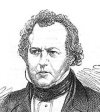 |
|
pore, India. He attended Edinburgh High School and the East India Company’s military academy at Addiscombe where he came under the influence of physician Anthony Todd Thomson. He was interested in botany and natural history and decided to study medicine. He joined the service of the East India Company as assistant surgeon and went to Calcutta in 1819. He served with the Bengal army at Dum-Dum and in parts of the North-Western Provinces where he found time to study botany and geology, and made large collections from the Himalayas. In 1823 Royle was appointed |
as superintendent of the botanical garden at Saharanpur which had been established by the East India Company in 1750 with the aim of promoting the introduction of new crops of commercial value. One of Royle's major interests was in the traditional botanical remedies used by Hindu medical practitioners based on which he would later write On the Antiquity of Hindu Medicine (1837). He held that position until 1831 after which he resigned and returned to England. He brought back large collections of medicinal and economical plants, and his specialization in Indian drug plants led to his appointment as professor of materia medica at King's College where he remained until 1856. He was elected a fellow of the Royal Society (1837) and secretary (1837-1858) of the Horticultural Society of London (later the Royal Horticultural Society). He also acted as secretary to the Geological Society. He became a fellow of the Linnean Society in 1833 and published Illustrations of the Botany and Other Branches of the Natural History of the Himalayan Mountains, and of the Flora of Cashmere in two volumes in 1839. In 1851 he was superintendent of the Indian department of the Great Exhibition of the Works of Industry of All Nations, sometimes referred to as the Crystal Palace Exhibition. He was also the author of On the Culture and Commerce of Cotton in India and Elsewhere (1851) and The Fibrous Plants of India fitted for Cordage (1855). He married Annette Solly in 1837 and had a daughter and three sons. In addition to his collecting in India and Nepal, he also collected in South Africa while journeying between England and India. His studies of Indian medicine led him to the belief that it had much in common with that of ancient Greece. He died at Acton near London. The genus Roylea was named in his honor.
- rubel'la/rubel'lum/rubel'lus: pale red, becoming red.
- ru'bens: red.
- ru'ber: see rubra below.
- rubes'cens: becoming red or reddish.
- rubicun'da: from the Latin rubicundus for "rubicund,
red."
- rubicun'dula: reddish.
- rubigino'sum: possibly having reddish brown hairs on the plant parts or a reddish brown color, from the Latin rubiginosus, meaning "rusty red."
- rubisep'alum: with reddish sepals.
- ru'bra/ru'brum: from the Latin ruber or rubra meaning
"red."
- rubriflor'us: red-flowered.
- Ru'bus: a Latin name for "bramble"
or "blackberry" from ruber, "red." The genus Rubus is a large and complex group that was published by Carl Linnaeus in 1753. It likely has a North American origin with fossils known from the Eocene-aged Florissant Formation of Colorado. Rubus expanded into Eurasia, South America, and Oceania during the Miocene. The genus Rubus was published by Carl Linnaeus in 1753 and is called blackberry, raspberry, dewberry, wineberry and bramble.
- Rudbeck'ia: named for Swedish professor of botany and advisor and mentor of Carl Linnaeus, Olaus (Olof) Olai
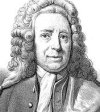 |
|
Rudbeck (1660-1740), Rudbeck the Younger (photo at top left), and for his father Olaus (Olof) Johannis Rudbeck (1630-1702) (photo at bottom left), Rudbeck the Elder. Rudbeck the Younger was a physician, a keen ornithologist, and a professor of anatomy as well as botany at Uppsala University, a position he took over from his father, and was the author of De fundamentali plantarum notitia. He was the botany professor of Carl Linnaeus. He specialized in anatomy, botany, zoology, and pharmacology. Later in his life he turned his attention to the study of languages. His sister, Wendela, married Peter Olai Nobelius from whom was descended Alfred Nobel of the Nobel Prize fame. Rudbeck the Younger was born in Uppsala who traveled abroad as a youth for several years, was taught botany and anatomy by his father and and aided him in the organisation of his Campus Elysii (an ambitious project to describe and illustrate all plants known at the time, which was unfortunately largely destroyed in the great fire of Uppsala in 1702), published his doctoral thesis Propagato Plantarum botanico-physica in 1686, and got his doctor’s degree in Utrecht in |
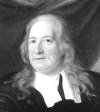 |
1690. Succeeding his father as chair of botany and medicine at Uppsala University in 1692, he remained in this position until his death in 1740. He traveled to Lapland in 1695, joining an expedition commissioned by the King, for which his mission was to study nature, the mountains in particular. He returned with an impressive album of colored plant and bird illustrations but regrettably his manuscripts and collections were all but destroyed in the same fire in 1702 that took his father’s Campus Elysii. He had 24 children with three different wives. His son Johan Olof Rudbeck (1711-1790) became a well-known natural scientist. Rudbeck the Elder was born in Västerås and graduated from Uppsala University in 1648. He traveled to Holland in 1653 and it was in the botanical garden at Leiden that his love of botany was born. With the seeds and plants he brought back from Holland, he established the first botanical garden in Sweden at Uppsala, which was originally called Rudbeck's Garden but was renamed a century later for Linnaeus. He became a professor of medicine at Uppsala University in 1660 and was for several periods rector magnificus of the same university. Wikipedia says: “Rudbeck's research led to the Queen's support of his career. To facilitate his studies of human anatomy, he had a cupola built on top of Gustavianum, a university edifice, and in it was built an arena-like Theatrum anatomicum, where dissection could be carried out in front of students. The cupola still remains and is a landmark in Uppsala. The "Gustavianum" stands in front of the cathedral, and is still part of the university.” Rudbeck is known mainly for his contributions in the fields of human anatomy and linguistics, but he was also accomplished in many other fields including astronomy, music and botany. Over a 20-year period he wrote a massive 2,500-page tome in four volumes called Atlantica purporting to prove that Sweden was the historical Atlantis and that Swedish or Sami was the original language of the Bible's Adam from which Hebrew was descended. He was also one of the pioneers in the study of lymphatic vessels. Al Schneider sent me a quote from Wilfrid Blunt’s The Compleat Naturalist: A Life of Linnaeus which he has in his wonderful website "Wildflowers, Ferns and Trees of Colorado, New Mexico, Arizona and Utah": “So long as the earth shall survive and as each spring shall see it covered with flowers, the Rudbeckia will preserve your glorious name. I have chosen a noble plant in order to recall your merits and the services you have rendered, a tall one to give an idea of your stature, and I wanted it to be one which branched and which flowered and fruited freely, to show that you cultivated not only the sciences but also the humanities. Its rayed flowers will bear witness that you shone among savants like the sun among the stars; its perennial roots will remind us that each year sees you live again through new works. Pride of our gardens, the Rudbeckia will be cultivated throughout Europe and in distant lands where your revered name must long have been known. Accept this plant, not for what it is but for what it will become when it bears your name.” This was in a letter which Linnaeus sent to his mentor Rudbeck, and I think is evidence that Linneaus originally at least intended the name to honor Rudbeck the Younger. However in Hortus Cliffortianus, published in 1737, Linnaeus says: "I have named plants of this genus [Rudbeckia] for the most noble Rudbecks, their knowledge of genera renowned throughout the world." The genus has been called yellow coneflower or black-eyed susan.
-
rudera'le: of waste places, of rubbish or disturbed sites. The term ruderal originates from the Latin word rudus, meaning "rubble". A ruderal species is a plant species that is first to colonize disturbed lands. The disturbance may be natural – for example, wildfires or avalanches – or the consequences of human activities, such as construction (of roads, of buildings, mining, etc.) or agriculture (abandoned fields, irrigation, etc.).
- ru'dis: rough, untilled, coarse, from Proto-Indo-European hrew-, "to tear up, dig up."
- ruell'ii: named for Jean Ruel (1479-1537) (aka Jean de la Ruelle or Jean du Ruel), physician and one of the earliest French botanists. He was physician to Francis I and a translator of Dioscorides. He went on plant-hunting expeditions and questioned peasants and mountaineers about the vernacular names they used for their local flora. These names he incorporated into his major work, De Natura stirpium libri tres, published in Paris in 1536 and based on the works of Theophrastus and Pliny, in which he described about 600 plants. He was also regent of the faculty of medicine of Paris and became the canon of Notre Dame. The genus Ruellia was dedicated in his honor by Charles Plumier.
- rufid'ula: somewhat red or reddish. The taxon Saxifraga rufidula is called rusty-haired saxifrage.
- rugel'ii: named for Ferdinand Ignatius Xavier Rugel (1806-1879), a German-born American botanical explorer, farmer, pharmacist, plant collector and surgeon. JSTOR provides the following: “Ferdinand Rugel was born in Ravensburg in Württemberg, Germany. Later working in this city as a pharmacist in his own right, he met British botanist R.J. Shuttleworth and they developed a close working relationship. Rugel began to collect, both for himself and for Shuttleworth to sell, and gathered plant specimens extensively in France and Switzerland. In 1838-1839 he undertook botanizing trips to the eastern Pyrenees and the Piedmont region of northern Italy, advertising the plants he had gathered for sale in Flora in 1840. Through his association with Shuttleworth, Rugel traveled to the USA in 1840 and explored the southern Appalachian Mountains. Collecting in Portsmouth, Virginia, and the mountains of North Carolina, he moved on to Jefferson County, Tennessee. In 1843 he botanized in southern Alabama and the north of Florida. Originally intending to spend only a few years in America, Rugel married Laura Bell in 1845 and they settled near Dandridge, Tennessee, bringing up a total of 12 children. He continued his botanical collecting, still sending specimens back to Shuttleworth for sale in Europe, and worked as a pharmacist and physician in between these excursions. Rugel visited Florida again in 1846, Georgia and the banks of the Altamaha in 1848 and in 1849 even collected in Cuba, particularly in Matanzas Province. In 1849 he moved to Knoxville and worked for many years for a wholesale drug firm. At this time his collecting subsided somewhat and his excursions took him no further than the Great Smoky Mountains of eastern Tennessee, save for one trip in 1878 to Austin County, Travis County and Dallas County in Texas.” He died in Jefferson County, Tennessee.
- rugo'sa/rugo'sum: from Latin rugosus, "wrinkled."
- rugulo'sus: slightly wrinkled.
- Ru'mex: the ancient Latin name for the docks
or sorrels. The genus Rumex was published by Carl Linnaeus in 1753.
- runcina'ta: saw-toothed, with the teeth pointing toward the base, from the Latin runcinatus, "a carpenters plane," referring to a pinnately cut leaf with the lobes pointing downwards, as with the leaf of a dandelion.
- runyon'ii: named for Robert Runyon (1881-1968), an American photographer, botanist, and politician born on a farm
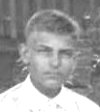 |
|
near Catlettsburg, Kentucky. He had a limited formal education that did not extend through high school and was largely self-taught. He married Nora Young in 1901 and worked as an insurance salesman in Ashland, Kentucky. After his wife died in 1908, he traveled to New Orleans and Houston in search of work. The Gulf Coast News and Hotel Company hired him to sell fruit, candy, sandwiches, and cigarettes to railway passengers in early 1909 and a few months later he became the manager of Gulf Coast's lunchroom and curio shop in the Brownsville train station. From then |
until his death in 1968 he lived in Brownsville. In 1910 he went back to Kentucky to take his only son William with him to Texas, and in 1913 he married Amelia Leonor Medrano Longoria with whom he had five more children. Until 1926 he worked as a commercial photographer, recording urban life in the Rio Grande Valley, and the region’s people and culture, and in 1913 became interested in the Mexican Revolution, actually following Mexican forces and witnessing military actions. He also photographed the Brownsville Fort Brown as the United States began mobilizing for its entry into World War I. Wikipedia adds: “Beginning in the late 1920s, Runyon became a successful amateur botanist, discovering several new species and accumulating a massive private herbarium. He wrote Texas Cacti: A Popular and Scientific Account of the Cacti Native of Texas with Ellen Schulz Quillin (1930) and Vernacular Names of Plants Indigenous to the Lower Rio Grande Valley in (1947). A third book, An Annotated List of the Flora of the Lower Rio Grande Valley, went unpublished due to his death. Runyon was a charter member of the Cactus and Succulent Society of America and served as its regional vice president in 1942 and fellow in 1945. He was also involved in the Texas Academy of Science, the Botanical Society of America, the Torrey Botanical Club, the American Society of Plant Taxonomists, and the International Association for Plant Taxonomy.” He also became involved in politics, becoming Brownsville city manager in 1937, mayor in 1941, and aide-de-camp on the staff of the governor of Kentucky in 1949. He made an unsuccessful run for the Texas House of Representatives in 1952 and died at the age of 86 in 1968. (Photo credit: Find-a-Grave)
- Rupal'leya: named for Louis Jules Rupalley (1810-1871), an artist best known for flora and fauna, landscape, figure, and genre painting. He was born in Caen, France, the son of an attorney for the Court of Appeals and later deputy mayor. He arrived in San Francisco at the time of the gold rush aboard the ship Louis in 1851. He lived in Benicia and Vallejo and spent several years in Stockton, and in addition to possibly prospecting for gold, he became an avid botanist. He remained in northern California until 1857 when he returned to Caen where he became a tax collector for the city. Most of his watercolors and sketches are of flora and fauna in the Sierras and around the Stanislaus and Tuolumne Rivers. Dr. Claudine Chalmers, a specialist on the French in gold rush California, wrote the following on an unidentified website online (that may have disappeared on the internet): "Like tens of thousands of his compatriots, Rupalley had fled political chaos at home - as well as a wife and a two-year-old son - for the California gold fields. In 1850 he had joined Le Mineur, one of the Paris-based immigration companies organized to transport Frenchmen to California and to speculate in gold. Jules was, however, no ordinary adventurer. He came from a well-to-do, enterprising family of Normandy. Though his father was a solicitor practicing before the court of appeal in Caen, Jules followed in the footsteps of a grandfather who had mined in Serbia. An avid traveler, Jules was also a devoted botanist and amateur artist. During the tedious six-months voyage on the ship Le Louis from France around Cape Horn to E1 Dorado, this gold-seeker started a pictorial record of his voyage. Ultimately, it would cover inland California journeys and botanical observations. For a while Jules worked as a painter and decorator at the Frémont House at the base of Telegraph Hill. Then his itinerary took him to Benicia, Vallejo, and then to the northern mines, where he spent some time in the boomtown of Greenwood Valley. Originally called "Long Valley," the site was renamed for John Greenwood, son of the famous trapper and guide Caleb Greenwood. In 1857, Jules Rupalley went home to his family and settled into a quieter life. With him went a sketch book with close to a hundred drawings of California plants and insects, besides Gold Rush scenes, and some more tangible items. Six years later, M. J. Morière, a professor at the University of Caen, wrote, "For several years now, we have been watching the flowering at the home of one of our friends, M.G. Rupalley, a merchant of Caen, of a Liliaceae from a bulb sent to him by his brother [Jules], together with various seeds gathered in California. We have not found any description of this plant in the floras at our disposal. Our research at the Museum of Paris and questions asked collectors of exotic plants, lead us to believe that this plant is unknown in France. We decided it would be useful to have a drawing made of it and to publish its description." In 1863, Professor Morière honored its discoverer with the name Volubilis Rupalleya. She goes on to say that its botanical name was subsequently changed first to Brodiaea volubilis by John Torrey and then to Dichelostemma volubilis in Willis Linn Jepson's Manual of the Flowering Plants of California. The genus Rupalleya in the Liliaceae was published by Pierre Gilles Morière in 1864.
- Ruper'tia: named for Rupert Charles Barneby (1911-2000), a self-taught botanist who was acclaimed as one of the
 |
|
world’s leading taxonomists and a world expert in Fabaceae and Menispermaceae. He was born in Monmouthshire, England, and was educated at Harrow (1924-1929), where he met the aspiring fellow botanist Harry Dwight Dillon Ripley (1908-1973) (see ripleyi), who became his lifelong partner. He went on to Trinity College, Cambridge University (1930-1932), where he received his BA in history and modern languages in 1932. After graduating his father threatened to disinherit him if he did not relinquish his relationship with Ripley. He never saw his father again. Early on |
the two men collected widely in the Mediterranean and North Africa, returning with many live plants for their garden at Sussex. He came with Ripley to the United States first in 1936, with the intention of collecting in Mexico as a substitute for Spain which was then embroiled in civil war, but never made it to the Mexican border. They returned to California in 1937 and the following year established a holding garden for their collections from Death Valley and Titus Canyon. In 1939 they moved permanently to the US, settling in Los Angeles, and beginning systematically to search out and identify plants of the western United States and Mexico. Barneby established permanent residency in 1941, and from then until 1953 they collected together, although they moved their home to Wappingers Falls, New York, in 1943, Ripley in particular being attracted to the art scene there. Both at their home there and at the home they moved to in 1959 at Greenport, NY, they established renowned rock gardens filled with plants from the Southwest. Throughout most of the 1950s and 1960s Barneby collected by himself (although he and Ripley typically made an annual collecting trip out west), and then after 1971 with Noel and Patricia Holmgren. Ripley died in 1973 and Barneby continued this practice and made his last trip at the age of 81. In 1978 he was awarded an honorary doctorate from City University of New York. He had begun his long association with the New York Botanical Garden as early as 1943 and then became a visiting scholar and a research associate. He was appointed honorary curator of western botany in 1980, and became an editorial consultant for Brittonia, the garden's esteemed scientific journal covering systematic botany. The president of the NYBG described him as "one of the most productive botanists of the twentieth century, a giant in the field of botanical research." Over the course of his career, he published more than 6,500 pages of papers, monographs and journals, describing over 1,100 species new to science, being honored with 25 species and three genera being named for him. He was a self-taught botanist who was one of America's leading taxonomists. He was exceptionally well-liked and loved to mentor his students and indeed anyone who wished to learn. He was honored with the genus name Rupertia, published by James Walter Grimes in 1990. The following is quoted from the Botanical Electronic News, No. 261, December, 2000: "Dr. Rupert Charles Barneby, curator emeritus in The New York Botanical Garden's Institute of Systematic Botany and one of the Garden's most senior and distinguished scientists, died Tuesday, December 5. He was 89 years old. He spent his career at the garden curating and studying the world's best collection of New World Leguminosae. Gregory Long, president of The New York Botanical Garden, said, 'Rupert Barneby was one of the most productive botanists of the twentieth century, a giant in the field of botanical research. Over the last half century, he has been an inspiring mentor, a meticulous scholar, and a creative editor who has made an enormous contribution to the botanical world. We at The New York Botanical Garden are indeed fortunate that his kind, generous, gentle manner graced our lives.' In 1999, the International Botanical Congress presented Barneby with its prestigious Millennium Botany Award for a lifetime of contribution to science. In 1980, he was the winner of the Henry Allan Gleason Award, an annual award from The New York Botanical Garden for an outstanding recent publication in the field of plant taxonomy, plant ecology, or plant geography. In 1989, the American Society of Plant Taxonomists awarded Barneby with the Asa Gray Award for his contributions to systematic botany. In 1991 the garden honored Barneby by institutionalizing his legacy through the establishment of the Rupert C. Barneby Fund for Research in Legume Systematics. The Engler Silver Medal, botanical science's highest honor for publications, was awarded to Barneby in 1992 for his monographic work Sensitivae Censitae: A Revision of the Genus Mimosa Linnaeus (Mimosaceae) in the New World. Since the publication of his first botanical paper in 1941, Barneby published more than 6,500 pages of papers, monographs, and journals. 'Rupert Barneby was an incredible scholar and one of the nicest people I have known. He was one of the most productive and erudite students of botany and horticulture on the staff of The New York Botanical Garden in its 109-year history. He will be remembered by thousands of colleagues for his uncommon generosity in sharing his inexhaustible knowledge and precise editorial skills. He has left an authoritative legacy of publications and will be sorely missed by botanists around the world,' said Professor Sir Ghillean Prance FRS, VMH, the former director of the Royal Botanic Gardens, Kew. Barneby was a member of the American Society of Plant Taxonomists, the International Association for Plant Taxonomy, and the New England Botanical Club, and a fellow of the California Academy of Sciences. 'Rupert Barneby was a great student of plants in the style of George Bentham and the other encyclopedic workers of the nineteenth century, who would tirelessly analyze all we knew about enormous groups of plants and reduce that knowledge to lucid prose, working day after day, month after month, and year after year. He always had time to encourage and help students and colleagues, giving them the benefit of his extraordinary classical education, friendly personality, and love for plants. He will be greatly missed,' said Dr. Peter Raven, director of the Missouri Botanical Garden and close friend and colleague." The genus Rupertia was published by James Walter Grimes in 1990. (Photo credit: LuEsther T. Mertz Library/The New York Botanical Garden)
- rupes'tris: growing among rocks, from Latin rupes, "rock," and -estris, a Latin adjectival suffix that signifies "belonging
to," "loving," or "living in" (e.g. alpestris,
"of the mountains," from alpestre, "pertaining to the Alps"; rupestris, "rock-loving,"
from rupis, "a rock"; sylvestris, "of the woods,"
from sylva, "a wood;" terrestris, "of the earth," from terra, "earth").
- rupico'la: growing
on ledges or cliffs, from Latin rupes, "rock or cliff," and -cola, a suffix conveying a very similar meaning to the one in the previous entry as in eremicola, "living in solitary places," deserticola, "living in the desert," arenicola, "living in sandy places," pratericola, "living in meadows," calcicola, "living in carbonate soils, etc.
- rupifra'gum: rock breaking, i.e. growing in rock crevices.
- rupi'num: from the Latin rupes, "rock,"
thus referring in some way to rocks, perhaps suggesting that as a
habitat.
- ruppel'ii: named for Wilhelm Peter Eduard Simon Rüppell (1794-1884), a German naturalist and explorer born at
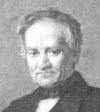 |
|
Frankfurt-am-Main the son of a wealthy banker. I don’t know much about his early education but he attended lectures at the University of Pavia and University of Genoa in botany and zoology. He was apparently on course to be a merchant but visited the Sinai and ascended the Nile to Aswan in 1817 and developed an interest in natural history. He attended university in Pavia and Genoa, Italy, before embarking on his first expedition in 1821. The following is quoted from Wikipedia: “Assisted by surgeon Michael Hey, Rüppell returned to Sinai, proceeding through the desert to |
reach the Gulf of Aqaba. Rüppell and Hey were reportedly the first Europeans to travel to Aqaba. The pair then explored Nubia and Kordofan (Sudan) and Arabia, before their travels were curtailed by illness in 1827. They had planned to make their way through Abyssinia (Ethiopia), but decided to return to Europe for the sake of their health. On his return, Rüppell published Reisen in Nubien, Kordofan und dem peträischen Arabien (1829), based on his experiences. Rüppell realised his ambition to explore Abyssinia in 1830, this time managing to spend three years in the region. During this expedition he investigated in particular the flora and fauna of Eritrea, the Semen Mountains and central Gondar (Begemder). He also concerned himself with the culture and history of Abyssinia, making significant collections of anthropological artefacts. The Gondar judge and scholar Liq Atqum was especially helpful to Rüppell, who incorporated much of what he learnt from Atqum into his account of his time in Ethiopia, Reise in Abyssinien (1838-1840). In Frankfurt once more, Rüppel co-founded the Senckenburg Natural History Society, of which he served as director, while his plant collections were studied by Johann Baptist Georg Wolfgang Fresenius, resulting in the description of many new taxa. In recognition of his achievements, the Royal Geographical Society of London awarded Rüppell its Gold Medal in 1839. Rüppell made a final journey to Africa in 1849-1850, adding further material to his previous collections, which formed the basis of the Senckenberg Museum in Frankfurt. In his later life he later turned his attentions to numismatics. He briefly left Frankfurt for Zurich after the Prussian annexation of his home in 1866, but returned in 1870 and remained there the rest of his life.” In addition to plants, he had bats, a chameleon, a fox, a skink, and a number of birds named for him. In 1845, he published a book on the taxonomy of North-West African birds, Systematische Übersicht der Vögel Nord-Ost-Afrika's, where he described 532 species.
- Rup'pia: named for Heinrich Bernhard Rupp (or Ruppius) (1688-1719), a German botanist and writer. He was born in Giessen and first studied medicine in 1704. He met Johann Jacob Dillenius and studied in Jena in 1711, in Leiden in 1712, and then again in Jena in 1713. He wrote a flora entitled Flora jenensis about plants around Jena and part of Thuringia. The first two parts were published, but the work was finished after his death by Albrecht von Haller. The genus Ruppia was published by Carl Linnaeus in 1753.
- rus'byi: named for Henry Hurd Rusby (1855-1940). The following is quoted
from a website of the New
York
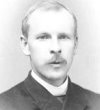 |
|
Botanical Garden: "Henry Hurd Rusby (1855-1940) was
influential in promoting the study of economic botany at The New York
Botanical Garden throughout the first fifty years of its existence.
As a youth growing up in Franklin (now Nutley), New Jersey, Rusby
demonstrated a passionate interest in plants. At the age of 21 his
personal herbarium won him first prize at the Centennial Exposition
in Philadelphia in 1876. At that time he became acquainted with Dr.
George Thurber, who was the president of the Torrey Botanical Club.
Rusby joined the Torrey Botanical |
Club in 1879 and around that time
began studying medicine at the Medical College of New York University.
In 1880, while still a medical student, he spent 18 months collecting
plants in Texas and New Mexico as an agent for the Smithsonian Institution.
In 1883 he returned to the southwest to study and collect medicinal
flora of Arizona for Parke, Davis & Co. Rusby graduated from medical
school in 1884 and in 1885 he embarked on a two-year excursion for
Parke, Davis & Co., traversing the South American continent and
exploring remote regions of Colombia, Ecuador, Peru, Chile, Bolivia,
and Brazil. Although trained as a physician, Rusby chose to forego
medicine in favor of his interest in plants. In 1889 he was made professor
of botany and materia medica at the College of Pharmacy at Columbia
University. He served 26 years as dean of the faculty until his retirement
in 1930, and as dean emeritus until his death in 1940. Rusby's association
with The New York Botanical Garden began even before the garden was
formally established. As a member of the Torrey Botanical Club, he
met Nathaniel Lord Britton. It had long been a goal of the club to
establish a botanic garden. In 1888 a botanic garden committee of
eight distinguished club members, including Britton and Rusby, was
formed. Rusby is listed among the numerous incorporators and was instrumental
in arranging to have the Columbia College herbarium and botanical
library deposited at the garden. In 1898 Rusby was appointed honorary
curator of the Economic Botany Museum and served on the board of managers
until 1933. Rusby's neotropical explorations, particularly in the
Amazon region set the precedent for the systematic and economic botany
that has characterized subsequent research at The New York Botanical
Garden. The productivity of his trips was due to his endurance and
resourcefulness as an explorer. In 1921, when Rusby was 65 years old,
he embarked on his last field trip to South America as the director
of the Mulford Biological Exploration of the Amazon Basin. Henry Rusby
died on November 18, 1940, at the age of 85." (Photo credit: Alchetron)
- russow'ii: named for Edmund August Friedrich Russow (1841-1897), a Baltic German biologist born in Tallinn
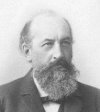 |
|
in present-day Estonia. He was the son of a military engineer and studied at the Universities of Tartu and Berlin. He became an associate professor and then a full professor at Dorpat. In 1895-97 he was president of the Estonian Naturalists' Society. Russow was at the forefront of nature conservation in Estonia, and associated with the work of Hugo Conwentz, a founder of nature conservation efforts throughout Europe. He was an authority on the Sphagnaceae (sphagnum mosses) and remembered for his research in plant anatomy and histology, in particular studies of |
the plant family Marsileaceae (aquatic and semi-aquatic ferns). He died in Tartu.
- rustica'na: pertaining to the country, from rusticus, "of the country, rural, rustic."
- rustvold'ii: named for Edward Burton Rustvold, III (1947-2020), an expert in California Liliales and Asparagales who had over 30 years of experience propagating fritillaries. He was regarded as a California native bulb propagation expert, and had growing and comparing geophytes in his home nursery in the San Francisco Bay area for many years.
- Ru'ta: the classical Latin name for the rue plant derived from Greek. The genus Ruta was published by Carl Linnaeus in 1753.
- ru'tila: reddish, golden red. reddish-yellow, feminine form of the Latin adjective rutilus, "a warm or yellowish red color, ruddy."
- ruygt'ii: named for botanist Jake A. Ruygt (1952- ), a member of the Land
Trust of Napa County and co-compiler of A Flora of Napa County and 100 Napa County Roadside Wildflowers. His entry on Calphotos says "I am a landscape contractor and consulting botanist. I live in Napa. I am an amateur photographer. I have been studying the flora of Napa County since 1976 and have a collection of slides and digital images of plants and habitats." He maintains the Jake A. Ruygt Garden Maintence Co. in Napa. He received the Napa County Landtrust's 2018 Acre by Acre Award, presented at the Cornerstone Society.
- ryan'ii: named for Frederick J. Ryan (1943?- ) who worked at UC Davis and the USDA Agricultural Research Service in Fresno and Parler. He has done work on genetic marker for fruit characteristics in plant breeding, aquatic plant physiology and management, the effect on fruit quality and toxicity of fumigation treatments, and hybridization among Russian thistle species.
- rydbergia'na/Rydbergiel'la/rydberg'ii: named for Per Axel Rydberg
(1860-1931), a member of the New York Botanical
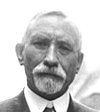 |
|
Garden in the late 19th and early 20th centuries, who wrote the first book on the flora
of the Rockies from Canada to Mexico, and several other floras. "P.
A. (Per Axel) Rydberg, the first curator of the New York Botanical
Garden Herbarium, was a plant taxonomist whose specialty was the flora
of the Rocky Mountains and Great Plains areas. He began working for
the New York Botanical Garden in the summer of 1897 as a member of
the first garden field expedition, and joined the permanent staff
in 1899 when they were first organized. In the course of his career,
he |
was to publish over 7,000 pages of research, making him one of
the most productive scientists at the New York Botanical Garden. Born
in Sweden, Rydberg emigrated to America in 1882. He first worked in
the iron mines of Michigan where he hoped to become a mining engineer
but he suffered a serious accident which left him with a lifelong
limp and forced him to turn to intellectual pursuits. From 1884 to
1890, he taught mathematics at Luther Academy in Wahoo, Nebraska,
while he studied at the University of Nebraska. He received his BS
in 1891, and the strong influence of his botany professor, Charles
Edwin Bessey, helped to determine his lifelong devotion to plant studies.
Soon after he graduated, Rydberg received a commission from the United
States Department of Agriculture to undertake a botanical exploration
of western Nebraska. He received another one in 1892 to explore the
Black Hills of South Dakota, and in 1893 he was in the Sand Hills,
again in western Nebraska. During this time he continued to teach
at the Luther Academy. In 1895, Rydberg received his MA from the
University of Nebraska. The university published his monograph on Rosales,
one of only three parts published of a projected 25-part series on
the flora of Nebraska. That summer, he was collecting once again for
the United States Department of Agriculture in Montana with Cornelius
Lott Shear. When autumn arrived, he moved to New York to pursue a
PhD degree at Columbia University under the guidance of Nathaniel
Lord Britton. During this time he also was teaching natural sciences
and mathematics at the Upsala Institute (later Upsala College) in
Brooklyn and in Kenilworth, New Jersey. In the summer of 1897 he was
sent to collect in Montana and the Yellowstone Park region with Ernst
Athearn Bessey, son of his mentor Charles Edwin Bessey. The two men
were part of the first field program expedition of the New York Botanical
Garden. Dr. Rydberg received his PhD in 1898 and during that summer
was employed once again by the garden to process the collections obtained
from the Montana and Yellowstone park expedition. Early in 1899, the
garden organized its first permanent staff and he became one of the
nine original members. His title initially was assistant curator and
this was changed in 1908 to curator of the herbarium. He would hold
that title until his death in 1931. In 1900 Dr. Rydberg conducted
field work in southeast Colorado with King Vreeland. In 1901 he visited
Kew Gardens in England and made a return trip to Sweden as well. In
1905 he was collecting in Utah with visits to the University of Wyoming,
Los Angeles, and San Francisco. In 1911 he undertook an exploration
of southeast Utah with Albert Osbun Garrett and in 1925, the Allegheny
Mountains with John Tuttle Perry. A trip in 1926 took him to Minnesota,
Iowa, Nebraska, Kansas, and the Dakotas. His final field expedition
was in 1929 to Kansas and Minnesota but it was cut short due to illness
and only included work in Kansas. Dr. Rydberg was elected to membership
in the Torrey Botanical Club in 1896. In 1900 he joined the American
Association for the Advancement of Science and was elected a fellow
the following year. Also that year, he was chosen as an associate
of the Botanical Society of America. In 1907 he became a member of
the American Geographical Society and the Ecological Society of America.
The family of Dr. Rydberg destroyed most of his personal papers at
the time of his death. The few that remain consist of miscellaneous
correspondence and research notes, along with the manuscript proofs
for several papers and publications, including his dissertation, Monograph
of the North American Potentilleae, and the first edition of one of
his most well-known works, Flora of the Rocky Mountains. Also included
in this collection are a group of research materials related to the
publication of a bio-bibliography of Dr. Rydberg written by Arnold
Tiehm. This appeared under the title Per Axel Rydberg: a biography,
bibliography and list of his taxa. It was published in 1990 as volume
58 of the series Memoirs of the New York Botanical Garden. Dr. Rydberg’s
field notebooks have been removed to the Collectors’ Field Notebooks
series." (Quoted from a website of the New
York Botanical Garden) (Photo credit: University of Maryland)
- ryszard'ii: named for Polish bryologist Ryszard Ochyra (1949- ), botanist, university teacher, and co-author of The Illustrated Moss Flora of Antarctica. He also researched Arctic mosses. Wikipedia says: "Between 1978 and 2000 R. Ochyra co-edited and distributed five bryophyte exsiccata series.In 1986, botanist Jiří Váňa and (mycologist) circumscribed Ochyraea, which is a genus of mosses in the family Amblystegiaceae and named in Rysard's honor." He was employed at the Władysław Szafer Institute of Botany.
- Rytidosper'ma: wrinked seed, from the Greek rhytis or rhytidos, "a
wrinkle," and sperma, "a seed." The genus Rytidosperma was published by Ernst Gottlieb von Steudel in 1855.
|
